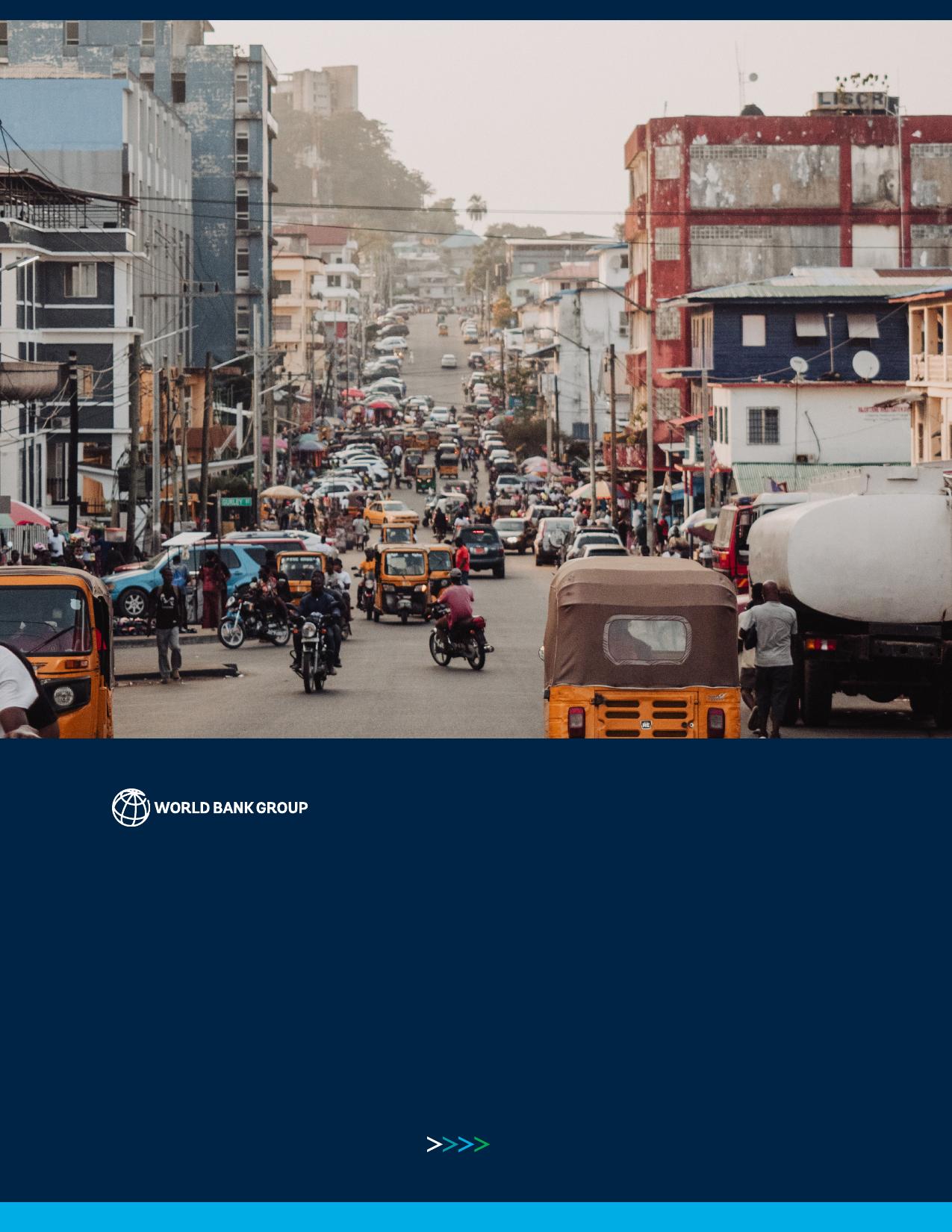PublicDisclosureAuthorizedPublicDisclosureAuthorizedPublicDisclosureAuthorizedPublicDisclosureAuthorizedDecarbonizingUrbanTransportforDevelopmentBiancaBianchiAlvesLamaBouMjahedJoannaMoodyMobilityandTransportConnectivitySeries©2023TransportGlobalPracticeInternationalBankforReconstructionandDevelopment/TheWorldBank1818HStreetNW,WashingtonDC20433Internet:http://www.worldbank.org/transportStandardDisclaimerThisworkisaproductofthestaffofTheInternationalBankofReconstructionandDevelopment/WorldBank.Thefindings,interpretations,andconclusionsexpressedinthisworkdonotnecessarilyreflecttheviewsofExecutiveDirectorsoftheWorldBankorthegovernmentstheyrepresent.TheWorldBankdoesnotguaranteetheaccuracyofthedataincludedinthiswork.Theboundaries,colors,denominations,andotherinformationshownonanymapinthisworkdonotimplyanyjudgmentonthepartofTheWorldBankconcerningthelegalstatusofanyterritoryortheendorsementoracceptanceofsuchboundaries.ThisworkisavailableundertheCreativeCommonsAttribution3.0IGOlicense(CCBY3.0IGO)http://creativecommons.org/licenses/by/3.0/igo.UndertheCreativeCommonsAttributionlicense,youarefreetocopy,distribute,transmit,andadaptthiswork,includingforcommercialpurposes,underthefollowingconditions:AttributionPleasecitetheworkasfollows:BianchiAlves,Bianca,LamaBouMjahed,andJoannaMoody.2023.DecarbonizingUrbanTransportforDevelopment.MobilityandTransportConnectivitySeries.Washington,DC:WorldBank,License:CreativeCommonsAttributionCCBy3.0.TranslationsIfyoucreateatranslationofthiswork,pleaseaddthefollowingdisclaimeralongwiththeattribution:ThistranslationwasnotcreatedbyTheWorldBankandshouldnotbeconsideredanofficialWorldBanktranslation.TheWorldBankshallnotbeliableforanycontentorerrorinthistranslation.AdaptationsIfyoucreateanadaptationofthiswork,pleaseaddthefollowingdisclaimeralongwiththeattribution:ThisisanadaptationofanoriginalworkbyTheWorldBank.ViewsandopinionsexpressedintheadaptationarethesoleresponsibilityoftheauthororauthorsoftheadaptationandarenotendorsedbyTheWorldBank.CopyrightStatementThematerialinthispublicationiscopyrighted.Copyingand/ortransmittingportionsorallofthisworkwithoutpermissionmaybeaviolationofapplicablelaw.TheInternationalBankforReconstructionandDevelopment/TheWorldBankencouragesdisseminationofitsworkandwillnormallygrantpermissiontoreproduceportionsoftheworkpromptly.�iiiTableofContentsAcknowledgment����������������������������������������������������������������������������������������������������������������������������������������������������������������������������������������viAbbreviations����������������������������������������������������������������������������������������������������������������������������������������������������������������������������������������������viiDefinitions��������������������������������������������������������������������������������������������������������������������������������������������������������������������������������������������������viiiOverview........................................................................................................................................................................................................1Chapter1.SettingtheContext................................................................................................................................................................51.1.Introduction......................................................................................................................................................................................61.2.CitiesandUrbanTransportSystemsinLMICs.......................................................................................................................91.3.TheAVOID-SHIFT-IMPROVEFramework................................................................................................................................161.4.DecarbonizationofUrbanTransport:HowtoDeterminewhichMeasurestoAdopt....................................................18Chapter2.AVOIDMeasures:PromotingAccesswithFewerorShorterTrips............................................................................192.1.LandUseMeasures......................................................................................................................................................................202.2.TeleactivityMeasures.................................................................................................................................................................262.3.DecidingonAVOIDMeasures....................................................................................................................................................29Chapter3.SHIFTMeasures:EncouragingtheUseofMoreCarbon-efficientModes...............................................................303.1.PricingandManagementofSharedInfrastructure.............................................................................................................333.2.PublicTransportServiceImprovements................................................................................................................................393.3.ClearlyPrioritizedInfrastructureInvestment......................................................................................................................403.4.DecidingonSHIFTMeasures.....................................................................................................................................................43Chapter4.IMPROVEMeasures:EnhancingEfficiencyofVehiclesandOperations.................................................................454.1.MotorizationManagement.........................................................................................................................................................464.2.VehicleLoadingandFlowOptimization.................................................................................................................................504.3.ElectrificationandAlternativeFuels.......................................................................................................................................544.4.DecidingonIMPROVEMeasures..............................................................................................................................................60Chapter5.EnablingAvoid-Shift-Improve...........................................................................................................................................615.1.AnEffectiveGovernanceSystem.............................................................................................................................................625.2.TheRoleofthePrivateSector..................................................................................................................................................625.3.FundingandFinancingDecarbonization................................................................................................................................635.4.CommunicatingwiththePublic...............................................................................................................................................66KeyReferences..........................................................................................................................................................................................68WorksCited...............................................................................................................................................................................................70AppendixA.ASIDecarbonizationMatrices........................................................................................................................................84ImageCredits��������������������������������������������������������������������������������������������������������������������������������������������������������������������������������������������90�ivBoxesBox1.1.�PassengerandFreightTransportinUrbanAreas—EssentialServicesSharingValuableSpacefortheVibrancyandHealthofCities����������������������������������������������������������������������������������������������������������������������������14Box2.1.TheRelationshipbetweenAffordableHousingLocationandTransportConnectivityinIndia���������������������24Box2.2.LogisticsandLandUsePlanningintheCityofParis,France���������������������������������������������������������������������������������25Box3.1.�MeasuringtheClimateandDevelopmentBenefitsofPoliciestoPromoteWalkingandBikinginTianjin,China�����������������������������������������������������������������������������������������������������������������������������������������������������33Box3.2.UrbanTolledHighwaysinSantiago,Chile.�����������������������������������������������������������������������������������������������������������������38Box3.3.MappingInformalPublicTransportRoutesinAfrica�����������������������������������������������������������������������������������������������35Box4.1.�TheComplementarityofStandardsandFiscalIncentivesinImprovingtheQualityofUsedVehiclesinMauritius����������������������������������������������������������������������������������������������������������������������������������������������48Box4.2.VehicleScrappageProgramforVehicleFleetsinEgyptandinPeru��������������������������������������������������������������������49Box4.3.�ImpactofHorizontalCollaborationandOHDonEmissionsfromUrbanFreightinSãoPaulo,Brazil�����������51Box4.4.Mini-hubsandLast-mileDistribution:ACaseStudyinSãoPaulo,Brazil�����������������������������������������������������������54Box4.5.PPPandanInnovativeLeasingSchemeHelpsPromoteE-busAdoptioninChile����������������������������������������������58FiguresFigure1.1.UrbanPopulationforHICsandLMICsinDifferentWorldRegions,2021and2050�������������������������������������������6Figure1.2.�ProjectionofUrbanPassengerandFreightTransportDemandundertheITF“CurrentAmbition”Scenario,2019-2050����������������������������������������������������������������������������������������������������������������������7Figure1.3.�GrowthinDemandforUrbanPassenger(Left)andFreight(Right)TransportundertheITF“CurrentAmbition”ScenariobyGlobalRegion,2019-2050��������������������������������������������������������������������������������������7Figure1.4.UrbanPassengerTransportModeShareinSelectLMICCities������������������������������������������������������������������������������12Figure1.5.AVOID-SHIFT-IMPROVEFrameworkforDecarbonizingUrbanTransport����������������������������������������������������������17Figure2.1.UrbanTransportDecarbonizationMeasuresattheAVOIDLevel�������������������������������������������������������������������������20Figure2.2.TypesofMixed-useUrbanDevelopment����������������������������������������������������������������������������������������������������������������������21Figure2.3.�MapofCurrentLandUsebyPlotofChangizpurVillageinAhmedabad,Gujarat,India,ShowingAreaswithHorizontallyMixed-Use�������������������������������������������������������������������������������������������������������������22Figure2.4.GuidingQuestionsforDeterminingAVOIDMeasuresforDecarbonizingUrbanTransport����������������������������29Figure3.1.�TypicalRangesofDirectCO2Emissionsfromenergyconsumptionfordifferentmodesofurbanfreightandpassengertransport�������������������������������������������������������������������������������������������������������������������31Figure3.2.UrbanTransportDecarbonizationMeasuresattheSHIFTLevel��������������������������������������������������������������������������32Figure3.3.GuidingQuestionsforDeterminingSHIFTMeasuresforDecarbonizingUrbanTransport�����������������������������44Figure4.1.DecarbonizationMeasuresforUrbanTransportattheIMPROVELevel�������������������������������������������������������������46Figure4.2.UrbanConsolidationCenterSchema���������������������������������������������������������������������������������������������������������������������������52Figure4.3.KeyInterventionsforGovernmentsalongtheEVEcosystem��������������������������������������������������������������������������������56Figure4.4.GuidingQuestionsforDeterminingIMPROVEMeasuresforDecarbonizingUrbanTransport����������������������60�vImagesImage1.1.�InformalSettlementsin(a)AlexandraTownshipoutsideofJohannesburg,SouthAfricaand(b)Lima,Peru���������������������������������������������������������������������������������������������������������������������������������������������������������������������10Image1.2.VibrantStreetMarketinCairo,EgyptwherePeopleandGoodsMustMoveTogether������������������������������������15Image1.3.OntheRoadinKumasi,Ghana���������������������������������������������������������������������������������������������������������������������������������������18Image2.1.ACongestedCrossinginLaPaz,Bolivia.���������������������������������������������������������������������������������������������������������������������23Image2.2.�On-demandFoodDelivery,OftenCarriedbyMotorcycle,AddingVehicleKilometerstoBeijing’sRoads��������������������������������������������������������������������������������������������������������������������������������������������������������������27Image3.1.EnvironmentalControlCheckpointinMedellín,Colombia��������������������������������������������������������������������������������������37Image3.2.CycleRickshawTransportingDrinksandaWomaninPhnomPenh,Cambodia�����������������������������������������������42Image3.3.AHeavilyLoaded“Beca”inSurakarta,Indonesia�����������������������������������������������������������������������������������������������������43Image4.1.BicycleVendorontheSidewalksofLanzhou,China.�����������������������������������������������������������������������������������������������53Image4.2.CharginganElectricBusinSantiago,Chile.���������������������������������������������������������������������������������������������������������������55Image4.3.FreightbybikeonroadofHôiAn,Vietnam����������������������������������������������������������������������������������������������������������������59Image5.1.SprawlingDevelopmentOutsideofKigali,Rwanda�������������������������������������������������������������������������������������������������67MapsMapB3.1.ScaleoftheTianjinUrbanTransportImprovementProject�����������������������������������������������������������������������������������35TablesTable3.1.�High-capacityPublicTransportInfrastructureProjectsRegisteredundertheCleanDevelopmentMechanismandtheirAchievedEmissionReductions����������������������������������������������������������41Table4.1.TypesofEVIncentivesusedtoStimulateEVAdoptioninLatinAmericaCountries����������������������������������������57Table5.1.FundingsourceandrevenuetypeforurbantransportanduseonASImeasures.��������������������������������������������64Table5.2.SelectedFinancingApproachesforASIMeasures����������������������������������������������������������������������������������������������������65TableA1.AVOIDMeasures:PromotingAccesswithFewerorShorterTrips������������������������������������������������������������������������85TableA2.SHIFTMeasures:EncouragingtheUseofMoreCarbon-EfficientModes������������������������������������������������������������86TableA3.IMPROVEMeasures:EnhancingEfficiencyofVehiclesandOperations��������������������������������������������������������������88�viAcknowledgmentsThisreportwaswrittenbyBiancaBianchiAlves(PracticeManager,Transport,LatinAmericaandtheCaribbean),LamaBouMjahed(Consultant),andJoannaMoody(Consultant)withcontributionsfromArturoArdilaGomes(LeadUrbanTransportSpecialist),GeorgesDarido(LeadUrbanTransportSpecialist),andFatimaArroyo-Arroyo(SeniorUrbanTransportSpecialist).TheworkbenefitedfrombackgroundresearchconductedbyAlejandroTirachini(UniversidaddeChile),AlexandreJacquillat(MITSloanSchoolofManagement),AtiyyaShaw(UniversityofMichigan),CamiloAndresMoraQuinones(TecnologicodeMonterrey),CeciliaFabianKadeha(YoungProfessional),ChinhHo(UniversityofSydney),JanFransoo(TilburgUniversity),GershwinFortune(Consultant),TamaraKerzhner(Consultant),andbackgrounddatafromAitorFrancoArana,AlejandroHoyosGuerrero,AlexDanielPerezCajilema,AnaWaksbergGuerrini,ArmandoMollinedoTrujillo,CesarAlejandroRuizBrito,ClaudiaLopezRodriguez,EllinIvarsson,FatimaNoorAftab,JaishreeJindel,LeonardoCanonRubiano,MariaJoseSalaPelufo,MiraMorad,PabloClaudio,SaraZafarCheema,ShyamSrinivasan,TaisFonsecaDeMedeiros,andXimenaCarolinaVelandiaVillamil.Theteamthanksthefollowingpeopleforreviewingandcommentingonthereport:JoseHolguin-Veras(DirectoroftheCenterforInfrastructure,TransportationandEnvironment,RensselaerPolytechnicInstitute),JoannaMcleanMasic(LeadUrbanSpecialist),CarolinaMonsalve(LeadEconomist),GeraldPaulOllivier(LeadTransportSpecialistandProgramLeader),andFranckTaillandier(LeadTransportSpecialist).ThisreportwasdevelopedaspartoftheWorldBank’sDecarbonizationofTransportactivityledbyCeciliaBriceno-Garmendia(LeadEconomist)andBiancaBianchiAlveswithguidancefromNicolasPeltier(Director,TransportGlobalPractice)andBinyamReja(PracticeManager,TransportGlobalKnowledgeUnit).JonathanDavidar(SeniorKnowledgeManagementandLearningOfficer)providedinvaluableadviceforstrengtheningthemessagingofthereportandoversawitsproduction.ThereportwaseditedanddesignedbyRRDGOCreative.DecarbonizingUrbanTransportforDevelopment�viiAbbreviationsASIAvoid-Shift-ImprovePolicyFrameworkATCAreaTrafficControlAVRPAcceleratedVehicleRetirementProgramBRTBusRapidTransitCDPCollectionandDeliveryPointsCO2CarbonDioxideElectricVehicleEVFloorAreaRatioFARFreight-EfficientLandUseFELUFuel-CellEVFCEVGrossNationalIncomeGNIHigh-IncomeCountryHICInternationalCouncilonCleanTransportationICCTInternalCombustionEngine(Vehicle)ICE(V)InformationandCommunicationTechnologyICTInternationalLaborOrganizationILOIntelligentTransportationSystemITSLow-IncomeCountryLICLightCommercialVehicleLCVLow-andMiddle-IncomeCountryLMICLight-RailTransitLRTLandValueCaptureLVCMobility-as-a-ServiceMaaSMultilateralDevelopmentBankMDBMiddle-IncomeCountryMICNongovernmentalOrganizationNGONitrogenOxideNOxOriginalEquipmentManufacturerOEMOff-HourDeliveriesOHDOperationsandMaintenanceO&MProgramofActivitiesPoAPublicPrivatePartnershipPPPPeriodicTechnicalInspectionPTIReal-TimeTransitInformationRTTITransportationDemandManagementTDMTransit-OrientedDevelopmentTODUrbanConsolidationCentersUCCVehicleKilometersTraveledVKTWorldBank(Group)WB(G)�viiiDefinitionsAccessibilitycanbedefinedastheabilityofanurbantransportsystemtoprovideitsuserswithaccesstoopportunitiesinadefinedlengthoftraveltime.Traveltimeisdefinedasdoor-to-doorandisusually60minutesforlargecitiesand30minutesforsmallerones(Ardila-Gomez,BianchiAlvesandMoody2021).ASIframeworkisapolicyframeworkthatseekstodecarbonizetransportbyavoidingunnecessarytrips,shiftingtripsfromhigh-pollutingmodestolower-carbonmodesandimprovetripsthatwerenotshiftedbyenhancingvehicleandfuelefficiency.BRTisahigh-qualitybus-basedtransitsystemthatdeliversfast,comfortable,andcost-effectiveservicesatmetro-levelcapacities.Itdoesthisthroughtheprovisionofdedicatedlanes,withbuswaysandiconicstationstypicallyalignedtothecenteroftheroad,off-boardfarecollection,andfastandfrequentoperations(ITDP,2023).Builtenvironmentreferstoamultidimensionalconceptthatcomprisesurbandesign,landuse,andthetransportationsystem,aswellaspatternsofhumanactivitywithinthephysicalenvironment.1Co-benefitsaredefinedaspositivesocial,economic,andenvironmentalimpactsbeyondemissionreductions(Gouldsonetal.2018).CDPisanetworkoffacilitieswherecarriersdeliverorders,ande-customerscollecttheonlinepurchasesasanalternativetohomedelivery(Oliveiraetal.2019).Compactcitieshavethreekeycharacteristics:(i)denseandproximatedevelopmentpatterns,(ii)urbanareaslinkedbypublictransportsystems,and(iii)accessibilitytolocalservicesandjobs(OECD2012).Completestreetstypicallyincludesidewalks,dedicatedcyclingpaths,publictransportstops,numerouspedestriancrossingsandmedianislands,pedestrian-friendlycrossingsignals,curbextensions,andnarrowtravellanes(HoandIsaacs2018).Decarbonizationofurbantransportentailsreducingthegreenhousegas(GHG)emissionsproducedbythecombustionoffossilfuelsthroughurbantransport(Cho2022).Decouplingherereferstothedecouplingtransportemissionsfromeconomicgrowth(whichmeans,emissiongrowthisnotkeepingpacewitheconomicgrowth).ThisincludesboththerelativedecouplingwhereemissionsaregrowingslowerthantheGDPandabsolutedecouplingwherecarbonemissionsaredecreasing,andGDPisincreasing(Foster,Dim,VollmerandZhang2021).E-commerce:istheactofelectronicallybuyingorsellingproductsusinganonlinemarketplaceplatformserviceprovider(IFC2021).serviceprovider(IFC2021).serviceprovider(IFC2021).Financing:referstothecapacitytoaccessequityorloanstofinancethelargeprojects,suchastheconstructionofametroline,whichhavehighupfrontcapitalexpenditure(BenitezandBisbey2023).Funding:referstothetransportsystem’scapacitytoraisefundsfromitsusers-rangingfrompublictransportpassengerstocardrivers-oruseofpublicsectorrevenues(BenitezandBisbey2023).1�“Urbandesign”referstothedesignofthecityandthephysicalelementswithinit,includingtheirarrangementandappearance,andthefunctionandappealofpublicspaces.“Landuse”referstothedistributionofactivitiesacrossspace,includingthelocationanddensityofdifferentactivities,whereactivitiesaregroupedintorelativelycoarsecategoriessuchasresidential,commercial,office,industrial,andotheractivities.The“transportationsystem”includesthephysicalinfrastructureofroads,sidewalks,bikepaths,railroadtracks,bridges,andsoon,aswellasthelevelofserviceprovidedasdeterminedbytrafficlevels,busfrequencies,andthelike(Handy,Boarnet,EwingandKillingsworth2002).�ixLandvaluecaptureisafinancingtoolthatallowslocalgovernmentstochargefeesandtaxestodevelopersandpropertyownersandraiserevenuethatcanthenbereinvestedintocommunityandcityservices(Hart2020).Lastmileisthefinalhaulofashipmenttoitsendreceiver,beitashop;business;facility;orresidence,incaseofhomedeliveries(Dablanc,Giuliano,HollidayandO’Brien2013).LMICaredefinedusingtheWorldBankAtlasmethod.Low-incomecountriesarethosewithaGNIpercapitaof$1,085orlessin2021;lowermiddle-incomecountriesarethosewithaGNIpercapitaof$1,086to$4,255;anduppermiddle-incomecountriesarethosewithaGNIpercapitaof$4,256to$13,205(WorldBank2023).Mobilityisthecapacityofasystemtomovepeopleperunitoftime(Ardila-Gomez,BianchiAlves,andMoody2021).Themorepeopleperunitoftimeanurbantransportsystemcanmove,thehigherthemobilityitofferstousers.Mixedlanduseisdefinedasacombinationofmanytypesofbuildingsthathavedifferentusesinthelayoutitself.Forexample,theremaybeamixofresidentialbuildingslocatedneartheofficebuildings,shops,cinemas,schools,coffeeshops,parks,andtransportstations(NabilandEldayem2015).Multimodaltransportationincludespublictransportation,railandwaterways,bicycle,andpedestrian.Opportunitiesareusuallyjobs,butcanalsobehospitals,schools,theaters,andparks(Ardila-Gomez,BianchiAlvesandMoody2021).Paradigmshiftisanimportantchangethathappenswhentheusualwayofthinkingaboutordoingsomethingisreplacedbyanewanddifferentway(TNDH,2023).Transportpolicyreferstoasetofconstructsandpropositionsthatareestablishedtoachievespecificobjectivesrelatingtosocial,economic,andenvironmentalconditions,andthefunctioningandperformanceofthetransportsystem.Thegoalofatransportpolicyistomakeeffectivedecisionsconcerningtheallocationoftransportresources,includingthemanagementandregulationofexistingtransportationactivities,whiletransportplanningconcernstheireffectiveimplementation.Policiesincludeinfrastructurepolicies(roads,bikelanes,rail,ports,airports),pricing(leviesonfuels,subsidiesonpublictransportorenvironment-friendlyroadvehicles,roadpricing),land-usepolicies(industrial,residential,commercial,mixed,social,andenvironmentalspecialinterests’zones),specificpublictransportpolicies(servicehours,timetables),andmarketing,information,andcommunicationpolicies.Policieshavemanydifferenttypesofeffectsontraveltimes,traveltimereliability,accessibilitylevels,safety,theenvironment,andcostsforthepublicsector,aswellasforcitizensandcompanies.Thismakesevaluatingtransportpoliciesanimportantbutalsochallengingtask(Rodrigue,NotteboomandSlack2013).Roaddietingisatechniqueintransportationplanningwherebythenumberoftravellanesand/oreffectivewidthoftheroadisreducedtoachievesystemicimprovements.Shipperisthepartysendingaconsignment(Mejia2021).Sprawlisapatternofdevelopmentcharacterizedbyuniformlowdensity,lackofadistinctivecore,pooraccessibility,dependenceonautomobiles,anduncontrolledandnon-contiguouslandexpansion(Hiroaki,CerveroandIuchi2013).Tele-activitiesrefertoactivitiesthatcanbeperformedremotely(MouratidisandPeters2022).Transportdemandreferstotheamountandtypeoftravelpeoplewouldchooseunderspecificconditions,takingintoaccountfactorssuchasthequalityoftransportoptionsavailableandtheirprices(VictoriaTransportPolicyInstitute2015).�xTransportpoverty.Lucas2016definesanindividualastransport-poor,‘if,inordertosatisfytheirdailybasicactivityneeds,atleastoneofthefollowingconditionsapply:•lackofatransportoptionthatissuitedtotheindividual’sphysicalconditionandcapabilities•theexistingtransportoptionsdonotreachdestinationswheretheindividualcanfulfilhis/herdailyactivityneedsinordertomaintainareasonablequalityoflife•thenecessaryweeklyamountspentontransportleavesthehouseholdwitharesidualincomebelowtheofficialpovertyline•theindividualneedstospendanexcessiveamountoftimetravelling,leadingtotimepovertyorsocialisolation•theprevailingtravelconditionsaredangerous,unsafe,orunhealthyfortheindividualTODiscompact,mixed-usedevelopmentorganizedaroundatransitstation.TODembracestheideathatlocatingamenities,employment,retailshops,andhousingaroundtransithubspromotestransitusageandnon-motorizedtravel(Hiroaki,CerveroandIuchi2013).TDMispolicyandincentivemeasurestoreducethedemandfortravel,particularlybyautomobile,andinducesuseofnon-motorizedtransportorpublictransit.Typicalmeasuresincluderemovalorreductionoffuelsubsidies,congestionpricing,parkingregulationsandfeeincreases,highercarregistrationcostsandassociatedtaxes,andintroductionofcar-freezonesordays.TDMreducesorredistributestraveldemandbytime,mode,orcorridor(Hiroaki,CerveroandIuchi2013).Urbanherereferstocityand/ormetropolitanarea.Itincludesurbanagglomerationsthatcutacrossjurisdictionalboundariesandbringtogetheroneormorecitiesalongwiththeirsurroundingareas(Ijjasz-Vasquez,KarpandSotomayor2017).Urbanfreighttransportincludesallmovementsofgoodsandmaterialsinto,outof,through,orwithintheurbanarea.Urbanpassengertransportincludesdifferentmodesoflandtransportsuchasmotorbus(includingminivans),tramway,streetcar,trolleybus,undergroundandelevatedrailways,three-wheelers,motorcycles,biking,andwalkingaswellasemergingtechnologiessuchase-bikesande-scooters,andride-hailing.Thetransportcanbeonscheduledroutes,followingafixedtimeschedule,entailingthepickingupandsettingdownofpassengersatusuallyfixedstops,orflexibleroutesandflexibleschedules(andanycombination)(EuropeanCommission2019).OverviewOverview�2OverviewAstheworld’spopulationandeconomicactivitiesconcentrateincities,pressureonurbantransportsystemsismounting.Inlow-andmiddle-incomecountries(LMICs),thereisanimmediateneedformoresustainable,efficient,safe,andinclusiveurbantransporttoimprovequalityoflife.Expandedaccesstogoods,services,andopportunitiesisakeyenablerofeconomicgrowth,makingurbanfreightandpassengertransportanintegralpartofacomplexurbanfabric.Ascitiesdevelop,demandforbothurbanfreightandpassengertransportisexpectedtoincrease,increasingstressonurbantransportinfrastructureandservices.Climatechangeaddsanadditionalstresstourbansystems,requiringcitiestorethinkhowtheymeettransportdemandinamoreclimate-friendlyway.Thedecarbonizationofurbantransportrequirescitiestogetthefundamentalsofurbantransportright—shapingthedevelopmentofland,transportinfrastructure,andtransportservicestoprioritizethemostspace-andenergy-efficientusesofvaluableurbanland.Mostdecarbonizationmeasuresforurbanpassengerandfreightbringbenefitsforbothclimateanddevelopment,reducingnegativeexternalitiessuchasairpollutionandcongestion,whilepromotingeconomicactivity.Measuresthatpromoteenergy-efficientandinclusiveaccessibilitytojobs,education,andotheropportunities,alsoreducespatialinequalitiesandbringwidereconomicbenefitssuchasproductivitygains,returnstoscaleandagglomeration,andstrongerjobmarkets(Ianchovichina2023).ThereisnosingleapproachforallcitiesinLMICstodecarbonizetheirurbantransportsystems.Themeasures,policies,andtoolsthatcitiesleverageinchartingtheirowndecarbonizationtrajectoriesdependonlocalcontextsandneeds.Whiletherearemanydecarbonizationmeasuresthatunlocksynergieswhenpackagedtogether,othermeasuresnecessaryfordecarbonizationmaybeatoddswithdevelopmentobjectives.Citieswillneedtocarefullyweightrade-offsgiventheirowncontext.Tohelpguidenational-andcity-levelpolicymakersdeterminethebestlow-carbonpathwayfortheirurbantransportsystems,thisreportintroducesdifferentdecarbonizationmeasuresorganizedintotheAVOID-SHIFT-IMPROVE(ASI)frameworkanddiscusseshowthesemeasuresinteractwithcomplexurbantransportenvironments,theirpotentialcosts,benefits,synergies,andtrade-offs.Italsodiscussestheinstitutions,fundingandfinancing,andstakeholderengagementneededtoENABLEthesedecarbonizationmeasures.ThereportmakestheserecommendationsforLMICcities:1.Pursuethedecarbonizationofurbanpassengerandfreighttransporttogether.Thiswillcreateamoreintegrated,efficient,accessible,andclimate-friendlyurbantransportsystem.Bothpassengerandfreighttransportareessentialservicesforthevibrancyandhealthofcitiesandmustco-existinlimitedandvaluableurbanspace.Decarbonizationmeasuresthatbetterallocatetransportinfrastructure—includingroadways,parkingspaces,andcurbs—orimprovedvehiclesmustconsideralltheirusesinthemovementofpeopleandgoods.Citygovernmentshaveacriticalroleinintegratingpassengerandfreightplanningandengagingarangeofstakeholdersinbuildingconsensusaimedatdecouplingeconomicgrowthfromtransportemissions.2.Rethinklanduseregulationstobetterincentivizeefficient,inclusive,andlow-carbonpassengerandfreighttransport.Byleveraginglanduseregulationsandintegratedplanningtoaligntransportandurbandevelopment,citiescanpromotetheuseoflow-carbonmodesPoorlydesignedlanduseregulationsandlackofintegrationwithtransportplanningdistortmarketforcesbycappingthesupplyofbuiltspace,drivinguplandprices,excludinglowerincomegroups,resultinginurbansprawlthatreinforcesinefficientfreightmovements(Holguin-Verasetal.2021)andpassengertravelbyprivatecar(Ardila-Gomez,BianchiAlvesandMoody2021).Conversely,transportinfrastructurealsocontributestourbansprawl(Brueckner2000).Overview�33.Resolvefundingissuestoenablebetteruseofpublicresourcesastransportisattheheartofmunicipalfiscalchallenges.InmanycitiesinLMICs,providingtransportinfrastructureandservicestakesupasignificantshareofpublicbudgets(OECD2020).Despitescarceresources,thesecitiescanaffordtoimproveurbantransportanddecarbonizethesectoriftheyefficientlyandinclusivelyallocateexistingresources.Removingimplicitsubsidiesforprivatevehiclesandshiftingfundingtowardimprovementsformorespace-andenergy-efficientmodescanhavemajorreturnsoninvestment.2Ascitiesarelookingforinnovativewaystoexpandrevenues,newroad,fuel,andvehiclepricingmeasurescanhelpdecarbonizeurbantransportwhileprovidingavaluablefundingsourceforre-investingingreenerservicesandinfrastructure(Venter,MahendraandHidalgo2019).Findingtherightallocationofresourcesisasimportantasidentifyinginnovativewaystogrowrevenuesources(BenitezandBisbey2021;Venter,Mahendra,andHidalgo2019).Byimprovingfundingstreamsandcost-recoveryoftransportinfrastructureandservices,citiescanbringpositiveimplicationsforcitybudgetsandallowforincreasedaccesstofinance,includingprivatefinance.4.Scale-uptheengagementoftheprivatesectorinurbantransporttounlockmoreresourcestofullyfinancedecarbonization.InLMICs,themajorityofurbanpassengerandfreightservicesarealreadyprovidedbytheprivatesector.Yet,therearemanywaysthatgovernmentscanworkwiththeprivatesectortodevelopmoreefficient,innovative,andsustainablefundingmechanismsforurbantransportinfrastructureprojects.Theserangefromcreatingconveningforumsandadjustingregulationstoincreasingfinancingandde-riskinginstrategicareasthroughsubsidiesandguaranteeinstruments.Forexample,citygovernmentscanpromotegreenlast-miledeliveriesthroughpartnershipsbetweencarriersandreceiversandregulationsforalternative-hourdeliveriesandconsolidationcentersthatallowforhigher-loadvehiclescomingatlowerfrequencies.Theycanalsopromotedemandpoolingofalternativefuelvehiclepurchasesand/orreducepaymentdefaultrisksthroughguaranteeinstruments(asunderIndia’sFasterAdoptionandManufacturingofElectricVehicles[FAME]program)(Convergence2022).Theseinstrumentshelpincreaseaccesstofinancialmarketsinthesectorandallowforalargerpoolofresourcesforinvestmentbeyondpublicbudgets.5.Developaneffectiveandresponsiblegovernancesystemwithadequateinstitutions,humanresources,andfundingtocatalyzeurbandevelopmentanddecarbonizationmeasures.Thisiscriticaltocarryouturbantransportfunctions,showcommitmenttoclimatechange,anddemonstratepublicgood.Afirststepistoempoweraninstitutionwithawidepurviewtomanagetransportandinterrelatedissuesattherequiredscale(forexample,metropolitanareas,multi-cityregions).Thiswillrequirecoordinationamongdifferentgovernmentagenciesandtheneedtoengageindifficultconversationswithawidegroupofstakeholders.Whilethisinstitutionmaybeformedfromacombination/transformationofexistingagencies(e.g.,therecentlyestablishedSierraLeonePublicTransportAuthority,SLPTA)orsetupasanewone(e.g.,ConseilExécutifdesTransportsUrbainsdeDakar,CETUD),itwillneedtohavequalifiedhumanresourcesandbeempoweredtomakedecisionsonfundingallocationandpoliciesaccordingtourbantransportanddecarbonizationpriorities.6.Recognizethecriticalroleofpolicyinguidingtheuseoftechnologyanddatatoimproveefficiencyandinclusiveness.Whilenotinitselfasolution,technologycanbeapowerfulallytocitygovernmentstryingtoimproveefficiencyandinclusiveness(BianchiAlvesetal.2022).Witheasyaccesstoanever-expandinglibraryofglobaldatatohelpaiddecisionmaking,governmentsareencouragedtouseeveryavailabletooltoenablethesharingofinformationandanalysis,whenpossible,throughopendatastandards.Further,citiesneedtoensurethattheycollectdisaggregateddataaboutdifferentgroups,includingwomenandtheirdistincttravelbehavior,engagingwithsuchgroupstounderstandthebarriers2�Forexample,anindependentevaluationofavehiclescrappageeffortcalledtheYellowStickerinBeijingfoundabenefit-to-costratioofnearly2.5(WorldBank2021).Overview�4andchallengestheyface.Technologyneedstobeadoptedwiththeguidingpoliciesandinstitutionsinplacetoensurethatitiswidelyavailableandmeetstheneedsofmanydifferentgroupsoffreightandpassengertransportusersandoperators.Forexample,thecityofSãoPaulo,BrazilsetupadedicatedandresourcedUrbanMobilityLabtobettercollect,process,anddisseminatedataforurbantransportdecision-makingandasatestbedforinnovativepilotprograms(BidermanandCoimbraSwiatek2020).7.Capitalizeonsynergiesamongmultipledecarbonizationmeasuresbyadoptingpackagesofcomplementaryinterventions.Adoptingabalancedpackageofinterventionscanensurethatalldevelopmentandclimateobjectivesarebeingmet,unlockmultiplicativeeffectsfordecarbonization,andhelphedgeagainsttheriskofanyonemeasureunderperformingorstalling(ZhangandHanaoka2022).Forinstance,dense,compact,andmixed-useurbandevelopmentconcentratespassengertripsalongkeycorridorsandcanincreasethefinancialviabilityofpublictransportservices.Conversely,goodpublictransportnetworkssupportthedensificationofurbanareaswithoutworseninglocalcongestion(ZhangandHanaoka2022).Combiningmeasurescanalsomakeeconomicsensewhenmoneygeneratedfromonepolicyormeasurecanbeusedtofundanothermeasure.Forexample,moneygeneratedfrompricingmechanismssuchasvehicleimporttaxes,canbereinvestedinpublictransporttoexpandservice,andencouragemodalshift(Agarwal2014).8.Weighcostsandbenefitscarefullyineachcontextassomedecarbonizationmeasuresmaybeatoddswithdevelopmentobjectivesorundermineotheractions.WhilecombiningASImeasures,itisimportanttoacknowledgetrade-offsandreconciledifferentobjectivesfordecarbonizationandotherdevelopmentbenefits.Forexample,somecitiesinChinahaveincentivizedtheadoptionofEVsbyprovidingpreferentialroadorparkingpricing.ChongqingandWuhandonotchargeEVsfortollsforhighways,bridges,andtunnels,andLiuzhoucityoffersfreeparkingatallstreetparkingspacesandmanypublicgaragesforEVs—with8,000spacesreservedforEVsattheendof2019(Halletal.2020).Thesepoliciescanhelpincentivizetheadoptionofcleanervehicletechnologies,mitigatingGHGandairpollutantemissions.Theexemptions,however,canunderminetheeffectivenessofroadandparkingpricingpoliciesinachievingtheobjectivesformanagingtraveldemand,particularlybyprivatecars,therebyreducingthepotentialrevenuethattheycouldgenerateforreinvestmentintheurbantransportsystemorotherservices.SomecitiesmaychoosetodelayadoptionofEVsandinvestresourcesinothermeasuresuntilsufficientresourcesorinfrastructureisavailable(Briceno-Garmendia,QiaoandFoster2023).CitiesinLMICscannotaffordinactionwhenitcomestoimprovinganddecarbonizingurbantransport.Nowisthetimetoaddressfundamentalgapsinaccessibilityandinclusioninalow-carbonway.Themoregovernmentsdelayinterventionsinurbantransport,thehigherthecostintermsofmoneylost,trafficcrashes,airpollution,productivityandemploymentlosses,andenvironmentaldegradation(Venter,MahendraandHidalgo2019).3LMICsarecurrentlyundergoingimportanttransitionsineconomicdevelopmentandurbanization.Totakeadvantageofthesetransitionswithconstrainedresources,citygovernmentsshouldfocusimmediateactionwheretheywillhavethefarthest-reachingbenefitsforeconomicactivityandclimateinthelong-term.Policymakersandprivatesectorpractitionerscantakeadvantageofgrowingmomentumforclimateactiontobuildsupportforandacceleratedeploymentofurbantransportinvestmentsandreformsalignedwiththeirlong-termvisionforsocialandeconomicdevelopment.Withgreaterurgency,citiescanputinplacethedifficultbutfoundationalchangestothebuiltenvironmentandtravelbehaviorsthatwillbringaparadigmshiftforpeople-centeredurbanmobility.Thisreportcollatesthelanguageandevidenceneededforpolicymakerstoleveragedecarbonizationobjectivesforgreaterambitionintheirurbantransportplanning.3�Currently,thecostoftransportexternalitiesishigh,especiallyinrapidlydevelopingurbanareas.Forexample,thecostsofmotorizedtransport’scongestion,airpollution,motorvehiclecrashes,noise,andclimatechangeinBeijingarebetween7.5percentand15.0percentofitsGDP(Gouldsonetal.2018).Chapter1SettingtheContextDirctCO2missionsfromnrconsumpti1000durinvhiclus(CO2/pssnr-orton-kC8h0a0pter1:SettingtheContext�6I6n00troduction400Theworld’spopulationandeconomicactivityarebeingincreasinglyconcentratedincities.By2050,theurbanpopulationisexpectedtogrowbyover40percent,andalmost70percentoftheworld’spopulationisexpected200toliveinurbanareas(UNDepartmentofEconomicandSocialAffairs2018).ThiswillbemostpronouncedinLMICs,with90percentoftheurbanpopulationgrowthexpectedinAsiaandAfrica(Thondoo,Marquet,Má0rquez,andNieuwenhuijsen2020)(seeFigure1.1).4Sub-SaharanAfricancountriesareprojectedtohavetheWalkingBus,BusrapidUrbanRailPassenger2-and3-PrivatecarTaxi(gasoline,LDVHDVsmallhighestanrdaBtiekinogfurbantragnrsoitwtha(mnedtrob,ytra2m0)50,wFeilrlrybehomeWthoeealenresti(mgaasotliendeo6r13midlliieosnel,peoplceom(UmNerCciaTlAD2022).Meanwhile,citiesinLMICsinAsiaandOceaniaareestimatedtodhieosuels,oerhoyvberidr)2.2o5rhbybilrliido)nby20(V5a0n).Withtheirconcentrationofpeople,citiesarealsosignificantenginesofglobaleconomicactivity.Forexample,astudybyFloateretal.(2014)foundthat468metropolitanareaswithover0.5millionpeopleareexpectedtoaccountforover60percentoftheglobalGDPgrowthbetween2012and2030underbusinessasusual.Figure1.1.UrbanPopulationforHICsandLMICsinDifferentWorldRegions,2021and2050Developingeconomies:20232259AsiaandOceaniaDevelopingeconomies:5302050Americas5002021Developingeconomies:613Africa513Developedeconomies1068104405001000150020002500UrbanPopulation(Millions)Source:OriginalfigureproducedforthispublicationwithdatafromUNCTAD(2022).Populationandeconomicgrowthincitieswillincreasethedemandforurbanpassengerandfreighttransport(ICCT2020).Asmorepeopleliveincitiesandtheireconomicopportunitiesexpand,therewillbeagreaterdemandfortravelforwork,education,socialservices,andrecreation.Inurbanareas,passengertransportdemandisexpectedtogrowbynearly75percentfrom2019to2050undercurrentclimateambitions(seeFigure1.2)(ITF2023).SincemostoftheurbanpopulationgrowthisexpectedinLMICsinAsiaandSub-SaharanAfrica,thegreatestgrowthinurbanpassengertransportdemandtooisexpectedinthesecountries(seeFigure1.3,leftpanel).Simultaneously,morepeoplelivingincitiesmeansmorecustomersforexpandingbusinesses,leadingtogreaterdemandforgoodsinaconcentratedphysicalspace.Urbanfreighttransportdemandisforecasttogrowatarategreaterthanpassengertransportdemand,increasingby4�CountriesinEasternEuropeanandCentralAsianCountries(ECA)areanexceptionastheircitiesarefacingapopulationdeclineandpopulationgrowthisbeingconcentratedinafewernumberofcities(RestrepoCadavidetal.2017).Chapter1:SettingtheContext�7164percentbetween2019and2050(seeFigure1.2).ThegreatestcontributorstothisgrowthareexpectedtoUrbntrnsportdmndbeinAsiaandinhigh-incomecountries(HICs)suchasCanadaandtheUS(seeFigure1.3,rightpanel).(billionpssnr-kmortonn-km)Figure1.2.�ProjectionofUrbanPassengerandFreightTransportDemandundertheITF“CurrentAmbition”Scenario,2019-205045,00040,00035,00030,00025,00020,00015,00010,0005,00020152020202520302035204020452050UrbnpssnrtrnsportdmndUrbnfrihttrnsportdmndSource:OriginalfigureproducedforthispublicationwithdatafromITF(2023)viaOECDstat.Figure1.3.�GrowthinDemandforUrbanPassenger(Left)andFreight(Right)TransportundertheITF“CurrentAmbition”ScenariobyGlobalRegion,2019-2050Growthinurbnpssnrtrnsportdmnd,18,000TransitioneconomiesandotherAsiaPacificGrowthinurbnfrihttrnsportdmnd,16,000TransitioneconomiesandotherAsiaPacific2019-2050(billionpssnr-km)16,000Europe2019-2050(billiontonn-km)14,000LatinAmericaandtheCaribbean14,00012,000Sub-SaharanAfrica12,000LatinAmericaandtheCaribbean10,000MiddleEastandNorthAfrica10,000MiddleEastandNorthAfrica8,000Europe8,000EastandNorthestAsia6,000SoutheastAsia6,000SoutheastAsia4,000SouthandSouthwestAsia4,0002,0002,000USA,Canada,AustraliaandNewZealandUSA,Canada,AustraliaandNewZealandSub-SaharanAfricaEastandNortheastAsiaSouthandSouthwestAsiaSource:OriginalfigureproducedforthispublicationwithdatafromITF2023accessedviaOECDstat.Notes:TransitioncountriesincludecountriesthatwereapartoftheformerSovietUnionandnon-EUSouth-EasternEuropeancountries.Chapter1:SettingtheContext�8Withoutambitiousclimateaction,asthedemandforurbantransportgrows,sowillitsGHGemissionsfromcitiesthatarealreadyhotbedsofemissions.Citiestodayaccountforover70percentoftheglobalcarbondioxide(CO2)emissionsandurbantransportisaprimarycontributor.Withcontinuedurbanization,thecontributionofurbantransporttoglobalCO2emissionsislikelytogrow.Privatecarsanddeliveryvehiclesthatrunonfossilfuelsareresponsibleforasignificantshareofurbantravelandthemajorityoftheemissionsfromurbantransport(ICCT2020).Forexample,in2015,itwasestimatedthatprivatecarsaccountedformorethanhalfofallglobalurbanpassenger-kilometers(ITF2021b).TheITFestimatesthatin2021,privatecarsgenerated75percentofallurbanpassengertransportemissions(ITF2021c).Therefore,achievingglobalclimategoalswillrequireconcertedeffortstodecarbonizeLMICcitiesandtheirurbantransportsystems.EmissionmitigationeffortsintheurbantransportsectorneedtogobeyondcurbingGHGemissions;itmustalsobeaimedatreducingemissionsfromlocalairpollutants.CitiesinLMICsusuallytopthechartsformostpollutedcitiesintheworld,atahugeeconomicandsocialcost.In2019,airpollutionledto6.7millionprematuredeathsglobally,ofwhich89percentoccurredinLMICs,astheyalsolackthesupportinghealthsystemstodealwithheavyexposure(WorldHealthOrganization2022).Incities,thetransportsectoristhelargestglobalcontributortotheemissionoffineparticulatematter,whicharestronglylinkedtotheincreasingincidenceofrespiratoryandcardiopulmonarydiseasesandmanyformsofcancer(Anenberg,Miller,HenzeandMinjares2019).Arecentmetanalysisfoundthatroadtraffic’scontributiontoairparticulatemattervariesfrom5percentto61percentincitiesworldwide,atanaverageof27percent(Heydari,Tainio,Woodcock,anddeNazelle2020).Theunderlyingreasonforthisvariationisawidesocioeconomicdivide,withtraffic’scontributiontoairpollutionincitieslocatedinEurope,NorthAmerica,orOceaniabeing36percentlowerthanincitiesintherestoftheworld,despitetheirhighermotorizationlevels(Heydarietal.2020).Inthecomingdecades,citiesinLMICsmustbalancetwoobjectives:meetingandenablinggrowingtransportneedswhilecurbingemissionsfromtravel.ManyLMICshavenotbeenabledecoupleeconomicgrowthfromtransportationemissions(Foster,Dim,VollmerandZhang2021).CitiesinLMICsdifferfromHICssocially,economically,andpolitically,potentiallymakingdecarbonizationmorechallenging.Atthesametime,thelowerlevelsofmotorizationinLMICcitiesofferauniquestartingpointtoachievedecarbonization.DespitedifferencesacrossLMICcities,theirrelianceonprivatevehiclesislowerthaninHICcities.Forexample,vehicleownershipinAfricancapitalsisaround14.4percentinDakar,Senegal(2013),12.9percentinDouala,Cameroon(2011),13.6percentinOuagadougou,BurkinaFaso(2014),13.9percentinNiamey,Niger(2012),22.3percentinMaputo,Mozambique(2015),and23.2percentinBamako,Mali(2015)(Olvera,Plat,andPochet2020).Withoutaccesstoacar,manypeopleresorttowalkingorpublictransport(whentheycanaffordit).ManyAfricancities,suchasAddisAbaba,DaresSalaam,Lagos,andNairobihavemorethan40percentoftheirpopulationtravelingonfoot(Adriazola-Steiletal.2021).Theconcernisthatresidentsandtravelersoftendonotusethesemodesbychoice,butratheroutofnecessity.Thesemodesgenerallyhaveinadequateinfrastructure(suchassidewalksandbikelanes),pooroperations(forexample,infrequentservice),lowlevelsofservice,andhighlevelsofcongestionandairpollution.Undersuchconditions,economicgrowthwillpushtravelerstoswitchtoaprivatevehicleratherthancontinuetorelyonmorespace-andcarbon-efficienttransportmodestomeetgrowingtraveldemandneeds.CitiesinLMICshaveanopportunitytodirectsustainablegrowthandleapfrogtoefficient,low-carbon,andinclusiveurbantransport.Inthewakeofgrowingurbanizationandtheurgencyoftheclimatecrisis,citiescaneitherfollowthepathofrelativeinertiaandreactiveadaptation(statusquo),orleapfrogtowardsapaththatmeetsgrowingtransportneedswhilemitigatingemissionsandnegativeenvironmentalexternalities.Projectionsshowthatstatusquotransportationpolicieswillundershootclimategoals,withpotentiallydisastrouslong-termconsequences,whileambitiousbutfeasiblepoliciescanmitigatesector-specificemissions.Asmuchoftheurbandevelopment,services,andinfrastructureinthesecitiesneedstobedevelopedand/orsignificantlyupgraded,thereareopportunitiesforleapfroggingtomoresociallyandenvironmentallysustainabletransportsystems.Chapter1:SettingtheContext�9Decarbonizationmeasurescan,inmostcases,alsobringdevelopmentbenefits.Improvingaccessibilityandenvironmentalsustainabilityarenotmutuallyexclusiveobjectives,andmanyoftheirpathwaysareshared,asshownbyareviewofover700papersfocusingonlow-carbonmeasures(Gouldsonetal.2020).Low-carbonmeasurescanhelpachievearangeofdevelopmentprioritiessuchasjobcreation,improvingpublichealth,socialinclusion,andimprovedaccessibility.Thisgivescitiesanincentivetoaccelerateactiononclimatechangeandleveragelow-carbonmeasuresthatcanachievemutualbenefitsindevelopmentpriorities(Gouldsonetal.2020).AcloserlookatthestateofurbantransportinLMICs,aswellasgovernancepractices,establishesthattodecoupleurbangrowthfromurbantransport-relatedemissionsandaccruedevelopmentbenefits,acompleteparadigmchangeisrequiredinthewaycitiesplan,design,operate,andprioritizeinvestmentsforurbantransport.1.2.CitiesandUrbanTransportSystemsinLMICsWhilecitiesinLMICstakemanyformsandhavedistinctivelocalcontexts,theyalsoshareafewcharacteristicsthatpresentuniquechallengestoandopportunitiesforthedecarbonizationoftheirurbantransportsystems.Thissectionoutlinessomeofthesecriticalcharacteristicsascontextforunderstandingtheimplicationsofdifferentdecarbonizationmeasuresdiscussedinthefollowingchapters.CitiesinLMICsaredensebutsprawling.WhilecitiesinLMICsaregenerallydense—adesirablecharacteristictoachieveeconomiesofscale—theyareoftencrowdedandlivingconditionsarepoor.Inadequatesupplyandthelowqualityofhousingandtransportsystemshindertheprovisionofminimalfloorspace,goodaccessibilitytofirms,employment,andsocialinteractions.Despiteexistingdensities,LMICs’spatialexpansionismostlyhorizontal,whichlowersthelivabilitythroughseveralfactorsincludinghigherpollution(Lalletal.2021).KinshasaandKarachiareprominentexamples.WhileofsimilarpopulationdensityperbuiltupareathanHongKong,theirpancakeurbanformresultsinamuchhigherpopulationdensityperfloorspaceandmuchlowerlivability(Lalletal.2021).Sprawlmakesprovidingurbantransportinfrastructureandservicemoreexpensive,increasestraveldistances,reducesaccessibility,andcreatescar-orientedtravelpatternsthatbringsignificantexternalities.Conversely,theprovisionoftransportinfrastructurefavoringprivatevehicletravelencouragesadditionalsprawl.Poorlydesignedlanduseregulationsandacomplexpoliticaleconomyaroundlandmanagementhindereffortstowardsbuildingamoresustainableurbanform.Typically,planningregulationsthatarebasedonstandardsfromHICs—suchashighminimumstandardsforlandplotsandbuildings,parkingminimums,andhighinfrastructurerequirements—areunrealisticinLMICs.Theseplanningregulationsthenrestrictthesupplyoflandandhousing,driveuplandprices,andresultintheexclusionoflower-incomeindividuals,andgreatersprawlasdevelopmentmovestowardslower-valueperipheralareas(Ardila-Gomez,BianchiAlves,andMoody2021).InadequatelanduseregulationsinLMICsalsoaggravatethelackofintegrationbetweentransportandlanduseplanning,asacomplexregulatoryframeworktendstodistortmarketforces(Ardila-Gomez,BianchiAlves,andMoody2021).Landhasarelativelyhighvaluewithmanycompetingfunctionsandisoftencapturedbyhigherincomeindividuals.Whencombinedwithweakinstitutionalcapacityandlimitedlanduseinstrumentsinsomeregions—suchascadastersinAfrica—itbecomesdifficultforpolicymakerstoplanforefficienturbanformandattracttheprivatesectortosupportdevelopment.InLMICs,informalsettlementsareapartoftheurbanfabric.Informalsettlementshouseasignificantshareoftheurbanpopulationsduetothesignificantsupply-demandgapinlow-incomehousingunits.Forexample,theGeneralHouseholdSurvey(2017)inSouthAfricarevealedthat2.2millionpeopleliveininformalsettlements.Atthesametime,theSouthAfricanGovernmenthadahousingdeliverybacklogof2.1millionunitsin2018(Moyo,ZuidgeestandvanDelden2021).Similarly,inIndia,17percentoftheurbanpopulation(approximately65millionpeople)livedinextremelyinadequatehousingsuchasslumsin2011;itisestimatedChapter1:SettingtheContext�10that25millionlow-incomehousingunitswouldbeneededby2030(Ziaetal.2021).Peruhasanequallychallenginggap;with45percentofthepopulationnotbeingabletoaffordthehousingmarket,itrequires1.3millionunitsbutlackssufficientlandwithaccesstoservicesthatcanbeusedforhousing(WorldBank2016).Althoughcommon,informalsettlementsareusuallycharacterizedbypoorlivingconditions,poverty,andinaccessibility(seeImage1.1).Image1.1.�InformalSettlementsin(a)AlexandraTownshipOutsideofJohannesburg,SouthAfricaand(b)Lima,PeruImagesources:(a)MikeTigas(2017)and(b)MarianoMantel(2020).Chapter1:SettingtheContext�11IncitiesinLMICs,roadinfrastructureisofteninsufficienttoprovideadequate,high-qualitytransportforpeopleandgoods,reducingthequalityoflife.ManycitiesinLMICshavepoorroadinfrastructureandstillrequiresubstantialinvestmentsinupgradingtheirroads.Forexample,in2013,Kinshasahadonly63mofpavedroadsper1,000people;DaresSalaam,150m;andAbidjan,346m—comparedtoanaverageof1,000mper1,000populationinLMICcities(AfricaDevelopmentBank2014,pg.51).Thiscreatessignificantlogisticalchallengesforthesupplyofgoodsandaccesstoopportunitiesbyanymode.Evenincitieswherepavedroadsexist,theylackotherimportantinfrastructuresuchassidewalks,trafficsignalsorcalmingmeasures,adequatelighting,dedicatedbikeandbuslanes,andwell-maintainedbusstops,amongothers(Arroyo-ArroyoandFrame2021).Poormaintenancepracticescompoundinfrastructurechallenges.AlmostUSD45billionworthofroadinfrastructure(urban,interurban,andrural)wasestimatedtobelostin85LMICsinAsia,Africa,andLatinAmericabetween1970and1990duetoinadequatemaintenancewhenUSD12billioncouldhaveaverteditwithpreventativemaintenance(PojaniandStead2015).Continuedsprawlexacerbatesthealreadyexistinginfrastructureandservicegaps.InfrastructureneedsinLMICswillcontinuetogrow,andthetypeofinvestmentthatcitiesusetoaddresstheseneedshasseriousimplicationsforthewaycitieswilldeveloptomeetbothdevelopmentanddecarbonizationgoals.DespitesignificantfiscalconstraintsinLMICs,privatevehiclessuchascarsandmotorcyclestraditionallyreceivemanyformsofdirectorimplicitsubsidies.Inmanycities,mosttransportspendingisdedicatedtoroadconstruction,andprivatevehiclesownersandusersoftenpayforverylittleofthecostofroadmaintenance,especiallywhenfuelpricesarelow.Furthermore,therevenueiscollectedfromcarusersisnotalwayschanneledtowardsroadmaintenanceatthecitylevel.Privatevehiclesalsoreceivepreferenceintheallocationofroadandcurbspace,oftenwithfree,underregulated,orunenforcedon-streetparking.5Morethan95percentofroadspacesinLMICsaredevotedtocars,includingon-streetparking(Welle,AbubakerandAli2022).Thisallocationdisproportionallyfavorsthelowest-occupancy,leastspace-andenergy-efficientvehicles,resultinginnegativeexternalitiessuchascongestion,trafficaccidents,airpollution,andGHGemissions.Asprivatevehiclescompeteforvaluableurbanspacewithotherlower-carbonmodes,theirpreferentialtreatmentleadstopoorperformanceofbusesandeatintothespacethatcouldbeallocatedtosidewalks,bicyclelanes,busstops,baysfordeliverytrucks,orotheruses.Thepreferentialallocationofresourcesandspacetoprivatepassengervehiclesisregressive,particularlyinLMICs.CarownershipremainsfarlowerinmanycitiesinLMICsthanincitiesinHICs6andismostoftenassociatedwiththewealthiesthouseholds.Incities,privatevehiclesaccountforarelativelysmallshareoftripscomparedtowalkingandpublictransport(seeFigure1.4).Therefore,formanyLMICs,investmentsinalternativestoprivatevehiclescanbebothmoreenvironmentallysustainableandmoresociallyinclusive.5�Astudysurveyingparkingon30roadsofHanoifoundthat80percentoftheroadshadillegalparking,mostlyconcentratedinnewdevelopmentareaswheresidewalkswerewidertoaccommodatecars(ThanhandFriedrich2017).6�Forexample,datacollectedfromWorldBankteamsforthisreportsuggestscarownershiplevels(intermsofvehicles/1000people)of:28inMaputo,40inDakar,107inAmman,191inQuito,312inRiodeJaneiro,482inSãoPaulo,and631inBeloHorizonte.Furthermore,only11percentofpeoplehavedriverlicensesinDakarcomparedto50inSãoPaulo.Chapter1:SettingtheContext�12Figure1.4.UrbanPassengerTransportModeShareinSelectLMICCitiesModeshareinselectedcitiesinLMICsCar2&3WheelersMinibus/VanBusMetro/Train/TramBicycleFootOther46%4%7%1%6%1%9%15%27%28%33%1%30%10%26%35%1%13%6%33%2%51%1%21%14%4%37%6%3%21%31%4%2%20%1%23%25%Maputo,MozambiqueQuito,EcuadorBeloHorizonte,BrazilRiodeJanerio,BrazilSaoPaulo,BrazilAmman,Jordan(2020)(2022)(2012)(2012)(2017)(2008-10)Source:WorldBankdatacollectedforthisreport.Note:bus%forBeloHorizonteandSaoPauloincludesminivans;bus%forAmmanincludesallpublictransport.Other%forBeloHorizonteincludes“fretado”,schooltransportservice,taxi(includingapp-basedservices),andothers;forRioDeJaneiroitincludestripsbyboatandother;forSãoPauloitincludesfretado,studentservices,taxi,andothers;andforAmmanitincludesprivatebusesandtaxis.WalkingisamainmodeoftravelinmanycitiesinLMICs(especiallyinAfrica),butmanycitieslackthebasicinfrastructuretosupportit,renderingitunsafeandunattractive,usedoutofnecessityratherthanchoice.Pedestriancityinfrastructureisoftenseverelyunderdeveloped(BasilandNyachieo2022).Forexample,inDakar,Senegal,only4percentofurbanroadshavesidewalks.Whensidewalksorpavementsexist,theytendtobeunconnectedandthelackofenforcementmeansthattheyareusedforactivitiesotherthanwalking(suchassidewalkparking,vendors).Forexample,inDouala,Cameroon,pavementsareoccupiedbyvendorsfromtheinformaleconomy,aspublicspacesmaximizetheirchancesoffindingcustomers(Martinieetal.2017).Evenincitieswithlowersharesofdoor-to-doortripsbywalking,walkingremainsanessentialmeansofaccessingpublictransportservicesdaily.Poorqualitywalkinginfrastructuredisproportionatelyimpactsthepoor,theyouthandelderly,womenincare-givingroles,andthosewithlimitedmobility(Adkinsetal.2017).WhilesomecitiesinLMICsareaddressingtransportinfrastructureandservicegapsbyimprovingtheirpublictransport,theseprojectsarefocusedonmega-infrastructureandsufferfromintegrationandfinancialsustainabilityissues.Corridor-specificinvestmentsinpublictransportinfrastructureoftenlackconsiderationforphysicalintegration(suchasintermodalstationdesign,connectivityofwalkinginfrastructureforaccess)andserviceintegration(suchascoordinatedoperatingschedules,farepolicyandcollectionsystems),deterringtheiruse(ITDP2019).Largepublictransportinfrastructureprojectslikeurbanrail,lightrailtransit(LRT),orbusrapidtransit(BRT)oftenlackstablefundingsourcestosustainoperations,andsubsidiestopublictransportaccountforasignificantshareoflimitedmunicipalbudgets.Forexample,inUlaanbaatar,Mongolia,asmanyas30percentofbustripsweremadefreeofchargein2016underthecitygovernment’ssubsidyprogram.Withalow,flatfarechargedtootherusers,provisionofbussubsidiesrepresented15percentofthecitybudget,leavingnoroomforspendingontheexpansionofurbantransportservicesorChapter1:SettingtheContext�13busfleetupgrades(Olyslagers,ChenandBat-Orig2018).InBuenosAires,publictransportishighlyaffordableattheexpenseoflow-costrecovery:20roundtripscostonly3.3percentoftheminimumwage.In2019,thecostrecoveryratefromfareswas26percent,butthisdroppedto9percentin2020and2021duringtheCOVID-19pandemic.In2021,publictransportsubsidiesintheBuenosAiresMetropolitanAreaamountedtoUSD3.1billion,or0.72percentoftheGDP,andasasignificantproportionofthesesubsidiesareusedtooffsetoperatingcosts,thesystemfacesunderinvestmentininfrastructure(WorldBank2022b).SubsidypoliciesinLMICcitiesarenotwelltargeted,worseningthefundinggapfortheprovisionoftransport.Increasingfareswithoutaffectingthemostvulnerableorthosewhodependonpublictransportationmustbeakeygoalofmanycitieslookingtoreduceoperatingsubsidiesforpublictransport.Althoughthesubsidiescanbesignificant,theycanberecoveredintheformofincreasedproductivityandmayhaveanimportantequityimpact.However,thefundingmechanismsandsubsidypoliciesforpublictransportareoftennotwelltargeted,resultinginreducedinvestmentsandtherefore,qualityofservice.Thiscreatesaviciouscycleoflowerridership,cost-recovery,andinvestment.Financialsustainabilitychallengescreateanunfavorableenvironmentfororganizedfinancialmarkets,makingitdifficultforpublictransportprojectstosecurethenecessaryfinancingforgrowthanddevelopment.Informal(orparatransit)services,prevalentinLMICs,meetdemandwheremore‘formal’urbanpassengerandfreighttransportservicesareinadequate;withoutsupport,theseareassociatedwithmanychallenges.Informalservicesexistinbothpassengerandfreighttransportandareprovidedbyanarrayofvehicletypes,fromtwo-andthree-wheelersto(midi)buses.Theseservicesoftenoperatewithlimitedregulatoryoversight,whichresultsinaggressivecompetitionforpassengers,speeding,vehicleovercrowding,‘fill-and-go’systembehavior,andpoorornoserviceduringoff-peakperiodsandonlow-demandroutes(JenningsandBehrens2017).Competition,lowfares,andalackofaccesstoprivatefinancingoftenmeanvehicleownerscannotaffordmaintenance,ignorevehicledepreciation,andrelyontheimportofsecond-handvehicles.Thisleadstolow-qualityvehiclefleets(Kumar,ZimmermanandArroyo-Arroyo2021)thatnegativelyimpactusercomfort,operationalefficiency,andemissions.PrivatesectorparticipationintheprovisionofinformalpassengerandfreighttransportservicesisalreadyhighinmanyLMICs,butthelackofaccesstoprivatecapitalfinancingremainsakeybarriertoimprovingvehiclefleetsandmodernizingservices.InmanyLMICs,two-andthree-wheelersprovideanadvantageoverotherinformalservicesbutareespeciallynotoriousforroadunsafety.Ane-surveyofroadusersinAfricarevealedthat30percentofmotorcyclistsusedtheirphoneswhileriding,50percentdonotusehelmets,and40percentreportexceedingspeedlimits(Addo-Ashong2021).InKampala,crashesandfatalitiesweresocommonthatMulagoNationalReferralHospitaldedicateda‘boda’crashdepartment,withlargerincidentsregularlyreportedinthepapers(Evans,O’BrienandNg2018).Givencongestionandotherdelaysinthelogisticschain,inadequateinfrastructureforfreightmovement,loadingandunloading,andpoorregulationsondeliverytimesandmodes,freightconnectivityisaspecialchallengeinLMICcities.Freightlast-mileconnectivitycostsaccountforabout40percentofthetotallogisticcostsglobally(Suguna,Shah,Raj,andSuresh2022),muchofwhichisgeneratedincities.WithLMICcities’masterplanslackingafocusonfreightconsiderations,trucksarenormallysubjecttointenseregulation,increasingthecostoflast-miledelivery.Further,thepoorroadinfrastructure,lackofparkingfacilities,andcongestionintensifythatproblem,particularlyinhighlydenseareassuchasslumsandperipheralpoorneighborhoods.Theresultisthatthepriceofgoodsinmorevulnerableareasbecomeshigherthaninmorecentral,wealthierareas.Whilee-commercemightincreaseaccesstomoreaffordableitems,thelackofaccessibilitywillcontinuetoincreasetheoverallprices.InLMICs,poorintegrationofurbanfreightandinefficientlogisticscreatesignificantexternalitiesandtensionswithurbanpassengers.InefficienciesinurbanfreightcancontributetodisproportionateGHGemissions(whiletheytakeup20percentofspace,commercialvehiclescancontributetoasmuchas40percentofGHG),airpollution,noiseemissions,andsafetyissues.InIndiaandBangladesh,trucksmakeup6percentofon-roadvehiclesbutareinvolvedin26percentand24percentofroadaccidentsinthetwocountries,Chapter1:SettingtheContext�14respectively(GIZ2021).Moreover,urbanfreightcompeteswithurbanpassengersforroadandparkingspaceandcontributestoinfrastructurewearandtear(seeBox1.1).Thediscussedexternalitieshaverenderedurbanfreighttobeoftenviewedbypolicymakersandplannersasanissuetocontendwithratherthananessentialcomponentofurbandevelopment(GIZ2021).Decouplingthedemandforessentialgoodsfromincreasesinfreighttransportservicesanditsexternalitiesiscritical.Emergingtechnologiesanddigitalplatformsprovidenewopportunitiesforimprovingtheoperationsofurbanpassengerandfreighttransportservices,butonlyiftheiradoptioniscontextualizedtotherealitiesandneedsofcitiesinLMICs(BianchiAlvesetal.2021).Accesstotechnology-enabledmobilityservicesiscurrentlylimitedtoaportionofthepopulation,raisingequityconcerns(SchechtnerandHanson2017),anditisstillunclearwhetherride-sharingservicesinLMICsprovidenetdecarbonizationbenefitsorwhetherthecongestionandemissionstheyinduceoutweightheiraccessibilitybenefits(Chalermpongetal2022).Thereisalsoaquestionontheviabilityoftheirbusinessmodelinthelongrun,andhowjudiciousitistorelyonsuchservicesasalargepartofthetransportationmix.Inurbanfreight,growthine-commerceandjust-in-timeinventorymanagementanddeliverieshaveincreasedthefrequencyofdeliveriesofsmallorders,raisingthedemandfortransportservicesandtheiraccompanyingexternalities.Box1.1.PassengerandFreightTransportinUrbanAreas—EssentialServicesSharingValuableSpacefortheVibrancyandHealthofCitiesUrbanfreightisessentialtoeconomicactivityandshouldbeanintegralpartoftheurbanfabric.Boththeprovisionofnecessaryservices(suchashealthandeducation)andfacilitationofdiscretionaryactivities(cultural,recreational)dependonthemovementanddeliveryofgoods.Thetypeandextentofurbanfreightinfluencesthelivabilityandwell-beingofresidents,attractivenesstovisitorsandeconomiccompetitivenessofcities.Moreover,effectiveresponsesduringextraordinaryconditionsalsorelyontheefficientdistributionofnecessarymaterialsandgoods,withCOVID-19beinganextremeexample.Finally,urbanfreightisanimportantsourceofemployment,generatinganestimated5to10percentofthetotalemploymentinmetropolitanareas(GIZ2021).Urbanfreighttransportmustco-existwithurbanpassengertransportinlimitedandvaluableurbanspace(seeImage1.2).Thiscancreatetensionssuchas:•Competitionforroadspace.Passengersandgoodsoftenshareroadinfrastructure,withcommercialvehiclestakinguproughly20–40percentofmotorizedroadspace.Thiscancreatecompetitioninanalreadycrowdedenvironmentandresultsinexternalitiessuchascongestionanddecreasedsafetyformotorizedandnon-motorizedmodes.Forexample,themaneuveringoflargertruckscanbearisktopedestriansandothertransportnetworkusers.•Competitionforparkingspace.InLMICs,commercialvehiclesoftenneedtocompeteforparkingspacewithurbanpassengers.Illegalparkingandtheuseofcurbsfornon-transportservices(suchassellingmerchandise)canexacerbaterelatedissues.•Sharedroadinfrastructuredamage.Heavy-dutytruckscancausegreaterwearandtearduetotheirweight.DetrimentalpracticesthataremoreprevalentinLMICssuchasoverloadingortheuseofvehiclesthatarenotroadworthycanaddtotheissue.Source:WorldBank’selaborationbasedonGIZ2021.Chapter1:SettingtheContext�15Image1.2.VibrantStreetMarketinCairo,EgyptwherePeopleandGoodsMustMoveTogetherImagesource:AdamCohn(2023).Bikingcanbeanattractivemodeforshorttrips,butthelackofbikinginfrastructureisastrongdeterrenttotheiruptake.DespiterecenteffortsinmanycitiesinLatinAmerica—mostprominently,Bogota,BuenosAires,Santiago,andMexicoCity(SibilskiandTarga2019)—bikeinfrastructureisusuallylackingincitiesinLMICs.Whilebicyclesareoftenseenasanaffordabletransportoption,insomecitieslikeAddisAbaba,thecostofbikeownershipcanbeabarrierduetothelackofbikemanufacturersandhigh-importdutiesonbikes(GlobalDesigningCitiesInitiative2020).UrbantransportsystemsinLMICsfailtocatertoallresidents.AWorldBankanalysisshowedthat50percentofwomensurveyedinCairo,Egypt,and53percentofwomeninBeirut,Lebanoncitecommutingasabarriertojobs;inJordan,threeinfivenon-workingwomenstatethatthelackofaffordable,comfortable,safe,time-efficient,andreliabletransportpreventsthemfromlookingforwork(AlamandBagnoli,2023).WorkinJordanalsoshowsthatmorethan60percentofwomenreportfacingharassmentwhenusingpublictransport(Kurshitashvilietal.2022).InDelhi,womenareforcedtochooselowerqualitycollegesandusebehavioralstrategiestoreduceriskwhiletraveling(GopalandShin2019).SimilarsituationsareseeninBuenosAires,RiodeJaneiro,Lima(DominguezGonzalezetal.2020),MexicoCityandBogotá(MunroandMoloney2018),andNairobi(UNWomen2021).InMexico,70.9percentoftherespondentsagreedthatpublictransportdidnothavetheminimumstandardstobeusedbypeoplewithdisabilities(Dodero,Georg,andHamrick2019).FormanyLMICs,usedvehicleimportsmakeupmostoftheurbanpassengerandfreightvehiclestockandconstituteasignificantpartoftheireconomy.Importedvehiclescanbecleanerandmoreenergyefficientthantheexistingvehiclestockandplayaroleinpromotingfleetturnovertomeetenvironmental,climate,androadsafetygoals(Gorhametal.2022;UNEP2020).However,undercurrenttradeconditions,manyimportedvehicleshaveoutdatedsafetyandemissiontechnologies(Gorhametal.2022;WorldBank2021).Poormaintenancepractices,wear-and-tear,removalofsafetyandemissionstechnologies,unregulatedstructuralmodifications,anduncheckedoperationonceinuseinLMICsworsentheseconditions(WorldBank2021).Intheabsenceofaneffective‘motorizationmanagement’regimetocontrolthesale,Chapter1:SettingtheContext�16in-usequality,andend-of-lifeofpassengerandfreightvehicles,olderandpoorlymaintainedvehiclesposebothclimateanddevelopmentchallenges.Inaddition,alackoffuelqualityregulationandcontrolsinmanyLMICsfurtherlimittheuseofadvancedemissioncontroltechnology.InstitutionalgapsandfragmentedgovernanceunderpinmanyoftheefficienciesinurbantransportsystemsinLMICs.OneofthebiggesthurdlestoenhancingurbantransportanddecarbonizationinLMICsisthegovernancestructure(orlackthereof).Often,governmentsinLMICsarereactiveandfocusedonrespondingtoongoingcrisesratherthanproactivelydevelopingstrategiesbasedonavision,mission,andlong-termplanning.Thegovernancestructureisalsolimitingwhenithasunclearorinefficientdivisionofrolesandresponsibilitiesbetweenlocalandnationalgovernments.Withinthelocalgovernment,institutionsarefragmentedwithseparatelanduseplanningandurbandevelopmentdepartmentsatvariouslevelsdespitetheintrinsicconnectionbetweenthetwo.Thereisalsolimitedcoordinationinpolicymakingbetweenkeysectorswithininterrelateddimensionsandobjectives(suchasenergyandtransport).Moreover,scarceresources,coupledwithinefficientspendingthatprioritizescaroverpeople,putsthemostvulnerablegroupsatadisadvantage.Thechallengesdescribedhereinaresignificantandcomplex,andtheirresolutionwillrequirepoliticalwill,institutionalcapacity,stakeholderengagement,andsignificantinvestments.Governmentshaveanopportunitytoacknowledgethesechallengesandworktowardtacklingthemtoplacetheircities(andtheworld)onapaththatpromotesdevelopmentwithlong-termsocialandenvironmentalbenefits,suchasreductionsinGHGemissionsandairpollutionandimprovementstowell-being,health,andsafety.1.3.TheAVOID-SHIFT-IMPROVEFrameworkCitiesindevelopingcountrieshaveasmallwindowofopportunitytoinfluencetheclimateimpactoftheirincreasingurbantransportactivities.AsLMICscontinuetourbanizeanddevelop,demandforurbanpassengerandfreighttransportwillgrow.Thisgrowthintraveldemandisfundamentaltodevelopmentaspeopleexpandtheirabilitytoaccessopportunities(suchasjobs,schooling,shopping,leisure),goods,andservices.MeetingthisgrowingneedforurbantransportinLMICsinalow-carbonwayisacriticalagendaforbothdevelopmentandclimate.Citiesneedaparadigmshiftinthepoliciestheyimplementandintheirapproachtogovernancetoenablethedecarbonizationoftransport.Therequiredparadigmshiftinvolvesasignificantchangefromavehicle-centricapproachtoapeople-centricapproach,withimplicationsforhowpublicspaceisused,howcitygovernmentsinvestinnewinfrastructure,andhowthisinfrastructureisoperated.Asthemovementofpeopleandgoodsinurbanareasiscomplex—involvingthesupplyoftransportationservicesbymanydifferentmodesanddemandfortransportationservicesfordifferentpurposesbymanydifferentusers—onlyacomprehensivepackageofmeasureswillhelpachievetheseobjectives.ASIisasimpleframeworkforguidingandprioritizingactionstoaddressclimatechangemitigationinthetransportsector.TheASIframeworkcategorizesactionsatthreelevels(Figure1.5):1.AVOID-addresstheoveralldemandfortransportactivitybypromotingaccesswithfewerorshortertrips.72.SHIFT-addresshowtripsaredistributedorsplitamongmodesbypromotingaSHIFTofpassengerorfreighttripsfrommorecarbon-intensivemodestolesscarbon-intensivemodes.3.IMPROVE-addresstheefficiencyandqualityofvehicles,operations,andfuels.7�WhilesomeliteraturewilldefineAVOIDmeasuresasthosethatreducemotorizedtrips,inthisreportweconsiderAVOIDmeasuresonlyasthosethatchangetheunderlyingdemandpatternsforpassengerorgoodsmovement(regardlessofmode)tomakeacleardistinctionwithSHIFTmeasuresthatmayencouragenon-motorizedormoreefficientmotorizedtransport.Chapter1:SettingtheContext�17TheASIframeworkfortransportdecarbonizationstressestheimportanceofadoptingasystem-wideperspectiveandactionsateverylevelwillberequiredtoachievethedecouplingofurbantransportgrowthandGHGemissions.Whenresourcesarescarce,policymakersinLMICsshouldprioritizeactionsatthathavethegreatestandlongestlastingdevelopmentbenefitsaccompanyingtheirclimatemitigation.ActionsattheAVOIDtendtobelessresourceconsumingandhaveimportantcascadingeffectsthatenableactionsattheSHIFTandIMPROVElevels.Forinstance,changesinlandregulationmayreducedistancestraveledandincreasetheattractivenessofwalkingandbiking,promotingSHIFT.Theymayalsoresultintechnicalfeasibilityofelectricmobilitytechnologies,promotingIMPROVE.Developmentbenefitsthatmayaccompanydecarbonizationmeasuresincludeimprovedaccessibility,jobcreation,greatereconomicproductivity,reducedlocalairandnoisepollution,improvedpublichealthandsafety,andgreatersocialinclusion(Gouldsonetal.2020;Oliveiraetal.2013).Tohelpinformthesedecisions,thefollowingsectionsofthischapteroutlinetheurbantransportpolicyactionsavailableateachleveloftheASIframeworkanddiscusstheirclimateanddevelopmentimpacts.Figure1.5.AVOID-SHIFT-IMPROVEFrameworkforDecarbonizingUrbanTransportAVOID•LandusemeasuresPromotingaccess•TeleactivitymeasureswithfewerorshortertripsSHIFT•PricingandmanagementofsharedinfrastructurePromotingthe•Publictransportserviceimprovements•Clearlyprioritizedinfrastructureinvestmentuseofmorecarbon-efficientmodesIMPROVE•MotorizationmanagementEnhancingefficiency•Vehicleloadingandflowoptimization•ElectrificationandalternativefuelsofvehiclesandoperationsSource:Originalfigureproducedforthispublication.Chapter1:SettingtheContext�181.4.DecarbonizationofUrbanTransport:HowtoDeterminewhichMeasurestoAdoptThedecisiononthedecarbonizationmeasurestobeadoptedmustbemadeafterperformingabasicanalysisofalternatives,weighinggeneralizedcosts,benefits,andtradeoffs.AnygivenmeasurecategorizedundertheASIframeworknaturallycomeswithanimplementationcost,consistingofadministrative,capital,andoperatingandmaintenancecosts,aswellastimeandpoliticalwill.Thecostsofimplementinganymeasuremustbeweighedagainstthepotentialbenefitsgained,intermsofGHGemissionsreductionsandothereconomic,social,orenvironmentalbenefits.ThisanalysisreliesondatathatmanyLMICsdonotregularlycollectandthedevelopmentofnewanalyticskillsinkeyinstitutionsresponsibleforurbantransportgovernance.Theoutcomeofanyanalysisofalternativeswilldependoneachcity’scomplexurbancontext,buttheprocessofdeterminingthemosteffectivemeasureisgeneralizableacrosscontexts.Theheterogeneityofurbanformanddevelopmentpatternsandavailabilityofurbanpassengerandfreighttransportinfrastructureandservicesmakesitchallengingtoprovidegeneralizablerecommendations.However,theprocesstodeterminethemosteffectivemeasuresisgeneralizable.Therefore,eachmainchapterofthisreportconcludeswithaflowchart,highlightingthekeyquestionsthatcitiescananswerastheyguidetheirurbantransportsystemstobetteroutcomesfordevelopmentandclimate.Thisreportrepresentsonlythefirstofmanystepsfornational-andcity-levelpolicymakersworkingintheurban,transport,andenvironmentalsectorsinLMICstodetermineforthemselvesthebestlow-carbonpathwayfortheircities.Thereportintroducesthedifferentmeasuresthatcanhelpdecarbonizeurbantransportsystemsanddiscusseshowtheyinteractwithcomplexurbantransportenvironments.Itdiscusses,albeitqualitatively,thepotentialcosts,benefits,andtradeoffsofdifferentmeasuresundertheASIframework.ThisreportalsoservesasacallforcollectiveactiontobetterdocumentandmeasuretheimpactsofASImeasuresandtosharethisknowledgewidelyacrosscitiesaroundtheworld.Althoughconsideringclimatechangeimpactsandinfrastructureresilienceiscritical,thisreportfocusesonclimatemitigationratherthanclimateadaptation.Thisreporttargetspolicymakersinurbantransportinlocalandnationalgovernments;multilateralandbilateralfinancinginstitutions;privatesectoroperators;civilsociety;not-for-profitorganizations;investors;andotherstakeholdersinterestedinpublicpoliciesforthedecarbonizationofurbantransport.Image1.3.OntheRoadinKumasi,GhanaImagesource:CarstentenBrink(2018).Chapter2AVOIDMeasures:PromotingAccesswithFewerorShorterTripsChapter2:AVOIDMeasures:PromotingAccesswithFewerorShorterTrips�20ActionsatthefirstleveloftheASIframework,AVOID,addresstheoveralldemandfortransportactivitybypromotingaccesswithfewerorshortertrips(Figure2.1).Themostefficientwaytoachievegreateraccesswithfewerkilometers-traveledistobringopportunities,activities,services,andgoodsclosertothepeopleaccessingthemvialand-usemeasuresthatcontrolsprawlandencouragedense,compact,andmixed-useurbanform.Insomecases,digitalaccesscanreplacephysicalaccessthatrequirestravelthroughtele-activitymeasures.Figure2.1.UrbanTransportDecarbonizationMeasuresattheAVOIDLevelLanduseRevisezoningandotherrequirementsforlanddevelopmenttodiscouragesprawlandencouragemeasuresdense,compact,andmixed-usedevelopmentTeleactivityAddressaffordablehousingbacklogsandlackofconnectivityandintegrationofinformalmeasuressettlementsConsiderencouragingtheuseofurbanlandforlocalizedfreightconsolidationanddistributioncenters,embracing“proximitylogistics”ExpandaccesstodigitalconnectivityoffirmsandhouseholdstoaddressinequalitiesMonitortrendsinteleworkandteleshoppingandproactivelyputinplacelandusepoliciesanddemandmanagementmeasurestomitigatepotentiallong-termconsequencesSource:Originalfigureproducedforthispublication.2.1.LandUseMeasuresLandusemeasuresguideurbangrowthandassignspacetodifferentusesoractivities.Landusemeasuresenablelocalgovernmentstoinfluencethelocationofeconomicactivities,urbaninfrastructure,andhouseholds,which,inturn,impacttransportchoices,accessibility,andhumaninteraction(Ardila-Gomez,AlvesandMoody2021;Duqueetal.2017;NabilandEldayem2015).Mixedland-usecanbehorizontal,vertical,orboth(Figure2.2).Verticallymixedlanduseoccurswhentwoormoreusesoccupythesamebuildingorplot.Forexample,theGlobalTradeCenterTowerinNairobiisa7.5-acreplotcomprisingsixtowers.Theofficetowerincludesthreestoriesofretailspace(fromthegroundfloortothethirdfloor),abovewhichareofficespaces.Theothertowersincludeahotelandresidentialspace(Nkirote2023).Horizontallymixedlanduseoccurswhentwoormoredifferentusesareplacedonseparateplotsbesideeachother.Forexample,areasofAhmedabad,India,haveamixofplotseachdedicatedtogreenspace,commercial,institutional,andresidentialuses(Figure2.3).Chapter2:AVOIDMeasures:PromotingAccesswithFewerorShorterTrips�21Figure2.2.TypesofMixed-useUrbanDevelopmentVerticallymixedlanduseTwoormoredifferentuseroccupythesamebuildingorplotHorizontallymixedlanduseTwoormoredifferentusesareplacedonseparateplotsbesideeachotherBothResidentialCommercialOfficeParcel/PlotSource:Originalfigureproducedforthispublication.Chapter2:AVOIDMeasures:PromotingAccesswithFewerorShorterTrips�22Figure2.3.�MapofCurrentLandUsebyPlotofChangizpurVillageinAhmedabad,Gujarat,India,ShowingAreaswithHorizontallyMixed-UseSource:ReproducedfromNohn2011(Map3,pg.22).Landusemeasurescanbepowerfulleversforencouragingagglomerationandinnovationinurbaneconomies,improvingcitizenwelfare,anddecarbonizingurbanfreightandpassengertransportsystems.Dense,compact,andmixed-useurbandevelopmentaidsthedevelopmentofavibranteconomy(Lalletal.2021),reducesthecostofprovidingtransport,andfacilitatesaccesstoopportunitieswithfewerkilometerstraveled(Cervero2013;Bertaud2004).Dense,compact,andmixed-usecitiestypicallygenerateshortertripsthansprawlingcitiesasthelengthofatripdependsonhowresidential,commercial,educational,work,andrecreationcentersarelocatedwithinacity(Agarwal2014).Thishasapositiveeffectonthetotalemissionsfromthecityandtheemissionsfromtransport.Forexample,astudyof104citiesinChinashowedthatamorecentralizedandcompacturbanformwasassociatedwithloweremissions(Wang,MaddenandLiu2017).Compact,walkable,andmixed-usecommunitiesalsohavedevelopmentbenefitswellbeyondGHGemissionsmitigation.Forexample,theyarefoundtoimprovepublichealthandreducepublichealthspendingbyloweringobesity,highbloodpressure,heartdisease,anddiabetesrates(Benfield2017).WhilelandusemeasuresprimarilyreduceemissionsbyAVOIDingkilometers-traveled,theyalsohavepositivespill-overeffectsforSHIFTmeasures,whichfurtheramplifytheiremissionsreductionpotential.Byencouragingshortertraveldistances,dense,compact,mixed-usedevelopmentmakeswalkingandbikingmoreattractive.Andwhencombinedwithinvestmentsinhigh-capacitytransportinfrastructureandservice,dense,compact,andmixed-usetransit-orienteddevelopment(TOD)canresultinthegreateruseofpublicChapter2:AVOIDMeasures:PromotingAccesswithFewerorShorterTrips�23transportandloweruseofprivatevehicles,savingpeopletimeandmoneywhilereducingGHGemissions(SalatandOllivier2017).ResearchinLatinAmericancitiesfindsthatTODledtohigheruseofBRTand,inSantiago,greaterurbandensitiesandcloserproximitytometrorailstationsislinkedtolowerpercapitalevelsofvehicle-kilometerstraveled(VKT)(RodriguezandVergel-Tovar2018;Cervero2013).Conversely,lower-density,single-use,peripheraldevelopmentleadstomoretravelandgreaterrelianceonprivatevehicles,whichincreasesurbantransportemissions.InShanghai,researchon900householdsshowedthatrelocatingfromtheurbancoretohousingunitsontheperipheryincreasedtheirVKTby50percent(Cervero2013).Aspartoflandusemeasures,citiesneedtobeintentionalabouttheintegrationofinformalsettlementsandensurethataffordablehousingiswell-connectedtotransportinfrastructureandservices.CitiesinLMICshaveoftentakenoneoftwoapproachestoimprovinginformalsettlements:i�in-situupgradingofthesettlementssothatpeoplewholiveintheseareashavebetterqualityhousingandservicesaswellasaccesstotransportandopportunitiesii�newlow-incomeresidentialareasandemployment-generatinglanduses(re)locatedalongtransportcorridorstoimproveaccesstotransportandeconomicopportunitiesAsimulationexerciseforCapetown,SouthAfricafoundthat‘in-situ’upgradingisaviableoptionwheninformalsettlementsareinareaswitheasyaccesstoeconomiccenters(Moyo,ZuidgeestandvanDelden2021).Whenitcomestore-locationoflow-incomeresidentialareas,accesstosocialandeconomicnetworksiscritical(seeBox2.1)(Barnhardt,FieldandPande2017;Belchior,GonzagaandUlyssea2022).Furthermore,citiesneedtobeawareofthepotential’gentrification’impactofnewdevelopmentandcarefullybalanceregulationstokeephousingpricesaffordable(Teller2021;Moyo,ZuidgeestandvanDelden2021).Image2.1.ACongestedCrossinginLaPaz,Bolivia.Imagesource:KatieWheeler(2018).Chapter2:AVOIDMeasures:PromotingAccesswithFewerorShorterTrips�24Box2.1.TheRelationshipBetweenAffordableHousingLocationandTransportConnectivityinIndiaAhousinglotteryinanIndiancityprovidedwinningslumdwellerstheopportunitytomoveintoimprovedhousingonthecity'speriphery.Fourteenyearslater,theprogramsawsignificantexit,with34percentoflotterywinnersnevermovingtothesubsidizedhousingprovidedandafurther32percentleavingtheprogramafterentering.Lotteryparticipantsreportedimprovedhousing,butnochangeintenuresecurity,familyincome,orhumancapital.Theyalsoreportedincreasedisolationfromfamilyandcastenetworksandreducedinformalinsurance.Theseresultssuggestnegligiblelong-termeconomicvalueofthisexpensivepublicprogramandunderlinetheimportanceofconsideringsocialnetworksinhousingprogramsforthepoor.Source:Barnhardt,FieldandPande2017.Landusemeasuresareequallyimportantforurbangoodsmovement.Proximitylogisticsor‘thedevelopmentoflogisticsfacilitiesinhigh-demandareas,whichareessentiallyurban,dense,andmixed-use’(Raietal.2022)canreduceGHGemissionsfromurbanfreighttransportbylimitinglogisticssprawl.Low-impactandhigh-performancesupplychains,especiallyinhigh-demandareas,gainfromlogisticsfacilitiesbeingclosertowheregoodsareusedandconsumed.Proximitylogisticsallowslogisticsproviderstoincreaseandimprove(notreplace)networksoflogisticsfacilitiesinthedirectionofurbancorestomitigatesomeoftheundesirableexternalitiesassociatedwithlogisticssprawl(Raietal.2022).Therelationshipbetweenurbansprawl/proximityandemissionsiscomplex.Still,examplesfromaroundtheworldshowthepotentialforproximitylogisticstoreducedistancesandcurbemissions(suchasthemicro-hubinParis)aswellaslinkthelogisticssprawltonegativeexternalities.Onestudyfoundthatlogisticssprawlcontributestoa2.5gincreaseinCO2emissionsperpurchaseforonlineshoppingcomparedtoa1gincreaseforstoreshoppinginEurope(Raietal.2022).Citieshaveanimportantroletoplayinintegratinglogisticsintolanduseplanninganddevelopmenttopromoteproximitylogistics.Itiscriticaltofosterfreightefficientlanduse(FELU)aspartoflanduseplans(Holguin-Verasetal.2022).Whilethedecisiononlocatingdistributioncentersandotherlogisticsfacilitiestypicallyrestswithprivatecompanies,regulationsandincentivescaninfluencetheirdecisionandencouragetheefficientuseofvaluablelandinurbanareas.Citiescanexplicitlyintegratelogisticsintotheirlanduseplans,earmarkinglandfornewdevelopment,mandatingthatnewdevelopmentsincludespaceforlogisticsoperationswhereviable,ortheuseofabandonedorunderutilizedsitesforenergy-efficientlogistics(Holguin-Verasetal.2022).Inthelong-term,promotingFELUalsoincludesusingzoninglawstopreserveexistinglogisticslanduseandlogistics-focused‘landbanking’—thereservingoflandnearexistingfacilitiestoavoidlogisticssprawl(Holguin-Verasetal.2022).TheCityofParishasleveragedintegratedlanduseandlogisticsplanningandzoningrequirementstoreshapelogisticsdevelopmentfromtheoutskirtsofthecitytotheurbancore(seeBox2.2).InShenzhen,theUrbanDevelopmentandLandUsePlanfor2016–2020suggestsanurbanlogisticsnetworkforlast-miledeliveryhubsandtheredevelopmentofformerindustrialsitesintoe-commercelogisticsfacilities(Raietal.2022).Chapter2:AVOIDMeasures:PromotingAccesswithFewerorShorterTrips�25Box2.2.LogisticsandLandUsePlanningintheCityofParis,FranceWithoutgovernmentintervention,logisticsfacilitiestendtolocateoutsideofurbanareastoavoidhighlandpricesandpushbackbylocalcommunities,leadingtoenvironmentalandsystemicinefficiencieswhenmakingdeliveriestocities.Thelogisticsland-useplanenactedbytheCityofParisdemonstrateshowidentifyinglocationsforurbanlogisticsfacilitiesandsupportingtheirdevelopmentcanimprovetheefficiencyofurbanlogistics.Paris’regionalplans—supportedbyzoningordinanceplans—identifylandparcelsinstrategiclocationsreservedforlogisticsfacilities.Thecityreservesparcelsbasedonatwo-tieredframeworkconsistingof:•largermultimodalsitesontheedgesoftheurbanareas•smallerdistributioncentersthroughouttheurbancoreThepurposeofthebigger,multimodal(andsometimesmixed-use)developmentsistoreceivelargershipmentsbyrail,waterway,orlargetrucksandthensendoutsmaller,environment-friendlyvehiclesfordeliverytothemoredispersedurbandistributioncentersordirectlyfordelivery.Thesmallerdistributioncentersintheurbancoreareoftenconvertedparkingstructuresandencouragecargoconsolidationandtheuseofcleantransportmodes.Forexample,theBeaugrenelleundergroundfacility,whichopenedin2013,isreportedtohavereducedtheenvironmentalimpactofitsfreightactivitiesbydecreasingVKTby52percent,which,inturn,significantlyreducednoisepollutionandemissions.Ensuringthatlandisavailable(andaffordable)forfreightactivitiesthroughouttheurbanareahelpsmobilizeprivatesectorinvestmentinurbanlogisticsfacilitiesdevelopment.Parisdoesnotjustreservelandforfreightactivities,italsosupportsprivatesectordevelopersbycleaningupearmarkedsitesordevelopinginfrastructuretoensurethatthesitesarewell-connectedpriortodevelopment.OnlyafterthepublicsectormakestheseinitialinvestmentsdoestheCityofParisorganizebidsfortenderstotransformabandonedorunderusedurbansitesintourbanlogisticshubs.Parishasalsoexperimentedwith‘locationperimeters’onprivateland,wheredeveloperscangetabuildingpermitonlyiftheyintegratealogisticsfacilityfornewbuildingsorreconstituteitwhenoneispresent.Source:AdaptedfromHolguin-Verasetal.2022.Integratinglanduseandtransportplanningtoreverseongoingprocessesthatpromoteurbansprawlrequiresareviewofpracticesandregulations.Thiscanbedoneeitherbyimplementingtransportprojectswheredensitiesexistorbydirectingurbangrowthtowheretransitcorridorsareimplemented.Thelatterwillrequireintensecollaborationamongurban/landandtransportdepartments,evenwhentheybelongtodifferentjurisdictions(Agarwal2014).Insomecases,athoroughre-evaluationofexistinglandusepolicies(suchasfloorarearatios[FARs],minimumlotsize,setbacksandparkingrequirements,single-userequirement,maximumplotcoverageratio,numberofhousingblocksperunit)isnecessarytoencouragedensificationandcompetitioninprivatesectordevelopmentanddecreasethecostofland(Cervero2013).Inappropriatelanduseregulationsorinvestmentsintransportinfrastructureimproperlyalignedwithlandusepoliciescanleadtourbansprawl,characterizedbylong,radialtravelpatterns,whicharetooexpensiveforpublictransportsupplyandtoofarforwalkingandbiking.Theseissues,inturn,maketransportunaffordable(requiringahighshareofpeople’sincome)andultimatelypreventsaccesstojobsandotherbasicneeds(Ardila-Gomez,BianchiAlvesandMoody2021).Inothercases,whereregulationsdonotexist,policymakersmayincentivizedensitiesintransitareaswhilereducingdensityinareaswithnosuchprovision.Policymakersshouldbeawarethatbuildingheightisnotalwayssynonymouswithdensification.Chapter2:AVOIDMeasures:PromotingAccesswithFewerorShorterTrips�26Finally,citiesneedtonavigateacomplexpoliticaleconomytoimplementlandusemeasures.InmanycitiesinLMICs,acomplexpoliticaleconomymakesithardtochangelanduse.Thisincludes:•thenatureofthelandmarketanditsmanagement,intermsoflandallocation(forexample,thosewhodonothaveformalcadasters)•lackofgoodlandusemanagement,partlyduetolimitedinstitutionalknowledgeandcapacity(monitoringandmanagingtheimplementationofregulations)•resourcesandhighvalueoflandwithmanycompetingclaims(Dunkerley1983)•thelimitedattractivenessofthesectortotheprivatesectorduetoissueswithlandsecurity(Lall,HendersonandVenables2017)Citiesalsoneedtohaveanopendiscussionwithallstakeholderstoensureacceptanceandpromotesustainablelogistics.Forinstance,theCityofParisconductedonlineworkshopsonurbanlogistics,landuse,andrealestatetocraftitsfuturestrategybasedonconsultationswithstakeholdersfromlogistics,manufacturing,andenergycompanies(Raietal.2022).2.2.TeleactivityMeasuresTeleactivities—oractivitiesthatcanbeperformedremotely—affectthetransportpatternsofpeopleandgoodsincomplexways,withsignificantimplicationsforGHGemissions.Onatrip-by-tripbasis,teleactivitiescansubstitute,complement,modify,orevenneutrallyinteractwithtravel(Andreev,SalomonandPliskin2010)inthefollowingways:1.Substitutetrips:alocation-basedtripisreplacedbyavirtualone.2.Complementtrips:engagingvirtuallycanleadtoadditionaltripsthatwouldhavenotoccurredotherwise.3.Modifytrips:thereisnoreplacementoradditionaltripsbuttherearechangesintiming,modes,andsoon.4.Beneutral:theuseofteleactivitiesdoesnotimpactanotherpersonalactivity.Onatrip-by-tripbasis,themoreteleactivitiessubstitutetrips,themoretheycontributetoAVOIDingkilometerstraveledandassociatedGHGemissionsfromtransport.Conversely,wheretheycomplementtrips,teleactivitiesexpandaccesstogoodsandservicesbutwithgreaterkilometerstraveledandassociatedGHGemissions.Thenetimpactofteleactivitiesontravelactivityandemissionscannotbeassessedonatrip-by-tripbasis;instead,theymustaccountforcomplexandinterconnectedpatternsoflanduse,urbantravel,andmodechoice.Whilemanystudieshaveshownthatonatrip-by-tripbasis,teleactivitiescanleadtosubstantialreductionsintravelandassociatedemissions,studiesthatconsiderthenetimpact(forexample,ErdmannandHilty2010)haveshownmoremodestreductionsinGHGemissionsorevenincreasesinkilometerstraveledandassociatedemissions(forexample,Kong,MoodyandZhao2020;Mokhtarian2009).Thisisbecauseurbantransportalmostalwaysinvolvesacomplexpatterningoftripsfordifferentpurposesondifferenttimescales(day,week,month,oryear)andbydifferentmodes.8Themostpromisingteleactivityforreducingtravelistelework(orteleschooling),whichcanreplacecommutingtripsfromhometooffice(orschool)withremoteaccess.Studiessuggestthatitcanreduceupto20percentofannualvehicledistancetraveledand30percentoftrips.Sincemanyindividualschainothertypesoftrips(shoppingandrecreation)withworktrips,teleworkingleadstochangesintrip-chaining8Forexample,studiesoftravelbehavioramongpeopleworkingfromhomeduringtheCOVID-19pandemichaveshownthatwhilethenumbersoftripsdecreasedoverall,agreatershareoftripsweretakenbycar,contributingtothereturnoftrafficcongestionlongbeforepublictransportridership(Vallejo-Bordaetal.2022).Chapter2:AVOIDMeasures:PromotingAccesswithFewerorShorterTrips�27behavior.Whileacompleteunderstandingoftheinteractionsamongtelework,modechoice,andtrip-chainingbehaviorislacking,particularlyinLMICs,recentevidencesuggeststhatUStelecommutersaremoreinclinedtowardscomplextours(ZhuandGuo2022).Inthelongerterm,theabilitytoworkfromhomemaycreateincentivesforsuburbanization,counteringtheimpactoflandusemeasures.Evidenceshowsthatthosewhotelecommuteforapartoftheiremploymenttendtolivefurtherawayfromtheirjobs,toleratingfewerbutlongerdaysofcommuting(Denham2021).Teleshoppingischangingthewaythatpeopleincitiesaccessgoods,andisincreasingpressureonurbanlogisticsandfreighttransportsystems.WhileonlineshoppinghasbeenshowntoreducepassengertransportandassociatedGHGemissionsfromshoppingtrips(RosqvistandHiselius2016),itdoessobyreplacingapassengertriptoabrick-and-mortarstorewithafreighttrip(suchasdelivery).Thecombinedoutcomeofcomplexshiftsinshoppingpatternsandchangesinpercapitaconsumption(intermsofvolumeandpriceofgoodspurchased)canactuallyincreaseurbanfreighttransportGHGemissionsonnet,althoughthoseimpactsarelikelytobelocalized(Mokhtarian2004).Theriseinconsumerexpectationsforon-demanddeliveriesofgoodspurchasedonlineisaparticularlyworryingtrend,asitlimitsopportunitiesforshipperstoconsolidateloads,which,inturn,increasescostsandemissions(Snoeck2020).TheWorldEconomicForumestimatesthatthegrowingdemandfordeliverycouldincreaseemissionsandtrafficcongestionbymorethan30percentintheworld’stop100citiesbytheendofthedecade(Boudreau2021)(seeImage2.2).Toalleviatethesenegativeimpacts,significantimprovementsinthelocationsofurbandistributioncenters,moreefficientloadingofdeliveryvehicles,staggereddeliveryhours,andotherdemandmanagementstrategieswouldbeneeded(discussedinthefollowingchapters).Image2.2.�On-demandFoodDelivery,OftenCarriedbyMotorcycle,AddingVehicleKilometerstoBeijing’sRoadsImageSource:KentaroIemoto(2016).Chapter2:AVOIDMeasures:PromotingAccesswithFewerorShorterTrips�28Thescopeforteleactivitiesislimitedinallcities,butparticularlyinLMICs.Inanycity,notallactivitiescanbeperformedremotely,teleactivitiesmaynotbefeasible(inadequateICTinfrastructure),andremoteconnectionmaynotalwaysbeadesirablesubstituteforhumaninteraction(Mokhtarian2009).Duetotheprevalenceofinformalemployment,alowershareofemploymentinservicesectors,andalackofaccesstoelectricityandinternetservice,LMICshaveasmallershareofemploymentamenabletoteleworking.Only20percentofthepopulationinMaputoand50percentofthepopulationinDakarhaveinternetaccess,forexample.Onestudyestimatedthatonly4percentofemploymentinmajorAfricancitiesandaround8percentinmajorLatinAmericacitiescanbeconductedremotely,comparedto14percentinOECDcountries(Gottlieb,Grobovsek,PoschkeandSaltiel2021).Otherestimatesindicatethatonein36jobs(lessthan3percent)canbeperformedfromhomeinLICscomparedtoonein5jobs(20percent)globally(GarroteSanchezetal.2020).Whenitcomestoteleshopping,alackofaccesstoonlinebankingsystems,existingretailpractices,andculture(whetheronlineshoppingcanbetrusted)areotherreasonsthatcouldexplainthelowerlevelsinLMICs(GarroteSanchezetal.2020).Lowlevelsof“bankarization”orcreditcardpenetrationinLMICs(around7percentonaverageforLICsand36percentformiddle-incomecountries[MICs])arealsoconsideredachallenge(Hooketal.2020).Thedatacollectedforthisreportsuggeststhatcreditcardpenetrationisaslowas4percentforMaputoand11percentforDakar,forexample.TheCOVID-19pandemicandrecentinnovationsinthetechnologyindustryinLMICsprovidegrowingopportunitiesforteleactivites,whichcitiesneedtobereadytomanage.EstimatesfromtheInternationalLaborOrganizationindicatethatbetween20percentand30percentofwageearnersinthelabormarketsofLatinAmericaandtheCaribbeanteleworkedduringlockdownscomparedtolessthan3percentbeforethepandemic(ILO2021).Furthermore,therecentproliferationofdigitalpaymentmechanismssuchasmobilemoneyhasexpandedaccesstoteleshopping,particularlyduringthepandemic(Hooketal.2020).9TheInternationalFinanceCorporationestimatesthatmorethan230millionjobsinSub-SaharanAfricawillneeddigitalskillsby2030,withtheservicesindustryexpectedtorequirethehighestlevelsofdigitalskills(IFC2019).TheWorldEconomicForumsuggeststhattoprepareforthegrowthindigitalskillsandthetechindustry,citiesneedtoaddressthegapsinthepowerinfrastructureandinternetconnectivity,developskillsamongthepopulation,andimprovedigitalaccess(Monthe2022).Tomakethemostofthesemassivetransformationsinbehavior,citiesneedtoalignurbanplanningwithdecarbonizationstrategiesinthetransport,digital,energy,andfinancialsectors.RecognizingthelimitationsofteleactivityadoptioninLMICsdoesnotnegateitsimportanceforcitiesasoneofmanypotentialdecarbonizationmeasures.Teleactivitymeasurescanbeonepartofanurbantransportdecarbonizationstrategy.Citieshaveanimportantroletoplayinestablishingpoliciesandincentivizingfirmstofacilitateteleactivitieswhilemonitoringthelong-termlanduseandtravelbehavioralconsequencesanddistributionalimpactsoftheseactions.ThedynamicenvironmentintermsofbothtechnologyinnovationandusecasesisquicklychangingtheirviabilityandimpactwithinLMICs.Oncetheinfrastructureanddigitalskillsareavailable,citiescanensurethatallhouseholdsarewell-connectedtoelectricityandinternetservicesandworkwithemployersonteleworkingpoliciestohelpincreasethelevelsoftelework.Itisequallyimportanttodevelopneighborhoodsinwaysthatincentivizewalkingandcycling,reducingtheneedforcarsforeverydayactivities.Similarly,landusepoliciesanddemandmanagementmeasures(discussedinChapter3)arecriticalformitigatingtheimpactofrisingurbanfreightactivitiesduetoe-commerceandteleshopping.9Theshareofpeoplemakingorreceivingadigitalpaymenthasgrownconsiderablyfrom2014to2021,from12percentto35percentforLICand36percentto57percentforMIC(Hooketal.2020).Chapter2:AVOIDMeasures:PromotingAccesswithFewerorShorterTrips�292.3.DecidingonAVOIDMeasuresThepatternsoflanduse,realitiesoflandownership,andthespecificprocessesoflanduseplanningandmanagementdifferacrosscitiesinLMICs.Thesedifferencesmakeitchallengingtoprovidegeneralizablerecommendationsintermsofthemosteffectivemeasuresforagivencity.However,afewguidingquestionscanhelpcitiesdeterminewheretotakeAVOIDactionsintermsoflandusepolicyreformandbasedontheirlocalcontext(seeFigure2.4).Figure2.4.GuidingQuestionsforDeterminingAVOIDMeasuresforDecarbonizingUrbanTransportDoesyourcityhavethefundamentalsofurbanNoBuildinstitutionalandregulatorycapacityandimplementsystemsforlandmanagementlandmanagementinplace,suchasalandcadasterandprocessfordevelopmentoversight?DoesyourcityhaveanupdatedandenforcedNo•�Reviseandbetterenforcezoningandotherrequirementsforlanddevelopmenttolanduseplanthatidentifieskeyareasfordiscouragesprawlandencouragedense,compactandmixed-usedevelopmentdense,compact,mixed-usedevelopmentand•�Addressaffordablehousingbacklogsandaddressesinformalsettlements?integrationofinformalsettlementsYesFormulateatransportstrategicplanforthecitythatidentifiesbothfreightandpassengertravelDoesyourcityhaveatransportmaster/patternsfordifferentusersandtripsstrategicplanthatidentifiesbothfreightandNopassengertravelpatternsandearmarkskeycorridorsfordevelopment?DoesyourlanduseplanandtransportNoReconcilelanduseandtransportplans,focusingmasterplancomplementoneanother?effortsfordense,compactandmixed-usedevelopmentalongcriticaltransportcorridorsDoesyourcityhaveasignificantnumberofNoSupportgenerationofformalemploymentandjobsthatcanbeperformedremotely?YesdigitalaccessSource:Originalfigureproducedforthispublication.•�Monitortrendsinteleworkandproactivelyputinplacelandusepoliciesanddemandmanagementmeasurestomitigatepotentiallong-termconsequences•�WorkwithrelevantstakeholderstoexpandaccesstodigitalconnectivityoffirmsandhouseholdstoaddressinequalitiesChapter3SHIFTMeasures:EncouragingtheUseofMoreCarbon-efficientModesChapter3:SHIFTMeasures:EncouragingtheUseofMoreCarbon-efficientModes�31DecarbonizationmeasuresattheSHIFTleveloftheASIframeworkleveragethenaturalspace-andenergy-efficiencyofsomemodesoverothers(seeFigure3.1).Walkingandbikingarespace-andenergy-efficientmodesbecausethevehiclesareright-sizedforatripbyanindividualpersonorshipmentandtheyareeitherfullyhuman-poweredorrequireonlyasmallamountofelectricitytomove(forexample,withelectric-assistbicyclesande-scooters).Modessuchaspublictransportarespace-andenergy-efficientaswellbecausetheypoolmultipletripsintoasinglevehicle—andthehighertheoccupancyorloadingfactor,thegreatertheefficiency(seeIMPROVEmeasuresinChapter4).Therefore,switchinganurbanpassengerorfreighttripfromalow-occupancyprivatevehicletoaright-sizedorpooledmode,whereappropriate,naturallyimprovesefficiency.InmanycitiesinLMICswherecarownershipanduseremainlowerthanincitiesinHICs,SHIFTmeasuresaremorefocusedonretainingusersofmorespace-andenergy-efficientmodesandmakingtheirqualityoftravelbettersothatevenwhentheycanaffordcarsinthefuture,theydonotneedthem.Figure3.1.T�ypicalRangesofDirectCO2EmissionsfromEnergyConsumptionforDifferentModesofUrbanFreightandPassengerTransport1200DirctCO2missionsfromnrconsumption1000durinvhiclus(CO2/pssnr-orton-km)8006004002000Bus,BusrapidUrbanRailPassenger2-and3-PrivatecarTaxi(gasoline,LDVHDVsmallFerryWheelercommercialWalkingtransit(metro,tram)(gasolineordiesel,andBiking(Van)diesel,orhybrid)orhybrid)Source:OriginalfigureproducedforthispublicationbasedonIPCC2015,Figure8-6.Therearemanydifferenttypesoftripsinanurbanenvironment,meaningthatnosinglemodewillbeabletomeetalltransportneeds.Thus,theurbantransportsystemmustbeafunctioningmultimodalsystemthatleverageseachmodewhereitisbestsuited.Pooledmodesforpassengertransportaremostefficientalongcorridorsorinareaswithdensetripflowsamongsimilaroriginsanddestinations,whereaswalkingandbikingDevelopingeconomies:2259maymakesensAesiafoanrdshOcoeratneiradoor-to-doortripsorasaccess/egressfromlongertripsservedbypooledmodes.Mostimportantly,nopassengertripissolelyanin-vehicletrip.Similarly,numerousfactors2fe02e3dintothechoiceofurbanfreightmodeandvehiclesizechoices,suchasshipmentdistance,size,andfrequency;commoditytype;shipperandreceivercharacteristics;logisticscosts;andmanymore(NAS2019;ITF2022).Ingeneral,anDdeveeflofpiciniegnectotnroamniessp:ort530astrongAmericasnetworkbalancedsetofdifferentmodesoftransportthatmatchincludesa2050500thecapacityofeachmodetothespecificcorridor/need.2021Developingeconomies:613Africa513Developedeconomies1068010445001000150020002500UrbanPopulation(Millions)Chapter3:SHIFTMeasures:EncouragingtheUseofMoreCarbon-efficientModes�32Sincewhereandhowtotravelaredecisionsmadebyindividualtravelers(forpassengertransport)andshippersandreceivers(forfreighttransport),SHIFTmeasuresmusttargetthefundamentalfactorsthatinfluenceindividualmodechoice.Whilemanyfactorsinfluencemodechoice,themainfactorsthatcitiescanusetoshapethischoiceincludetransportationsupply/availability,serviceperformance/quality,andattitudesandpreferences(Mwale,LukeandPisa2022).10SHIFTmeasuresconsistofdemandmanagementforsharedinfrastructure,serviceimprovements,andclearlyprioritizedinfrastructureinvestment(seeFigure3.2).Acrossthethreemeasures,SHIFTeffortsshouldseektocreateanaccessibleandaffordableintegratedmultimodalsystembuiltaroundpublictransportforpassengertripsandservingtheefficientloadedandright-sizingofurbanfreighttrips.Figure3.2.UrbanTransportDecarbonizationMeasuresattheSHIFTLevelPricingandAllocatestreetspacetothemostspace-andenergy-efficientmodesusingmultimodalandmanagementofcompletestreetsprinciplessharedinfrastructureManageandpriceparkingandcurbspaceManageandpriceroadinfrastructureusetoreflectallcoststosociety,consideringappropriateapplicationoflow-emissionzonesorothervehicleaccessrestrictionsAdvocateforbetterpricingoftransportfuelsatthenationallevelPublictransportImproveservicefrequency,coverage,reliability,quality,andsafetyserviceIntegrateinformaloperatorsimprovementsLeveragedigitalplatformsanduser/vehicledatatocreatemoremultimodalanddemandresponsiveservicesinthespiritof“mobility-as-a-service”BalanceaffordabilityforusersandforthecitygovernmentClearlyprioritizedInvestinhigh-capacitypublictransportalongkeycorridorsinfrastructureInvestininfrastructureforwalkingandbikingatanetwork-levelinvestmentConsiderthelong-termfundingofinfrastructuremaintenanceandserviceprovisionSource:Originalfigureproducedforthispublication.Bymovingawayfromatransportecosystemdominatedbyasinglehigher-emissionmodetoalower-carbonandmoreinclusivemixofmultiplemodes,SHIFTmeasurescanhelpcitiesputpeoplefirstbyservingeveryone.CarsarenotaffordableformanypeopleinLMICsandatransportationsystemthatprioritizescarsoftenmarginalizeslow-incomeresidents.Multimodalitythroughshiftmeasurescanalsobetterservewomen,whomoreoftenmustresortto‘tripchaining’,whichrequiresthemtotakemorecomplex,multimodaltripstocompletetheiractivities(Gauthier2022).Bycateringtowomenandotherdisadvantagedcommunities,citieshaveanopportunitytoprovidelower-carbonandmoreinclusivetransportsystems,evenastheyparticipateinlargernumbersintheworkforce,byturningthemfromcaptiveuserstolow-carbon,inclusive,andmultimodaltravelersbychoice.(Mwale,LukeandPisa2022).Thatsaid,therelationshipbetweenlow-carbonmodesandinclusivityisnotsystematicandcitiesshouldexplicitlyworktowardsintegratingagenderlensintonewandexistingurbanpoliciesandplans(WorldBank2022c).10Otherfactorsinfluencingmodechoicebutoutsideoftheinfluenceofurbantransportpolicymakersincludeindividualcharacteristics/socio-demographicsandothermacrotrendssuchaspandemics,inflation,oreconomicrecessions(Sameni,TilenoieandDini2021).Chapter3:SHIFTMeasures:EncouragingtheUseofMoreCarbon-efficientModes�333.1.PricingandManagementofSharedInfrastructureRoadways,curbs,andparkingfacilitiesallrepresentvaluablecityspacethatissharedamongmodesofurbanfreightandpassengertransport.Policiesthatappropriatelyallocatethisspaceandpriceitsusebydifferentmodescansetclearprioritiesforthemostspace-andenergy-efficientmodesforimprovedefficiencyandclimateoutcomes.Roadspace—includingthetravellanes,medians,curbs,andsidewalks—isoneofthecity’smainassets.Therefore,maximizingtheuseofthisroadspaceisoneofthemostcost-effectivewaystoincreaseroadcapacityandreduceemissions.Multimodalandcompletestreetsareapowerfultooltodecarbonizeurbantransportandimpliesre-purposingtheinfrastructuretoadequatelyandfairlyallocatespaceforbothpassengerandfreightroadusers.A“CompleteStreet”typicallyincludessidewalks,dedicatedcyclingpaths,publictransitstops,numerousandsignalizedpedestriancrossingsandmedianislands,curbextensions,pick-upanddrop-offareasforurbanfreightdeliveries,andnarrowtravellanes(HoandIsaacs2018).Completestreetsarestreetsrepurposedtoincreasethroughputofpeopleandgoodsbythemostspace-andenergy-efficientmodesavailableandreducepreferentialtreatmentoflow-occupancymotorizedvehicles.Indoingso,completestreetsinherentlyencourageashifttothesemodes,reducingemissions.Completestreetsalsoimprovetheefficiencyofurbantransportinfrastructure.Thehourlycapacityofamultimodalstreetcanbe30,000peopleperhourversus12,000foracar-orientedstreet(GlobalDesigningCitiesInitiative2016).Whenimplementedright,theyalsomakeroadsmoreaccessibleforalltravelers,improvesafety,contributetobetterpublichealth,improveairquality,andunlockeconomicbenefitsforlocalbusinesses(GlobalDesigningCitiesInitiative2016;Steer2015)(seeBox3.1).Whilecompletestreetswereoriginallyconceptualizedforpassengertransport,morerecentapplicationshaveincludedinnovationsforfreightoperationsforevengreaterimprovementstoresidents’wellbeingandeconomicactivities(CityCollegeofNewYorkandNewYorkCityDepartmentofTransportation2018;Tierney2017).WhilecitiesinLMICs—fromSãoPaulo,BraziltoChennaiandPune,India—arealreadyimplementingcompletestreets,governmentscandomoretopromotetheconceptbyupdatingstreetdesignguidelines.Box3.1.MeasuringtheClimateandDevelopmentBenefitsofPoliciestoPromoteWalkingandBikinginTianjin,ChinaTianjin,China—amegacityofanestimated14.23millionpeoplein2023—hasachievedrapid,city-wideandtransformativechangebypromotingwalkingandbikingaspartofasustainabletransportstrategy.Thecity’sleadershiphasambitiousplanstotransformtheurbanplanningparadigmfromcar-basedtopeoplefirst.Toachievetrulytransformationalchange,thecityundertookastreetscapeimprovementprojectwithsupportfromtheWorldBankandotherdevelopmentpartners.Thisprojectconsideredstreetspaceallocationnotatthecorridor-levelbutatthenetwork-level,coveringanarealargerthanthesizeoftheCityofParis(seeMapB3.1).Theprojectimproved132.19kmofstreets,96metrostations,and38publicparks,squares,andgardens.Chapter3:SHIFTMeasures:EncouragingtheUseofMoreCarbon-efficientModes�34Box3.1.MeasuringtheClimateandDevelopment(Contn.)Oneofthecriticalsuccessfactorsoftheprojectwasitsrigorousdatacollectionandimpactmonitoringandevaluation,whichhasbeenrecognizedasaworld-classpracticeandhelpedtoinformnationalpolicyinChina—NationalStandardsforUrbanPedestrianandBicycleTransportationSystemPlanningandDesign(2021)—andacademicliterature.Theprojectprovidesclearevidenceforitsenvironmentalbenefitsaswellasmanyotherpositivedevelopmentoutcomesforthecityanditsresidents.Thekeybenefitsoftheprojectincludedexpandedmobility,safety,socialinclusionandequity,economicactivity,resilience,anddecarbonization:•Mobility.Anestimated261,144additionaldailytripsarenowhappeningbywalkingandbiking,andthereisanassociatedincreaseof175,750dailytripsbymetro.•Safety.284streetlightswereinstalledtoimprovepublicsafetyatnight.TheProjectalsomadesubstantialcontributionstoroadsafety.Asampleofthestreetsimproved(20roads,totaling16.5km)wereassessedinanindependentpost-constructionroadsafetyauditfollowingtheInternationalRoadAssessmentProgramStarRatingmethodology.All(100percent)ofthestreetswereratedthree-starorbetterforpedestriansandbicyclists(comparedwith30percentpre-project);56.7percentofthestreetsreceivedthehighestratingoffive-starforpedestrians;and77.7percentofthestreetswereratedfive-starforbicyclists.Finally,reportednumberofaccidentsonthestreetsimprovedbytheprojectreducedfrom1,201in2019to1,104in2022—a9.2percentreduction.Thisachievementisespeciallyimpressiveconsideringbikingtrafficvolumesincreasedsubstantiallyoverthisperiod,largelyduetothepopularityofbikeshareservicesande-bikes.•Socialinclusionandequity.Thoseinpovertyandinthebottom40percentoftheincomedistributionbenefitedmostfromtheproject.Surveysin2015estimatedthatover65percentofhouseholdsinthebottom40percentoftheincomedistributionwalkedorbikedfortheirtrips,comparedtoabout30to35percentforhigherincomegroups.About44percentoftheextremepoor(thosewithanannualincomebelowUSD1,252in2015)livedinoneofthesixcentraldistrictswherestreetscapeimprovementsweremade.Beyondthis,theprojectexplicitlyconsideredphysicaldisabilitiesbywideningsidewalksandincludingfeaturesliketactilemarkingsandcurbcutswithgentlegrade.Finally,theprojecttrackedthepercentageoffemalenon-motorizedvehicleusersandpedestrianswhoweresatisfiedwiththewalkingandcyclingenvironmentinHeping,Hebei,andNankaipilotareas(53percentforwomenversus55percentformenandwomencombined),andalsotrackedthenumberofwomenprovidingfeedbacktotheproject.•Economicactivity.Thestreetscapeimprovementsimplementedbytheprojectwerefoundtomaketheareasmoreattractiveforsmallbusinesses.Empiricalanalysisfoundsignificantincreasesinthenumber,density,quality,popularity,andaverageconsumptionofstores.Finally,theex-postprojectEconomicInternalRateofReturn(EIRR)was53.5percent.•Resilience.Toreducetheriskofflooding,11,200metersofdrainagepipewasinstalled.Akeysuccesswastheimprovementofdrainageonacorepedestrianizedcommercialshoppingstreetthatusedtosufferfromseveresummerflooding.Furthermore,3,541treeswereplantedtoprovideshadingthroughoutstreetsandparks.•Decarbonization.Theprojectreducedthenumberoftripsmadebyprivatecarsandincreasedthenumberoftripsmadebywalking,biking,bus,andmetro.In2022,theannualestimatedGHGemissionreductionwas34,281tonsperyear.Thisisasignificantreduction,butisonlyonestepinreducingallGHGemissionsfromTianjin’stransportsector,whichamountedtonearly14.5milliontonsin2017(Li2022).Chapter3:SHIFTMeasures:EncouragingtheUseofMoreCarbon-efficientModes�35MapB3.1.ScaleoftheTianjinUrbanTransportImprovementProjectSource:China:TianjinUrbanTransportImprovementProjecthttps://projects.worldbank.org/en/projects-operations/project-detail/P148129.Chapter3:SHIFTMeasures:EncouragingtheUseofMoreCarbon-efficientModes�36Onceroadspaceisappropriatelyallocated,furtherpoliciesmaybeneededtomanageaccesstotheinfrastructurebydifferenttypesofvehicles.Accessrestrictions,suchaslicenseplateschemes,areoftenfocusedonlow-occupancyprivatevehicles.Whileafewcities(Singapore,Beijing,Shanghai,Guangzhou,andShenzhen)haverestrictionsonvehicleownershipvialotteryorauctionsystems,therestrictionsontheuseofvehicles(typicallybasedonwhetherthelastdigitofthelicenseplateisoddoreven)aremorecommon.Roadaccessrestrictionscanbebasedonanycombinationof:•vehicletechnology(forexample,onlyhigherefficiencystandardvehiclesareallowedtooperate)•size(forexample,onlysmalltrucksareallowedinbusinessdistrictsareas)•timeoftravel(forexample,peakhourtravelisrestrictedonacertaindayforodd/evenlicenseplate)•geographicalcoverage(forexample,downtownareasorhistoriccenters)TheserestrictionshavebeenappliedthroughoutLMICcitiessuchasMexicoCity,Beijing,Bogota,Quito,andSantiagowithmixedresultsintermsofimpactoncongestionandemissions.Intheabsenceofhigh-qualityalternativestoprivatevehicles,driversoftenfailtocomplywithbothownershipanduserestrictions,underminingtheeffectivenessofthepolicies(Zheng,Moody,WangandZhao2021;GuerraandReyes2022;Blackman2020).Furthermore,thesepoliciescanplacedisproportionateburdensonlower-incomedrivers,whoaremorelikelytodriveolder,restrictedvehiclesanddonothavethefinancialmeanstopurchaseexemptions,legallyorillegally(GuerraandReyes2022).Low-emissionzones(LEZs)areanotherpopularformofaccessrestrictionsappliedtoacertaingeographicareabasedonvehicletechnology.Thesezonesneedtobeinhigh-activity,high-pollution,orhigh-population-densityareastomaximizeimpactandcarefulresearchandpolicyanalysisneedtobemadetodrivedecisionstomitigatedistributionalimpactandimprovepolicyacceptability(C40CitiesKnowledgeHub2019).Examplesincludelimitingaccessofheavygoodsvehicles(HGVs)inmanycitiesacrossLatinAmerica,diesel-poweredvansinmanycitiesinGermany,orcombustionmotorcyclesinmanycitiesinChinaandLatinAmericasuchasMexicoCity.Beijing,China,forexample,implementedanLEZin2017whereheavy-dutyfreightvehicleswithemissionsbelowNationalIVStandardsarenotallowedtoenterthecentralcityareaforairqualityandhumanhealthpurposes.In2018,itexpandeditsperimeterfromSixthRingRoadtothewholecity(Mejia2021).Thepremiseisthattheimplementationofthesezonescanencouragelogisticsproviderstoswitchtolessemittingmodesandconsidermulti-modalalternativestodelivergoods.However,thepresenceofoffsettingfactorsmakesitchallengingtoevaluatetheenvironmentalimpact,andmostevidenceputforwardthebenefitsofimprovementstoairqualityandpublichealthratherthanGHGemissionmitigation.Moreover,restrictionsonweightandsizeareoftennotwell-receivedbycarriersastheyresultinchangesinoperationsandhighercosts.Freightexpertshavealsocriticizedthesemeasuresnotingthatforcostpurposes,carrierswouldnotuselargetrucksifsmallertruckswoulddothejobandwhenforcedtodoso,willendupincreasingtheirVKT(Holguin-Verasetal.2020).Manilla,Philippineshasalsoshownthatemissionzonescanleadtoincreasedcongestionifmanysmallervehiclescirculateinthecitytomakethesamenumberofdeliveries(seeImage3.1).ItissuggestedthattheimplementationsofLEZsbelookedatholisticallyintheshort,medium,andlongtermtoensurepositivenetresultsfordecarbonization.ItisimportanttoalsomentionthatLEZsrequirerigorousandconsistentenforcementforbetterresults.Chapter3:SHIFTMeasures:EncouragingtheUseofMoreCarbon-efficientModes�37Image3.1.EnvironmentalControlCheckpointinMedellín,ColombiaImagesource:SecretaryofMobilityofMedellin(2018).Theprovisionandmanagementofroadinfrastructureisasignificantexpenseforpublicbudgets;citiescanbetterpriceuseofroadstohelprecoupoperatingcostsandshapemodechoice.WhileveryfewcitiesaroundtheworldandevenfewercitiesinLMICshaveimplementedroadpricingschemes,11manyoptionsexist,includingtollingforaccesstourbanarterials(seeBox3.2),roadusechargingschemesbasedondistancetraveled,andcongestionoremissionschargingzones(Ivarsson,CanonRubianoandBianchiAlves2022;IvarssonandStokenberga2022).Therearecallsforthenewpricingpoliciestobedynamicandcustomizedtodifferenttrip,vehicle,corridor,timeframe,anddestinationtypesandfortechnologytobeleveragedtointroducesmart,distanced-basedchargingthathelpinternalizethecostofdriving(IvarssonandStokenberga2022).However,inLMICs,pricingmeasuresthathavelowermonitoringandadministrativeburdenmaybepreferred.Areviewfoundthatcongestioncharges,plannedorimplementedacrossmorethanadozenglobalcities,decreasedtraffic,traveltimes,andcongestionby10–30percent(Gouldson,Sudmant,KhreisandPapargyropoulou2018)andcongestionpriceshavebeenlinkedtoreductioninCO2emissions(Domonetal.2022).11TheonlydocumentedcaseofanLMICcityisBogota,Colombia,wherealicenseplaterecognitionschemewasslowlyconvertedintoacongestioncharge.Chapter3:SHIFTMeasures:EncouragingtheUseofMoreCarbon-efficientModes�38Box3.2.UrbanTolledHighwaysinSantiago,Chile.Thefirstnetworkofelectronictolling(ET)highwayconcessionswasimplementedinSantiago,Chilein2001tocombatcongestion,usingprivatesectorfinancing.Thesystemwasfreeflowandinteroperable(originallytenderedtofouroperators),withvariablefaresdependentonvehicletypeandtimeoftheday.Thesystemnecessitatedstronginstitutionalcapacityforplanningandmanagementtoimplementcomplexenforcementmechanisms.Whileinitiallyenvisionedasameasuretoreducecongestion,thehigheconomicgrowthandlowelasticityofdemandtotollshavedilutedthemeasure’simpactonreducingcongestion.Whiletheresultsofthisprojectondecarbonizationarenotlikelytoberelevant,thisprojectisseenasanexampleoffinancingurbanroadswithprivatecapitalpaiddirectlybyusers,reducingtheuseofpublicbudgetstofinanceprivatecars.Further,elasticityhasbeenshowntogrowwithtime,indicatingapotentialpositivelong-termeffect.Tofurtherincreaseitseffectiveness,complementarydecarbonizationmeasuressuchasintegrationwithpublictransport,andregulatorymeasuresmustbeused.Source:WorldBank’selaborationbasedonBatarceetal.2023;Vassaloetal.2020;PPIAF2009.Pricingpolicies,despitebeinglessrestrictivethanaccess-basedpolicies,tendtobelessacceptedbythepublicduetoperceptionsofunfairness(Blackman2020).However,emergingevidencesuggeststhatroadpricingpoliciescouldbedesignedinwaystoreduceinequalityinaccessibility(Haddadetal.2018)andbemoreprogressivethanaccessrestrictionsinLMICs(GohlandSchrauth2022).Theimpactofthesepoliciesonwelfarelossandlow-incomedriverswithnoalternativetraveloptionsneedstobecarefullyexamined(PojaniandStead2015).Betterstakeholderengagementduringtheearlystagesofpolicyconsiderationcanhelpimprovepublicawarenessandfacilitateacceptance.Anotherwaytomitigatepublicacceptancechallengesistoearmarkrevenuesfromvehicle/roadtaxationschemesforlocalpublictransportandpublicspaceimprovements(Blackman2020).Studiesshowthatattitudestowardroadpricingimproveafterprogramsareimplementedorafterpeopleexperiencetheirbenefits(Blackman2020).Freeparkingandcurbaccesshavehighdevelopmentandclimatecosts;citiescanreclaimthisabundant‘free’spacegiventoparkingbyreversingminimumparkinglaws,makingparkingmoreexpensive,andimprovingenforcement.Overthelastdecade,examplesfromcitiesinHICsandLMICsdemonstratethatofferingabundantandcheapparkinginducesmoredriving,leadingtocongestionandpollution.Asurveyofparkingpricesin65citiesaroundtheworldfoundthatmiddle-incomecitiesofIstanbul,Bogota,MexicoCity,Mumbai,CapeTown,BuenosAires,andDelhihavesomeofthelowestconsumerparkingpricesinshopping,cityhall,andairportdistricts(Parkopedia2019).Morerecently,citieshavestartedreversingminimumparkingrequirements;reclaimingpublicspacepreviouslyusedforparkingforothermodesoftransport,greenspace;andgeneratingmorerevenue(ITDP2022).Forexample,inMexicoCity,achangeinconstructioncodewasannouncedin2017toreduceoff-streetparkinginnewdevelopments.Withthosechanges,MexicoCitycanpotentiallyremove11,000-17,000carsbetween2017and2030(ITDP2022).Reformoffuelsubsidiesortaxesisanothercriticalwayto‘leveltheplayingfield’betweenmorespace-andenergy-efficientmodesandsingle-occupancy/under-loadedvehicles.Thisinitiativecouldalsointernalizetheclimatecostsofinefficienttransportmodes.Whilethesepricingpoliciesarelikelytobecarriedoutatthenationallevel,citiescancollectandpresentdataonlocalexternalitiestoadvocateforreform.In2020,consumerfuelsubsidiesforgasolineanddieselwerestillprevalentinLMICs,costingUSD0.06billionforLICs,USD3.57billionforLMICs,andUSD39.68billionforupperMICs(IMF2021).Suchsubsidieshaveprovenineffectiveinalleviatingwealthinequality.Sincefuelconsumptionsubsidiestypicallydonotvarybyincome,mostofthebenefitsareaccruedbywealthierhouseholdsthatalreadyowncarsandhavehigherconsumptionlevels.InIndonesia,forexample,theWorldBankfoundthattherichestdecileofhouseholdsconsumedChapter3:SHIFTMeasures:EncouragingtheUseofMoreCarbon-efficientModes�3940percentofthesubsidizedgasoline,whilethepoorestconsumedlessthan1percent(2012).Conversely,fueltaxescanbeasignificantsourceofincomeformanycountries,especiallywhenincreasedtobetterreflecttheenvironmentalandsocialcostoftheirconsumption—implyinganimplicitratherthanexplicitsubsidy.3.2.PublicTransportServiceImprovementsUsingpricingandaccessmanagementtoprioritizetheuseoftransportinfrastructurebypublictransportisbestcoupledwiththeexpansionandimprovementofpublictransportservicessothattheyprovideaqualityanduniversallyavailablealternativetoprivatevehicles.AcrossLMICcities,publictransportservicesexistinmanyforms,oftenintermingledwithoneanotherandcompetingforpassengers.InLMICs,publictransportservicesdonotjustincludethepublicly-operatedandhighly-regulated,high-capacityservicessuchasBRTorurbanrailoperatingwithfixedroutesandfixedschedulesthatarecommoninHICs.Theyalsoincludeservicessuchastwo-andthree-wheeledtaxisoperatingon-demandandprivately-operatedminibusservicesthataretypicallyonlylooselyregulatedandorganizedbyterminalsandroutes.ThisvibrantecosystemofpublictransportservicesprovidesuniqueopportunitiesinLMICstoadvancedevelopmentandclimategoals.Thereissignificantroomforimprovementtoensurethatthesepublictransportservicesprovideaccessible,frequent,reliable,fast,safe,andaffordableservicesforallusers(seealsoChapter4).Expandingthecoverageandfrequencyofpublictransportservicesisafirststepbutimprovementstosafetyhavealsobeenfoundtobeamajorindicatorofpreferenceforpublictransportservices,particularlyamongwomen(GopalandShin2019).Forexample,astudyofwomen’stravelinDelhifoundthatwomenwouldtrade-offasmuchas27minutesofadditionaltraveltimetotakeasaferroute(Kouame2023).Integrationandreformof‘informal’transportservicesoperatedbytheprivatesectorareimportanttomakepublictransportmoreattractive.InLMICs,engagingtheinformalsectorisacriticalpathtoa“justtransition”anddecarbonizationofurbantransport(Tunetal.2020).Anysuchreformsmuststartwithdatacollectionanddialoguewithdrivers,vehicleowners,andoperatorassociations,tobetterunderstandexistingroutes,operatingstructures,andbusinessmodels(Kumar,ZimmermanandArroyo-Arroyo2021).Withinformationonexistingroutesorservicecoverage,policymakerscanconsidertherationalizationofbusroutes(seeBox3.3)andtheprovisionofbetterinfrastructuresuchasstreetlighting,benches,andsheltersatterminals.Additionally,granularinformationonoperatingstructuresandbusinessmodelscanhelpcityofficialsdesignprogramstoincentivizetheorganizationofoperatorsintocompaniesandunlockgreateraccesstocommercialfinancingforfleetrenewalandotherserviceimprovements.Box3.3.MappingInformalPublicTransportRoutesinAfricaOneofthemainchallengeswithintegratinginformalservicesintoamulti-modalsystemisthelackofdataontheiroperations.Thislimitssystem-wideplanningandgooddecision-making(Welle,AbubakerandAli2022).WiththeproliferationofGPS-enabledsmartphonetechnology,newerandcheaperdatacollectionmethodsareemergingtohelpfillthisinformationgapandbetterinformpublictransportnetworksandserviceplanning.KloppandCavoli(2019)comparedtwosuchmappingprojects—DigitalMatatusinNairobiandtheMapaDosChapasinMaputo—andfoundthatinclusive,collaborativemappingofinformaltransportservicescanhelpmakeminibusesmorevisibleinplanningandpromoteinclusive“planningconversations”onmultimodalintegration,passengerinformation,andminibusupgrading.Inturn,thiscanpromotesafety,accessibility,inclusion,andclimate-friendlytransportinAfricancities.Source:WorldBank’selaborationbasedonWelle,AbubakerandAli2022;KloppandCavoli2019.Chapter3:SHIFTMeasures:EncouragingtheUseofMoreCarbon-efficientModes�40Astechnologicalinnovationsbringdownthecostofin-vehicledigitalfarecollectionandvehiclemonitoring/dispatching,LMICcitiescanusethesetoolstopromotethereformof‘informal’publictransportservicesandmake‘formal’publictransportservicesmoredemandresponsive.Forexample,onboardingoperatorsintonewfarepaymentsystemshasincreasedthetransparencyofservicesandpricesforbothpolicymakersandusersinAfrica(Arroyo-Arroyoetal.2022).InKochi,India,anewdigitalpayment,andserviceplatformhasenhancedthecomplementaritybetweenparatransitandcity-runbusservices(Musiletal.2022;BianchiAlvesetal.2022).Theproliferationofdigital‘ridehailing’platformsand‘superapps’thatfacilitatematchingofridersandvehicleshavebeenwidelyadoptedbyentrepreneursincitiesinSouthAsia,contributingtobetterintegratedanddemand-responsiveservices(Tunetal.2020).Forinstance,inJakarta,Indonesia,technology-enabledmotorcycletaxishavebeenobservedtoactasfeedersforshortdistancestotheTransJakartaBRTandtheJakartacommutertrain(Musiletal.2022).InMexicoCity,Jetty—ademand-responsiveserviceforminibuses—hasmadewomenfeelsaferwhenusingpublictransport(Tirachini,Chaniotakis,AbouelelaandAntoniou2020).Multimodalinformationandintegrationcanalsosignificantlyimprovetheuserexperience,encouraginggreateruseofpublictransport.Real-timetransitinformationhasalsobeenshowntoincreasepublictransportridershipinHICcitiessuchasNewYorkandChicago(Canales2016).Buildingonimprovementstocustomerinformationandpayment,theconceptofMobility-as-a-Service(MaaS)canhelpcitygovernmentsorganizehowmultipletransportoptionscanworktogethertoadvanceclimateanddevelopmentgoals.GuidanceandexamplesexisttohelpLMICcitiescontextualizethisconceptfortheirrealities(BianchiAlvesetal.2022).TheaffordabilityofpublictransportcanalsobeabarriertoitsuseinsomeLMICs,butdemand-sidesubsidiesmustbeviewedthroughthelensoffinancialsustainabilityofservices.Userfaresaretheprimaryrevenuesourceforpublictransportsystems.Inmanycities,faresareaflatfeethatarekeptlowtoensureaccessbylower-incomeusers.Settingsuchlowfarescomesatacostforcitygovernments,whomustcovertheoperatingexpensesnotrecoupedbyfarerevenuesthroughpublicsubsidy.Thesesimplefareschemesoftenfailtobalanceaffordabilitybyusersandaffordabilityforthecity,leadingtofundingchallengesthatresultindeterioratingqualityofservices(Estupiñán,Gómez-Lobo,Muñoz-RaskinandSerebrisky2007).Duetothisviciouscycle,somecitiesareexperimentingwithhigherbasefaresbutmoretargetedusersubsidies(HernandezandPeralta-Quiros2016;GuzmanandHessel2022;Börjesson,EliassonandRubensson2020;GohlandSchrauth2022).Forexample,Guadalajaraofferedlow-incomewomenasubsidizedpublictransportfarethatincludedfreeaccesstothebikesharesystem;thepilotsawstronguptake,with12percentoflocalwomenusingtheprogram(Gauthier2022).Aswithanyothercase,theeffectofthesepoliciesneedstobeassessedcarefully,consideringallpotentiallosersandwinners,localandnetworkeffects,andfiscalimplicationsovertime.Further,theyneedtobeflexibleandadaptable,andreassessedoften.Assubsidypoliciescanbeexpensive,andbacktrackingispoliticallycostly,detailedstudiesarenecessaryandpilotsareencouragedbeforeexpandingtopermanentstrategies.3.3.ClearlyPrioritizedInfrastructureInvestmentEvenwhenmaximizingtheuseofexistingassetsthroughtheappropriateallocationandpricingofinfrastructureandimprovingtheoperationsofpublictransportsystems,LMICcitieswillstillneedtoinvestininfrastructureforurbantransport.TheinfrastructurestockinLMICsisofteninsufficienttoprovidedecentmobilityandwell-being.Thetypeofinfrastructureinvestmentneededdependsonthelocalcontextandcanvaryfromcorenecessities(suchasensuringthatthecityhaspavedroadsandsidewalks)totheimplementationofhigh-capacitypublictransportsystemsthatrequirestrongplanningandimplementationcapacity.Chapter3:SHIFTMeasures:EncouragingtheUseofMoreCarbon-efficientModes�41MostcitiesinLMICsneedtoscaleupinvestmentsindedicatedinfrastructureforpublictransportonhighlytraveledcorridors.High-capacitypublictransportservicescanbeprovidedindifferentforms—includingurbanrailwaysormetros,tramways,orLRT,BRT,cablecars,ordedicatedbuslanes.Thechoiceofthemostappropriateformwilldependonthelocalcontextandshouldbeinformedbyanalternativeanalysis(Darido,MoodyandMitrić2018).Whattheyhaveincommonisdedicatedright-of-wayfreefromthecongestionofurbanstreets,whichallowsformorefrequentandreliableservicemorecompetitivewithprivatevehicles.Anyofthesemasstransitsystemscanbringsignificantbenefitsforcitiesandtheirpassengertransportwhenwell-designedtomeettheneedsoflocalcitizens(DaridoandMoody2018).Investmentsinmasstransithavebeenlinkedtogreatereconomicgrowth(Alam,HerreraDappe,Melecky,andGoldblatt2019),greateraccessibilityforlow-incomeresidents,women,children,andtheelderly(Ravensbergenetal.2022;Martinezetal.2018),improvementsinroadsafety(Litman2014),andimprovementsinairquality(BeaudoinandLawell2015).Publictransportcanincreasetheaccessibilityofthebottom40percentandotherswhocannotaffordtoownacar.High-capacitypublictransportimprovementsofferdecarbonizationbenefitswhentheyprovidehigh-qualityservicethatattractstripsawayfromprivatecarsormotorcycles.Forexample,18percentofridersoftheHubli-DharwadBRTinIndiaswitchedfrompersonalvehicleswhile50percentoftheBRT’sridershipwereuserswhohadusedthepreviouspublicbusservice(WorldBankBRTSynopsis).TheMetrobusinMexicoCityremoved80,000tonsofCO2between2005and2010mainlyduetomodalshifts,asusersofparatransitmicrobusesorprivatevehicletravelersswitchedtotheBRTservices(ITF2019).Otherurbanrail,BRT,andcablecarprojectsinIndia,China,andColombiahavedemonstratedmeasurableGHGemissionreductionsthathavebeenusedtounlockclimatefinancingthroughcarboncreditingmechanisms(seeTable3.1).Transit-orienteddevelopment(TOD)policiesfurtherboosttheridershipandenvironmentalgainsfromtheseinfrastructureinvestments(asdiscussedinChapter2).Lastly,acounterfactualstudythatestimatedCO2emissionswithandwithoutsubwaysfor192globalcitiesfoundthaturbanrailsystemsreducedpopulation-relatedCO2emissionsbyabout50percent(Dasgupta,LallandWheeler2023).Extendingtheanalysistofuturesubwaysforothercities,theresearchersestimatedthemagnitudeandsocialvalueofCO2emissionsreductionswithconservativeassumptionsaboutpopulationandincomegrowthaswellasarangeofvaluesforthesocialcostofcarbonandinvestmentcosts.Evenwiththeseconservativeestimates,theyfoundthathundredsofcitiesrealizeasignificantclimatebenefit,alongwithbenefitsfromreducedtrafficcongestionandlocalairpollution,whichhavetraditionallymotivatedsubwayconstruction(Dasgupta,LallandWheeler2023).Table3.1.�High-capacityPublicTransportInfrastructureProjectsRegisteredundertheCleanDevelopmentMechanismandtheirAchievedEmissionReductionsHigh-capacityPublicTransportInfrastructureCertifiedEmissionCreditingPeriodProject(andCDMref.number)Reductions(tCO2e)MetroDelhi,India(4463)2011-2018(7yrs);renewed3,835,7032018-2025(7yrs)BRTBogotá,Colombia:TransMilenioPhaseIItoIV(0672)2006-2012(6yrs);renewed511,4232013-2019(6yrs)BRTZhengzhou,China(4744)2011-2018(7yrs)BRTChongqingLines1-4,China(3760)287,9152010-2017(7yrs)BRTMetrobusInsurgentes,Mexico(4945)159,5162012-2019(7yrs)CableCarsMetroMedellín,Colombia(3224)69,5252010-2017(7yrs)BRTLines1-5EDOMEX,Mexico(3869)68,4932011-2018(7yrs)27,876Source:OriginaltableproducedforthispublicationwithdatafromCDMprojectdocumentsaccessedvia.https://cdm.unfccc.int/Projects/projsearch.html.Chapter3:SHIFTMeasures:EncouragingtheUseofMoreCarbon-efficientModes�42SincealmosteverytripinanLMICcityinvolveswalking,investmentsininfrastructureforwalkingandbikingarefundamentalfordevelopmentandshouldnotbeanafterthought.InmanycitiesinLMICs,walkingistheprimarymodeoftravel.Improvingthequalityandsafetyofwalkingandbikinginfrastructurehelpsensurethattripsmadebythesemodesare“bychoice”ratherthan“outofnecessity”(PojaniandStead2015).Citiesthatencouragewalkingandbikinghaveloweremissions,betterqualityair,andhealthierresidents.Studiesshowthatwalkingorbikingeverydayfor30or20minutesrespectively,cancutmortalityriskbyatleast10percent(WHO2022).Sidewalksmustbedevelopedasseamlessandconnectedinfrastructurenetworkstoensureaccessforallusers,includingtheelderly,children,andthosewithmobilityimpairments.TheCOVID-19pandemichasacceleratedinvestmentsinbikinginfrastructureincitiesinLatinAmericaandAfrica(VitalStrategies2020;Arroyo-ArroyoandFrame2021).Thebetterprotectedthebikelane,thegreaterthemodalshift,socitiesshouldseektobuildconnectedandprotectedcyclingnetworkswithlaneswideenoughtoincludeslowriders,cargobikers,orriderstravelingasafamily(Gauthier2022;Adriazola-Steiletal.2021).Besidesinvestinginbikelanes,citiescaninvestinabikesharesystemtoincreaseaccesstobikes,includebikeparkingatpublictransportstations,andallowbikesonbuses(Venter,MahendraandHidalgo2019).Manyofthesemeasurescanalsosupporturbanfreightdeliveries;forexample,NewYorkCityallowspedal-assistedcargobikesoperatedbyAmazon,UPS,andDHLtoparkinexistingcommercialloadingareastypicallyreservedfortrucksandvans(SibilskiandTarga2020).InLMICswherebicyclesandbicyclerickshawsoftenservebothpassengerandfreightpurposesinterchangeablythroughouttheday(Image3.2),theopportunitiesforsynergiescouldbeevengreater.Image3.2.CycleRickshawTransportingDrinksandaWomaninPhnomPenh,CambodiaSource:AmauryLaporte(2016).Chapter3:SHIFTMeasures:EncouragingtheUseofMoreCarbon-efficientModes�43Reducing(implicitandexplicit)subsidiesofmorepollutingmodesandreallocatingthesefundstomoreequitableandefficientmodescouldaddress,atleastpartially,theissuesoffundingtransportinfrastructureandservices.Manyinfrastructureinvestmentscannotbemonetizedattheirfullcostandrequiregovernmentstopayaviabilitygaporsubsidy.Clearly,projectsthatmakeeconomicsenseandhavethebestvalue-for-moneyandaresociallyfairwillbethepriorityforanyofsuchsubsidies.ExamplesfromcountriessuchastheNetherlandsshowthatnationalcommitmentstogreenerinfrastructurearebothcriticalandprioritizable.Dutchmunicipalitiesreceiveupto80percentsubsidiesontheconstructioncostsofurbancyclinginfrastructure,andprovincesandothermunicipalitiesreceive50percentsubsidiesonthecoststoupgradeandexpandbicyclepathsalongsecondaryandtertiaryroads(Zhang2020).TheDutchexperienceisanexampleofabalancedincentivestructurewhenmakingthecaseforinvestmentincyclinginfrastructure,combiningdecision-makingatthelocallevelwithaclearfinancialcommitmentatthenationallevel.Resultsconfirmthatinvestmentsinbicycle-promotingpolicies(suchasimprovedbicycleinfrastructureandfacilities)islikelytoyieldahighcost–benefitratiointhelongterm.3.4.DecidingonSHIFTMeasuresCitieshavemanymeasuresavailabletothemtoencourageindividualtravelersaswellasshippersandreceiverstousethemostspace-andenergy-efficientmodeavailabletothemforagiventrip.Thelowest-hangingfruitaremeasuresthatmakebetteruseofthecity’sexistingpublicspaceandtransportationinfrastructure.Re-allocatingstreet,curb,andparkingspacetobetterreflectsustainabilitygoalscanhelpshiftpassengersfromprivatevehiclestowalking,biking,andpublictransportandcanhelpfreightoperatorshavethespaceneededforefficientloadingandunloading(seeFigure3.3).Tomakeadditionalimprovementsinserviceorinfrastructure,citieswillneedfunds.Updatingpricingmechanismsrelatedtopassengerandfreighttransportcanhelpunlocknewrevenuesourcesforfurtherinvestmentinsustainabletransportandhelpbetterreflecttheenvironmentalandotherexternalitiesofmodechoiceindecision-making.Withtheincreasedfunds,citiescanimproveandexpandhigh-qualitysharedtransportservicesandinveststrategicallyinnewinfrastructure.Image3.3.AHeavilyLoaded“Beca”inSurakarta,IndonesiaImagesource:ShankarS.(2018).Chapter3:SHIFTMeasures:EncouragingtheUseofMoreCarbon-efficientModes�44Figure3.3.GuidingquestionsfordeterminingSHIFTmeasuresforDecarbonizingurbantransportDoesyourcityknowtheshareofNoConducttravelsurveysthatdisaggregatetravelpatternsbygender,passengerandfreighttripstakenbydifferentmodes,bytypeofuserandincome,ageandothercharacteristicsofusersaswellastripdistance,trippurpose?time,mode,andpurpose•�Improveexistingsidewalksbyremovingbarriersandbyprovidingshade,Doesyourcityhaveahigh-quality,Noappropriatelightingandplacestorest,particularlyaroundpublicuninterruptednetworkofsidewalk?transportstopsandterminals•�InstallmissingsidewalklinksDoesyourcityallocatestreetspace•�Reformexistingstreetdesignguidestoreflectcompletestreetsprinciplesbasedoncompletestreetsprinciplesandaclearprioritizationofroadusers?No•�Pilotinglow-costinterventionsusingpaintadbollardstore-allocatestreetspaceformoresustainablemodels(e.g.tacticalurbanism)atkeyintersectionsandalongkeycorridors•�InventorycurbandparkingspacesDoesyourcitymanageandpriceNo•�Implementpaidaccess,potentiallythroughpublic-privatepartnershipparkingandcurbaccessacrossmodes?•�Ensureadequatespaceisreservedforfreightloading/unloading•F�ormal:Expandcoverageandfrequencyofservice;considerfleetupgradeDoesyourcityhaveadequate,No•I�nformal:Engageoperatorassociationsinbusinessplanning,servicehigh-qualitypublictransportservices?contracts;considersupportinfarecollectiontechnology,terminalupgrades,etcaspublic-privatepartnership;provideguaranteesforfleetrenewal•I�nvestinginhigh-capacitypublictransportinfrastructureonkeycorridorsDoesyourcityhaveahigh-quality,No•�Investinanetworkofbikelanesconsideringtopographyandclimateuninterruptednetworkofbikelane?ofthecity•�PromoteintegrationwithpublictransportDoesyourcityhavepoliciesandNo•�Reformfarepolicyandpublicexpendituretoreflectprioritiesdigitaltoolstopromotemultimodalintegrationoffaresandservices?acrossmodes•�ConsiderthedesignofaMaaSplatformSource:Originalfigureproducedforthispublication.Chapter4IMPROVEMeasures:EnhancingEfficiencyofVehiclesandOperationsChapter4:IMPROVEMeasures:EnhancingEfficiencyofVehiclesandOperations�46MeasuresattheIMPROVEleveloftheASIframeworktargetthevehicles,operations,andfuelsusedbyeachurbantransportmode.ThischapterfocusesontheIMPROVEmeasuresforroad-basedpassengerandfreighttransport(althoughsimilarconceptscanbeappliedtourbanrailandwaterwaytransport)andcovers:•lowervehicleenergyintensity,measuredthroughavehicle’semissionperunitofdistancetravelled.Vehicleenergyintensitytypicallydependsonvehicleandenginedesign,regulations,andmanagementofthevehiclefromstartoflifetoexit(includingmaintenance).•fuelcarbonintensity,measuredthroughthequantityofGHGemissionbyspecificfueltypes.Fuelcarbonintensitydependsonthetypeandspecificationsoffuelsusedintheengine.IMPROVEmeasuresconsistofmotorizationmanagement,vehicleloadingandflowoptimization,andelectrificationandalternativefuelvehicles(seeFigure4.1).Acrossthethreemeasures,SHIFTeffortsshouldseektoimproveenergyefficiencyoftransportoperations.Figure4.1.DecarbonizationMeasuresforUrbanTransportattheIMPROVELevelMotorization�Strengtheninstitutionsandprocessesforacomprehensivemotorizationmanagementmanagement�ConsideradoptionoffuelstandardsandtheuseoffiscalinstrumentstoencouragethecleanestVehicleloadingandandsafestvehiclesatpointofsaleflowoptimizationPutinplacerobustvehicleemissioninspectionsystemsforin-usevehiclesElectrificationandalternativefuel�Considervehiclescrappageorotherprogramstoencourageexitofthemostpollutingvehiclesvehiclesfromthefleet�Usethelatest,proventechnologiesforintelligenttransportationsystems(ITS)whenmodernizingurbantransportinfrastructure�Useoff-hourdeliveries(OHDs)anddesignateloadingandunloadingareasforurbanfreight�Encourageloadconsolidation,collaboration,andfreightbrokerageviadigitalplatforms�Considerurbanconsolidationcenters(UCCs)andcollectionanddeliverypoints(CDPs)�Prioritizewhatvehiclestoelectrifyfirst�Considerpricing/incentiveschemesandpromoteanetworkofcoordinatedcharginginfrastructuretoincreaseadoptionofelectricvehicles(EVs)�Considerleasingschemesanddemandpooling�CoordinatebetweenthetransportandelectricitysectorsSource:Originalfigureproducedforthispublication.4.1.MotorizationManagementInLICsand,toalesserextent,MICs,privatevehicleownershipisconcentratedinurbanareaswherepercapitaincomesarehigher.Thismeansthatpoliciessurroundingthesaleandownershipofvehiclesinacountrydisproportionatelyaffectthecountry’surbanareas.Yetthese“motorizationmanagement”policiesareoftenimplementedatthenationallevel,outsideofthecontrolofcities.Citiesneedtobetheirownadvocatesbygainingawarenessofhowbettervehiclefleetmanagementcanimpacttheefficiencyandenvironment-friendlinessoftheirurbantransportsystems.Chapter4:IMPROVEMeasures:EnhancingEfficiencyofVehiclesandOperations�47Theterm“motorizationmanagement”encompassesprogramsthatcontroltheentryofvehicles(includingimportednew,importedused,anddomestically-producedvehicles),theiractiveuse,andtheirend-of-life)(Gorhametal.2022;WorldBank2021).Vehicleentryprogramsincludefirst-usecertificationaswellasqualityassuranceofvehiclepartsandvehicleconstruction.Programsduringactiveuseconsistofperiodictechnicalinspection(PTI),on-roadenforcementinitiatives,fuelqualityassurance,andastrongpreventativemaintenanceandrepairindustry.Vehicleexitprogramsconsistofend-of-lifevehicleinitiativesthatdictatehowvehiclesarereplacedandretired.MotorizationmanagementisespeciallycriticalinLMICs,wherevehiclefleetsareoftenolderandmorepolluting.GiventherelianceofmanyLMICsontheimportofsecond-handvehiclesfromHICs,mostcountrieshavefocusedonvehicleentrypoliciessuchas:•Usedvehicleimportbans:Bansareabluntmeasurethatdonotconsiderthepossibilitythatusedvehiclescanbecleanerandmoreenergy-efficientthantheexistingvehiclestockandnewvehiclessoldinLMICs(UNEP2020).DomesticallymanufacturedvehiclesornewvehiclessoldinLMICsmaybeproducedunderweakvehiclestandardsandpoliciesandincludefewerenvironmentalandsafetyfeaturesthanimportedusedcars.Forexample,Ecuador,Uruguay,andVenezuelabantheimportofusedcarsbuthaveverylowemissionstandardsfornewvehicles(Euro3,2,and1,respectively).Ontheotherhand,countriessuchasArgentinaimposebothausedvehicleimportbanandaEuro5vehicleemissionstandardfornewregisteredvehicles(UNEP2020).•Importedvehicleagerestrictions:Whileagedoesnotalwaysworsenvehiclequality,vehicleagelimitsaresimpleandwidelyadoptedtoolsforLMICstokeeptheirfleetrelativelynew.Atleast60LMICshaveimplementedimportagerestrictions.Forexample,Kenya’sagelimitrestrictionofeightyearsmakesitsfleetrelativelyyoung,clean,andemit24percentlessCO2thanneighboringUgandaandRwanda,whichsimilarlyimportusedvehiclesfromJapan(UNEP2020).Morecomprehensiveapproachestomotorizationmanagementthatincludevehiclestandardsonnewandsecond-handvehiclesandcomplementaryprocessesofvehicleregistrationandinspectionhaveprovenmuchmoreeffective.Vehiclestandards,suchastheEurostandards,12workbysettinglimitsonemissionandrequiringspecificsafetyfeatures(UNEP2020).SuchstandardsareusedextensivelyinHICsforpassengercars,deliveryvehicles,andevencargobikes(likeinGermanyandFrance).Whencombinedwithgoodfuelqualitylocally,vehiclesthatmeetemissionstandardscanpromotedecarbonization,cleanerair,andsafety.Forexample,therequirementforvehiclestoadheretoEuro4emissionstandardscanpotentiallyreducetheaverageCO2emissionsperkmby5–16percent,dependingonthevehicletechnologybeingreplacedandotheraspectsofmotorizationmanagementthataffectvehicleperformanceandmaintenance(WorldBank2021).InOECDcountries,Euro4gasolinevehiclesthatdonothavethemostadvancedemissionscontrolcandecreaseozone-formingpollutantsbymorethan90percentfromuncontrolledlevels(GorhamandDarido2021).Inimplementingvehicleemissionstandards,LMICsmustalsoconsiderfuelstandardstoreachthecleanestandmostefficientfleet.Fuelstandardssetlimitsonthequantityofsulfur,lead,manganese,andothermetaladditivesingasolineanddieselfuels.ThequalityoffueliscriticalasvehiclesthatmeetEuro6emissionsand/oragerestrictionsoffiveyearsorlessarerequiredtouselowsulfurfuelstooperate,butthesefuelsarenotavailableinallcounties(UNEP2020).LMICsaremakingprogressinadoptingfuelstandards.In2020,15WestAfricancountriescooperatinginEconomicCommissionofWestAfricanStates(ECOWAS)adoptedharmonizedfuelsandvehiclestandardsinlinewithEuro4standardsforusedLDVsstarting2021andagreedtoimplementafive-yearagelimitin10years(WorldBank2021).12Eurostandards,forexample,regulateemissionsfromnitrogenoxides(NOx),hydrocarbons(HC),carbonmonoxide(CO),particulatematter(PM),andparticlenumbers(PN).Theseregulationsvarybetweenlightvehicles(under3.5tonnes)andheavy-dutyvehicles(tonnage?)andexistfortwo-andthree-wheelers.Complianceisdeterminedbyrunningthevehicleortheengineinastandardizedtestcycle(WorldBank2021).Chapter4:IMPROVEMeasures:EnhancingEfficiencyofVehiclesandOperations�48Inadditiontostandards,fiscalinstrumentscanbeeffectiveinrationalizingandenhancingthequalityofvehiclesenteringnationalmarkets.Theseinstrumentscanincludecustomdutiestosurtax,VAT,registrationfees,circulationtaxes,andfeebates.13Incrementalfeesandtaxesonage,enginesize(higherratesforhighercylindricalcapacity),andemissionsratingsarethemosthighlyutilizedmeasuresglobally(UNEP2020).LowerdutiesorexemptionsforhybridandEVsarebecomingmorepopularworldwide,includinginLMICs.Fiscalinstrumentscanpromoteefficiencyandgeneraterevenue.InMalaysia,importingausedvehiclecanbeupto300percentmoreexpensivethanthevalueofanewvehicleandinNepal,vehiclesaretaxedsoheavily(288percentimportduty)thattheycancostuptothreetimesmorethaninneighboringIndia,generatingrevenueforNepal.Mauritiusalsoshowshowstrongstandardsandaccountabilityprocessescanbereinforcedbyfiscalmotorizationmanagementmeasures(seeBox4.1).Box4.1.TheComplementarityofStandardsandFiscalIncentivesinImprovingtheQualityofUsedVehiclesinMauritiusMauritiusisasmallislandcountrywithmanyurbantransportchallengessuchascongestion,airpollution,andtrafficaccidents.Itisanillustrativeexampleofacomprehensiveapproachtomotorizationmanagementthatincludes:•Standardsandprocesses•Agerestrictionthatonlyallowsusedvehiclesnoolderthanthreeyears•Averificationandinspectionschemeforusedvehiclesuponentrydemandingmultipledocumentstoverifylegitimacyanddateofimport;requireddocumentsincludeanimportpermitandexportcertificateissuedbythedesignatedauthority,previousinspectioncertifications,andprooffromtheexportcompanythatthevehicleisnotaproductoftheft•Fiscalmeasures•Avehicleprogressiveexcisetaxationschemeforusedvehicleimportsbasedonenginesize,capacity,andCO2emissions,withvehiclesupto550ccexemptfromexcisetax;usedhybridandEVsareexemptfromthisexcisetax.•Vehicleownersarerequiredtopayayearlyroadtaxbasedonthetypeofvehicleandtheenginedisplaced.Thisprogramofpolicieshasseenstrongcomplianceandresultedinayoungerandcleanerfleetofvehicles.Theaverageageofthefleetisnowbelowfiveyears.Theaveragevehiclefuelefficiencyimprovedfrom7litersper100kilometers(l/100km)in2005to6.6l/100kmin2013and5.8l/100kmin2014.Hybridvehiclesalesalsoincreasedfrom43unitsin2009to14,754unitsinMay2020.Source:UNEP2020.LMICsmustalsofocusontheexitofvehiclesfromtheirfleetsiftheywanttofacilitatefullfleetrenewal.Vehicleretirementorscrappageprograms(suchasAVRPs)aremechanismsbywhichindividualsarepaidtostopusinghighlypollutingorinefficientmotorvehicles(WorldBank2021).InLMICs,thelackofcreditisoneofthereasonswhypeopledelaychangingtheirvehicles.NoncomplianceandthehighresidualvalueofevenveryoldvehiclesinLMICsareadditionalchallenges.Governmentprograms,likethescrappageprogramfortaxisandothervehiclesinEgypt(seeBox4.2),canhelpaddressthesemarketfailuresandspeedupfleetturnover.fleetturnover.13whenthecustomsfeesaredependentonthevehicle’sperformanceintermsofpollution,safetyandGHGemissions.Chapter4:IMPROVEMeasures:EnhancingEfficiencyofVehiclesandOperations�49Box4.2.VehicleScrappageProgramforVehicleFleetsinEgyptandinPeruEgyptTheobjectiveofthevehiclescrappageprogramwastoreduceGHGemissionsandairpollutionassociatedwiththeagingfleetsoftaxis,microbuses,minibuses,andbusesinEgypt.In2010,theaverageageofthemotorvehiclefleetwashighandmanyintensivelyusedfleetvehicleswerepoorlymaintained,contributingtoexcessiveemissions,breakdowns,androadtrafficaccidents.Thecapital,Cairo,wasthesourceof40percentofthecountry’sGHGtransportemissions,exposingresidentstoasmuchas20timestheacceptablelevelofairpollutiondaily.Asignificantshareoftheseemissionscamefromolderorpoorlymaintainedvehicles,includingtaxisasoldas40yearsold.In2008,theGovernmentofEgyptadoptedanewlawmandatingthatfee-basedtransportvehicles(taxis,buses,trucks)over20yearsoldwouldnolongerbeeligiblefornewoperatinglicensesorlicenserenewals.Asthelawdidnotspecifyhowtheeligiblevehiclesshouldbetakenoutofuse,ownerscouldselltheminregionswherethelawdidnotapply,convertthemforprivateuse,ordismantlethemandselltheenginesforuseinothercars.Withoutanationalscrappingandrecyclingprogram,thelawdidnothavetheintendedeffect.TheGovernmentdesignedavehicle-scrappingprogramtoimprovecompliancewiththisnewtrafficlaw.TheEgyptVehicleScrappingandRecyclingProgramwasregisteredasaCleanDevelopmentMechanismprogramofactivities(PoA)in2011toreceiveresults-basedclimatefinance.Atthattime,vehicleregistrationdataprovidedbytheMinistryofInteriorshowedthatmorethan49,000vehiclesintheGreaterCairoRegion’staxifleetweremorethan20yearsold.Theprogramsupportedafleetrenewalmechanismthroughwhichownersoftaxis,microbuses,trailertrucks,andbusescouldvoluntarilysurrendertheirvehiclesformanagedscrappingandrecycling.Inexchange,theywouldreceivefinancialincentivesthatareusedtowardsthepurchaseofnewvehiclesfromparticipatingpre-registeredvehicledealersatadiscountedpriceandwithfinancingfacilities.Certifiedrecyclingandscrappingensuredthatoldvehiclesarepermanentlytakenofftheroadsandcomponentssuchastires,oils,andbatteriesaredisposedofandrecycledinanenvironmentallysafemanner.ByOctober2018,45,000ofthesetaxishavebeenreplaced;thenewvehicles,whichnowrepresentover90percentofCairo’staxifleet,havereducedGHGemissionsby310,000tonsofCO2between2013and2017.Theprojectimplementationsucceededduetostronginternaltechnicalcapacityandin-houseprogramandadministrativedesign,includingthe“OneStopShop”forownersofeligibletaxis.TheOneStopShop’sdesignwasessentialsothattaxidriversdidnotlosetheirsourceofincomewhilewaitingforthenewtaxitoarrive,afactorthatotherwisewouldhavediscouragedtaxidriversfromjoiningtheprogram.Theentireprocess,fromapplicationtosurrenderingtheoldvehicleandreceivingthenewtaxi.took,onaverage,fivetosevenworkingdays.TheefficiencyoftheOneStopShopandtheincentivesbytheMinistryofFinance(MoF)madetheprogramsosuccessfulthatthescrappingsitewasoverwhelmed.Asaresult,theGovernmenthadtocreateareservationsystemforamaximumof120vehiclesperdayfortimelyprocessingatthescrappingfacility.Aspartoftheprojectdesign,theMoFwasauthorizedtodisburseasubsidyofuptoEGP5,000(aboutUSD270)pereligiblesurrenderedvehicle.andtowaivethetaxesduefromthesaleofthenewtaxis.Forthesaleofthenewreplacementtaxis,MoFwaivedvehiclesalestaxesandcustomsfeesfortheimportofvehiclespartsandevennegotiatedlowerinterestratesforcarloans.PeruInPeru,avehiclescrappageprogramwasadoptedinFebruary2021asameasuretoaddressairpollutionassociatedwitholdandpoorlymaintainedfleets.Throughthisprogram,theGovernmentprovideseconomicincentivestofreightandpassengervehicleownerswhocannotaffordtorenewtheirfleet.Incentivesareeithergiventoremoveorrenewthevehicle.Thegoalofthefirstphaseoftheprogramistoscrap1,000oldtrucksnationwide,witheconomicincentivesestimatedatUSD20million.Thisprogramishighlightedinthecountry’sNationallyDeterminedContributiontotheParisAgreement,inwhichitisestimatedthattheprogramcouldavoidapproximately0.105milliontonsCO2-equivalentsperyearby2030foracumulative0.992milliontonsCO2-equivalentsby2030.Source:WorldBank’selaborationbasedonWB2018;WBG2022c.Chapter4:IMPROVEMeasures:EnhancingEfficiencyofVehiclesandOperations�504.2.VehicleLoadingandFlowOptimizationRoadinfrastructure,vehicleandtrafficmanagementtechnology,andbehaviorinfluencevehicleflow(howmuchtimeavehiclespendsontheroad)andvehicleflowacceleration.Keymeasuresthatcanoptimizetheloadingandflowofvehiclesandunlockdecarbonizationbenefitsinclude(Agarwal2014):•improvingtheroadintersectiondesigntoenabletheslowmovementofvehicles•investingintrafficsignalswheretherearenoneincountriessuchasMaliandNiger(Arroyo-ArroyoandFrame2021)•investinginintelligenttransportationsystems(ITS)thatcandecreasevehicleidlingatintersections•switchingtooff-hourdeliveries(OHD)tooptimizeflowduringuncongestedtimes•optimizingloadingandunloadingzones•promotingdrivertraining,especiallyforfreightCitiesinLMICscanleapfrogtothelatesttechnologiesinITSastheymodernizetheirinfrastructuretoimproveefficiency.Citiesthathavefewsetsoftrafficsignalswithsimplephasingcanupgradetheirsystemstothelatesttechnologies(Arroyo-ArroyoandFrame2021).ITStechnologiescanincludetrafficsignalsandon-streetAreaTrafficControl(ATC).ApriorWorldBankreportsuggestedthatITStrafficintegrationisachievableandaffordableindevelopingcitiesandthatcitiescandeploysuchtechnologiesincrementallyandbenefitfromitsfunctionalitiesgradually(Arroyo-ArroyoandFrame2021).Forexample,citiescanstartbydeployingsignalsinisolationandtacklecoordinationfunctionalitieslaterbeforereachingfulladaptiveATCfunctionality.SuccessstoriesofATCadoptionfromaroundtheworldhasshownadecreaseinjourneytime(asmuchas28percentinSydney,Australia);thenumberofstops(25percent);airpollutionfromnitrogenoxide(NOx)(13percent)andPM10(15percent);andinandCO2emissions(15percent).CitiesinLMICs(Wuhan,ChinaandHanoi,Vietnamthatarestillstrugglingtointegratedifferentsuppliers)shouldavoidgettinglockedintolegacysystemsthatlimittheirpotentialforleapfrogging(Arroyo-ArroyoandFrame2021).OHDcanbeaneffectivetooltodecarbonizethefreightsectorbyreschedulingdeliveriestooutsidebusinesshours(andalsobeyondpeaktrafficperiods),allowingvehiclestooperateclosertotheirmostfuel-efficientspeeds.ThistoolissuitableforLMICsduetomanyfactories,warehouses,andshopsoperatingona24x7basis,allowingOHDduringearlymorningoratnight.Moreover,insomecitiessuchasNewDelhi,Kolkata,andMumbaiinIndia,aswellasDhakainBangladesh,localregulationsrequirenight-timedeliveriesfortruckstocombattrafficcongestionincitycentersduringtheday(HumphreysandDumitrescu2021).InMexicoCity,largevehiclescanonlydeliverfrom9:00p.m.to9:00a.m.ofthefollowingday(FransooandMora-Quiñones2021).OHDsmakeiteasierforvehiclestofindaparkingspot,reducetime,drivingdistance,andhence,carbonemissions.CitiescanputinplaceprogramstoincentivizeOHD.ProgramstestedinLMICcitiessuchasBogota,Colombia,andSãoPaulo,Brazil,showedimportantcarbonemissionreductions(FransooandMora-Quiñones2021)(seeBox4.3).‘Staggeringreceivers’deliveryhoursisanotherstrategythatcouldhelptoreducetrafficduringpeakhoursanditsassociatedemissions,butreal-worldapplicationsinLMICcitiesislacking.Programsthatfacilitatethedesignofdedicatedloading/unloadingareasforfreightvehiclescanimproveurbantrafficandthusreducecarbonemissions,particularlyindenseareaswithafragmentedmarket.Suchprogramscandecarbonizethroughincreasedvehicleutilization,shorterroutetime,reducedcruisingtime,andfewernumberoftripsbyfootfromtheparkingtotheenddestinationduetoadedicatedandsharedspace(FransooandMora-Quiñones2021).Appscanalsobeintroducedforlocatingavailablebays.Enforcementiskey,especiallyinLMICs.Chapter4:IMPROVEMeasures:EnhancingEfficiencyofVehiclesandOperations�51Loadconsolidationcanlimittheextenttowhichfreightvehiclesrunempty,thusreducingthenumberoftripsneededforthesamequantityofcargo.Thiscanbeachievedthrough:•bundling:shipmentswithsimilaroriginsanddestinationssharethesametrip•backhauling:shipmentroutesintheoppositedirectioncansharethesamevehicle•roundtrips:routesthattieinwitheachothercanbecombinedintoasingletour•collect&drop:routeswithspatial-temporaloverlapscanbecombinedbyenablinglogisticsoperatorstoalternatepickupsanddrop-offs(Jacquillat2021)Collaborationandtheuseoffreightbrokeragedigitalplatformsandanalyticscanfacilitateloadconsolidation.Findingopportunitiesforloadconsolidationischallengingduetothefragmentationofthelogisticsindustry,whichispronouncedinLMICs.Mitigatingsuchlimitationsrequireshorizontalandverticalcollaboration,whichentailsbringingtogetherfirmsoperatingatthesamesupplychainlevelandoperatingatdifferentlevelsofthesupplychain(forexample,shippersandcarriers).Digitalplatformsandanalyticsthatfacilitateplanning,prediction,communication,andcoordinationamongstakeholderscanenablethosecollaborations(Jacquillat2021).Forexample,Box4.3illustrateshowtwonewspapersinSãoPaulo,Brazilcollaboratedandconsolidatedloadstomakeshipmentmoreefficientandpromotedecarbonization.Box4.3.ImpactofHorizontalCollaborationandOHDonEmissionsfromUrbanFreightinSãoPaulo,BrazilHorizontalcollaborationTwonewspapers,FolhadeSãoPauloandOEstadodeSãoPaulo,establishedajointthird-partylogisticsprovider(3PL)toachieveloadconsolidationandroutingoptimization.Bythismethod,theyprintedthenewspapersattwodifferentprintingsitesbutcombinedallthelogisticsstepsthatfollowed.Thisincludedusingajointfleetoftrucks,vans,andmotorcyclestotransfernewspaperstojointdistributioncenters,orsometimestojointtransitpointsforcross-docking,andjointlydistributedacrossthecity.Suchcoordinatedeffortsnecessitatednewanalyticalmethodstooptimizefacilitylocation,scheduling,androuting.TheresultwasthattheycouldreducefleetsizeanddecreaseVKTbyafactoroftwo,benefittingshippersandcities/societies.Thiswasachievedthroughhorizontalcollaborationthatenabledthepoolingofsupplychainnetworksinsteadofdoublingtheoperations.OHDsBogota,ColombiaandSãoPaulo,Brazilimplementedpilotsofpartial(6PM-10PM)andfull(7PMto6AM)OHDprogramsrespectivelybyshiftingdeliveriesfromregularbusinesshourstooff-hoursformidsizefreightvehicles(manufacturedbetween2005and2008).Datacollectedin2009overtwotofourweeksshowedthatBogotaandSãoPaulo’sOHDprogramswere,respectively,abletoachieve43percentand15percentofCO2emissionreduction,respectively,comparedtothesamedeliveriesduringregularhours.ThishighlightstheefficacyofOHDasadecarbonizationmeasureaswellasitsdependencyontheextentofshiftindeliveryhours.Source:Jacquillat2021;Holguin-Verasetal.2018.Chapter4:IMPROVEMeasures:EnhancingEfficiencyofVehiclesandOperations�52UrbanConsolidationCenters(UCCs)areanotherwaycitiesaretryingtoenablemoreefficientlast-miledeliveriesbyincreasingtheaverageload.UCCsarealsoreferredtoascitylogisticshubs,urbandistributioncenters,andcityconsolidationplatforms,amongothers.UCCsarelocatednearcitycentersandenabletheconsolidationofgoodsfrommultiplesourcesorcompaniesinonelocationbeforetheyareshippedtofinaldestinationsonsmallerdeliveryvehicles,performingmoreefficientlast-miledelivery(seeFigure4.2).Thesecentershavehighoperationalexpenditureduetothecostofrealestateandlaborandarecommonlydependentonpublicsubsidiesforfinancialsustainability.Ontheotherhand,theyleadtolessfreightactivityandcanincreasetheaverageloadfactoroffreightvehicles(FransooandMora-Quiñones2021).AUCCapplicationfromYokohama,JapanunderlinestheimportanceofthefollowingfactorsinthesuccessofUCCs(Mejia2021):•regulationsthatgivecarriersusingUCCspriorityaccesstocitycenter•basingconsolidationschemeonaprofitablebusinessplan•theuseofpublicprivatepartnerships(PPP)fortheexperiments•finaldeliveryoperationsassignedtoanewlogisticsproviderthataidedUCCuseracceptabilityThishighlightstherolegovernmentscanplay,despitetheprivatesector-drivennatureoflogisticsoperations.Figure4.2UrbanConsolidationCenterSchemaRsidntilDistributionBusinssDistrictCommrcilSource:Originalfigureproducedforthispublication.Chapter4:IMPROVEMeasures:EnhancingEfficiencyofVehiclesandOperations�53Miniormicrohubsareaspecialcaseofurbanconsolidationcentersthatareclosertothedeliverypointandserviceasmallerarea.Thesearelesscostlybutaremoredependentoncollaborationandthespecificlocationwithinthecity(Mejia2021).Creatingmini-hubscanhelplogisticsprovidersdecarbonizeoperationsbyreducingdistances,asshownbyanexampleinSãoPaulo,Brazil(seeBox4.4).Thevalueofmini-hubsisalsointheirabilitytopromoteshiftstosmaller,lesscarbon-intensivevehiclesforlast-miledelivery,henceprovidingdecarbonizationbenefitsundertheshiftpillar.Collectionanddeliverypoints(CDPs)areaflexiblealternativetohomedeliveriesandofferanimportantopportunitytoreducefaileddeliverieswithinurbanareas.Faileddeliveriesrepresentasunkcostforshippersandcarryexternalitiesintermsofthenumberoftrips,congestion,andairpollution.AnincreasinglyusedstrategyistheCDPsystem,whichis“anetworkoffacilitieswherecarriersdeliverorders,ande-customerscollecttheonlinepurchasesasanalternativetohomedelivery”(Oliveiraetal.2019).CDPscanbemanned(called“clickandcollect”or“servicepoint”)orunmanned,whereparcellockersandstationsareused(Oliveiraetal.2019).Themaindisadvantageoflockersisspacerequirementandthepotentiallylimitedcapacity(FransooandMora-Quiñones2021).Topromotesustainability,CDPshavetobeinlocationswherecustomerscanaccessthemthroughsustainablemodes(FransooandMora-Quiñones2021).CDPsrequirecollaborationamonglogisticsprovidersandlocalbusinesses.CDPshaveapplicabilityinLMICsandcanbringenvironmentalbenefitsiflocatedinhigh-accessareas.AstudyonaccessibilityofCDPsinBeloHorizonteconcludedthatdrugstores,gasstations,andpostofficesmightserveasbestlocationsforCDPsduetotheirincreasedaccessibility(Oliveiraetal.2019).ThestudysuggeststhattheGovernmentshouldencouragetheinstallationofCDPsinthoseareas.InBeloHorizonte,CDPsareincludedintheirUrbanFreightMobilityPlanasastrategytodecarbonization(withoutanyoperationalfacilitiesyet),highlightingtheimportantrolethatgovernmentscanplayinpromotingsuchmeasures(Oliveiraetal.2019).InIndia,in2014,Amazonlaunchedthe‘Ihavespace’program,whereitpartnerswithlocalshopkeeperstoprovidepickupanddeliveryserviceswithin2-4kmofthestore.Theprogramgrewin2021tocloseto28,000storesin350cities(Amazon2022).Itmakesthemostoftheexistinginfrastructureandunutilizedcapacityofshopkeepersfordeliveryoutsidepeakhours.Image4.1.BicycleVendorontheSidewalksofLanzhou,ChinaImagesource:CarstentenBrink(2018).Chapter4:IMPROVEMeasures:EnhancingEfficiencyofVehiclesandOperations�54Box4.4.SimulatedEnvironmentalImpactsofPick-upPointsonE-CommerceUrbanLast-mileDistribution:ACaseStudyinSãoPaulo,BrazilAsimulationstudyinvestigatedtheconditionsinwhichanetworkofpick-uppointscouldbemoreoperationallyandenvironmentallyefficientthanhomedeliveriesinurbanlast-miledistributionofe-commercepurchases.Thestudymodelsoneday’sbusiness-to-consumere-commercelast-miledeliverysystemina93km2regionofSãoPaulo,Brazil,withknownfulfillmentcenteranddeliverylocations.Theregionishometo1.2millionpeopleandhasapopulationdensityof12,500people/km2.Multipledemandscenarioswereconsideredfrom500deliveries(equivalentto5.4stops/km2)to3,000deliveries(equivalentto32.2stops/km2).Aheterogeneousfleetofurbansmalldeliveryvehiclesofdifferentsizesandtypesisavailabletoperformthedeliveries,includingmotorcycles,lightcommercialvehicles,anddeliveryvans.Routesaresubjecttovehiclecapacity(weightandvolume)andtimedurationconstraints,howeverurgentoron-demanddeliveriesarenotcaptured.Resultswerecomparedagainstbaselinesimulationswithoutanypick-uppointstosimulationswiththepercentageofdeliveriesdestinedforpick-uppointsat20%,40%,60%,and80%.Thestudyfindsthatincreasingtheshareofdeliveriestopick-uppointsreducesthenumberofvehiclesneededtofulfilldeliveriesby12.4%to56.7%.Inalmostallscenarios,lightcommercialvehiclesdominatedthedeliveryfleet;however,whendemandwasveryhighandalargeshareofdeliveriesweremadetopick-uppoints,largervanswereassignedtosomeroutesastheirhighercapacitycouldbeefficientlyutilized.TheaverageCO2reductionrangedfrom11%(with20%ofdeliveriesatpick-uppoints)to56%(with80%ofdeliveriesatpick-uppoints),withintermediatereductionsinCO2emissionsof25%and40%.Theseresultsshowthatpick-uppointscanbeapromisingalternativeforreducingtheenvironmentalexternalitiesofe-commercehomedeliveroperationsintermsofbothcongestionandGHGemissions.Source:MasteguimandCunha2022.4.3.ElectrificationandAlternativeFuelsTheglobalexpansionanddecreaseinthecostsofEVsisincreasinglymakingelectrificationoftransportrelevantandachievableforLMICs.ArecentreportbytheWorldBankontheeconomicsofe-mobilityarguesthatLMICs’transitiontoe-mobilityisnolongeraquestionof‘if’but‘how’and‘when’andlaysoutfeasibleandcost-effectiveentrypointsforthattransition(Briceno-Garmendia,QiaoandFoster2023).DecarbonizationgainsfromelectrificationdependonthesizeofcountriesandtheirvehiclefleetcompositionbutcanbeashighasanaverageannualCO2emissionreductionof28percentinarealisticEVadoptionscenarioinVietnam(Briceno-Garmendia,QiaoandFoster2023).ShiftingtoEVscanalsodiminishemissionsofthemostharmfulparticulatematterbytenfoldperpassengerkilometertraveled(Briceno-Garmendia,QiaoandFoster2023).Therefore,allcitiesneedtoplantoincorporateEVsintotheirstrategiesforlow-carbonandinclusiveurbanpassengerandfreighttransport.Citiesshouldprioritizewhattoelectrifyfirst.Citiesshouldtargetthesegmentsthatprovidethelargestdecarbonizationbenefitswiththefewestexternalities,inthemostcost-effectiveway.Electrificationismoreattractiveandviableforlessexpensive,highermileage,andmoreintensiveuse.Thismeansthatcitiesneedtostartpromotingelectrificationeffortsfortwo-wheelers,followedbybuses(especiallythosewithhigh-useroutes),andthenfour-wheelers(Briceno-Garmendia,QiaoandFoster2023).Amongfour-wheelers,taxis,ride-sharingvehicles,andothercommercialfleetsmaybecomesuitableforelectrificationaheadofless-intensivelyusedprivatefamilycars(Briceno-Garmendia,QiaoandFoster2023).Chapter4:IMPROVEMeasures:EnhancingEfficiencyofVehiclesandOperations�55Thefreightsectorcanalsogainemissionbenefitsfromelectrificationwithpilotprogramsgloballyprovidingencouragingresults.OnesuchexampleistheValidatingFreightElectricVehiclesinUrbanEuropeorFREVUEproject,whichdeployed100+electricfreightvehiclesacrosseightlargeEuropeanmetropolitanareas(Amsterdam,Lisbon,London,Madrid,Milan,Oslo,Rotterdam,andStockholm)between2013and2017totestperformanceintermsoffulfillinglogisticaloperationsandassociatedemissionreductions.Theoverallresultsshowedareductionofapproximately45percentincarbonemissions(FransooandMora-Quiñones2021).ReplicatingsuchaprogramincitiesinLMICswouldrequiresignificantpublicsectorsupporttosurmountthebarriersthatsmall-scaleprivatefreightvehicleownersfaceinaccessingthecapitalnecessaryforfleetrenewal,especiallygiventhecapitalcostpremiumonEVstodayandlowoperatingmarginsofmanyfreightoperators.Sucheffortswilltakesignificanttimeandresourcestoachievechangeatscale,particularlyincascadingtothesecond-handvehiclemarketsprevalentinmanyLMICs.Citiesshouldnotseektoelectrifythestatus-quoandshouldinsteadincludeelectrificationeffortsaspartofacomprehensivelow-carbonandinclusivetransportpolicythatrequiressignificantinterventionsattheAVOIDandSHIFTlevelsoftheASIframework.Electrificationaloneshouldnotbeconsideredasilverbulletfordecarbonizationanddevelopmentbecause,whileelectrificationbringssignificantGHGemissionsbenefits,itdoesnotsolveotherurbantransportchallengessuchascongestionandroadsafety.Ifitisnotintegratedinacomprehensivestrategy,electrificationat-all-costsischallengingtoachieveandlikelytobecounterproductivewithregardtoaffordability,accessibility,andeconomicproductivity.Equityandaffordabilityconsiderationsneedtostayattheheartofthetransitiontoe-mobilityasEVsarestillconsiderablymoreexpensivetopurchasethaninternalcombustionenginevehicles(ICEVs).Image4.2.CharginganElectricBusinSantiago,ChileImagesource:IMFPhoto/TamaraMerino(2021).Chapter4:IMPROVEMeasures:EnhancingEfficiencyofVehiclesandOperations�56E-mobilityhasalargeecosystem,whichprovidesseveraltouchpointsforcitiestoimpactproductionandadoptionofEVs(seeFigure4.3).Theseincludecustomerawarenessandpreference,thetechnology,itscostandtheinfrastructureneededtodeployit,energytopowerit,andstandardsandregulations.Governmentshaveakeyroletoplayin:•promotingpersonaladoptionandpublicsectoruptake•promotingimports,production,andanefficientsupplychain•scalingthecharginginfrastructureFigure4.3.KeyInterventionsforGovernmentsalongtheEVEcosystemAcceleratedadoptionVehicleproduction,Chargingandelectricityofcleanervehiclesupplychain,andinfrastructuretechnologybythepublicimportsandprivatesectors•�Directincentives,suchas•�Standardsandincentivesfor•�Publiccharginginfrastructureconsumerrebates,taxproductionandimportofEVsdevelopmentprogramsexemptions,andpurchasesubsidies•�Improvementsto•�Financialincentivesandaftermarketrepairandexpeditedproceduresfor•�Indirectincentives,suchservicessectorforEVs,privatesector-ledinstallationaspreferentialparkingorincludingjobtransitionforbothpublicandaccesstoinfrastructure,programsforthoseengagedprivateusedemonstrationprograms,inaftermarketservicesandroadtaxreductionsforICEVs•�Redesignofelectricitytarifftoloweroperatingcosts•�Publicprocurement•�ProtocolsfordisposalorofEVsprogramsordemandpoolingsecond-lifeuseofbatteriesfortaxisandcommercialandrecyclingofEVsvehicles•�Structuralchangefacilitation•�Mandatesforfleetinfullvaluechainforelectrificationvehicles—originalequipmentmanufacturers(OEMs),dealers,andaftermarketnetworksSource:OriginalfigureproducedforthispublicationwithcontentadaptedfromAlamandLee2021.Severalinterdependentfactorsimpactcustomers’choiceandpreference,anessentialelementofEVuptake.Theseinclude(AlamandLee2021):•vehicletechnologyaspectssuchasrange,reliability,performance,andbatterylife•economicfactorslikeEVpurchasecosts,batteryreplacementcosts,andelectricityprices•awarenessandpreferenceorindividualheterogeneity•infrastructurefactorslikeavailabilityofchargingstationsandEVrepairandmaintenanceworkshopsDecisionsarealsoinfluencedbyvariousstandardsandregulationsincludingpricingandincentives,aswellasthestateandcostofothersectorssuchaselectricity.Chapter4:IMPROVEMeasures:EnhancingEfficiencyofVehiclesandOperations�57LMICscanusemultiplepricingschemestoincreasetheadoptionofEVs.Forexample,countriesinLatinAmericahaveusedpurchaseincentives,importandpropertytax,aswellaselectricfeedifferentiation(seeTable4.1).DuetothesubstantialupfrontcostofEVsanditsimpactonlimitingadoption,differenttaxationratesforEVsversusICEVscanevenouttheupfrontcostandsignificantlyinfluenceadoptionlevels.Moreover,overthelifetimeofavehicle,relativedifferencesinfossilfuelandelectricitypricessignificantlyincreasetheattractivenessofEVs.Therefore,solvingtheinitialcostchallengecanunlockmorewidespreadadoption.Taxesorsubsidiesonelectricitypriceshavealsoinfluencedtheseprices.Table4.1.TypesofEVIncentivesUsedtoStimulateEVAdoptioninLatinAmericanCountriesIncentiveTypeLatinAmericanCountriesUsingtheIncentiveEVpurchaseincentivesColombia,CostaRica,Ecuador,México,andParaguayImporttaxreductionsAntiguaandBarbuda,Argentina,Brazil,Colombia,CostaRica,DominicanRepublic,Ecuador,Mexico,Paraguay,andUruguayOtherpropertytaxortollorbothtaxes,Colombia,CostaRica,Ecuador,andUruguayparking,andotherexceptionsDifferentiatedelectricfeesChile,CostaRica,Ecuador,andMéxicoSource:OriginaltableproducedforthispublicationwithincentivetypesbasedonAlamandLee2021.Anetworkofcharginginfrastructureisanecessaryandcost-effectivedriverofearlyEVadoptionandshouldbeintroducedassoonaspossible(AlamandLee2021).InvestinginEVcharginginfrastructurecanbeuptosixtimesmoreeffectiveatdrivingEVpurchasesthansubsidies(Briceno-Garmendia,QiaoandFoster2023).Theyarealsomorecost-effective.ThesubsidycostperadditionalEVisUSD4,000forchargingstations,versusUSD12,000forvehiclepurchaseincentives(Briceno-Garmendia,QiaoandFoster2023).Chargingcanrangefromregularpowersocketsfortwo-andthree-wheelerstomorespecializedchargingranging-fromprivatechargerslocatedinhomesandofficestopublicchargingstationsontheroad,tospecializedchargingarrangementsatbusdepots(Briceno-Garmendia,QiaoandFoster2023).Busesnaturallyrequiremoresignificantpowerandcharginginvestment.Onaverage,investmentsincharginginfrastructureamounttoUSD2,500perfour-wheelerandUSD25,000perelectricbus(Briceno-Garmendia,QiaoandFoster2023).Publiccharginghasimportantimplicationsforpublicspaceandavailabilityofland.Citiesneedtoincorporatecharginginfrastructureintocityplanningtoaccountforfactorssuchashousing,demand,andparking,whereEVchargingstationsmayrequiremorespacethangas(petrol)stations(CCFGP2022).Leasingschemescanbeintroducedtomitigateownershiprisksandfleet-wideturnovercostsandpromotee-busadoptionOnewaytomitigateownership,vehiclemaintenance,andup-frontcostburdensfacedbyconsumerscouldinvolveshiftingtoleasingofthevehiclesorsomeofitscostliercomponents.Battery-as-a-Service(BaaS)hasbeenseeninChina,India,Thailand,andseveralcountriesinAfrica.ItunbundlesthepurchaseofthecostliestelementoftheEV—thebattery—fromtheEVpurchasedecision.AcombinationofbatteryleasingandswappingreducestheupfrontvehiclecostandmakeEVsmoreaffordabletolow-incomepopulations.Similarly,leasingschemeshavebeenintroducedforelectricbusestomitigatefleet-wideturnovercostsbyseparatingserviceprovisionfromfleetownership.Forinstance,inChile,theelectricutilityownstheelectricbusfleetandleasestotransitagencies/localgovernment(seeBox4.5).Indeed,thesemodelsprovideapracticalwayofshiftingtheburdenofhighercapitalcoststofirmswithpotentiallyeasieraccesstocreditandlowercostofcapital.Consumersandfleetoperatorswouldthenpaygraduallypertriporviamonthlyinstallments(orarecurrentleasingfeeinthecaseofafleet).Chapter4:IMPROVEMeasures:EnhancingEfficiencyofVehiclesandOperations�58Box4.5.PPPandanInnovativeLeasingSchemeHelpsPromoteE-busAdoptioninChileChiledoesnothavelocale-busmanufacturing.E-busesweresuppliedthroughaPPPbetweentheMinistryofTransportandCommunicationandtheenergycompanies,EnelandEngie.EnelandEngiefinancedtheinitialpurchasesofChinese-madee-busesandelectriccharginginfrastructureaswellaselectricitythroughleasingcontractswiththeprivatebusoperatorcompanies.Thisinvolvedmonthlypaymentsforfleetprovision,charginginfrastructure,andenergysupply.TheGovernmentplayedanimportantroleintransitioningtoe-busesbyfacilitatingtheprocess,reducingapprovalandauthorizationtimes,andsupportingtheplanningandregulationofthebuses.WhiletheGovernmentcollectedanddistributedrevenues,sixprivateoperatorsranthebuslines.Twotypesofcontractswereusedforoperations,infrastructure,andassets,reflectingthedecouplingoffleetprovisionanddepotownershipandoperationandmaintenanceofbuses.Source:WorldBank’selaborationbasedonBriceno-Garmendia,QiaoandFoster2023;WB2020a.Demandpoolingmechanismscanalsobeessentialinpromotingadoptionbydecreasingtheprocurementcostofbuses.Similarchallengesariseforpublictransportauthorities,whichmaystruggletoaffordthecapitalcostassociatedwithe-buses.Whileleasingisanoptiondiscussedpreviously,anotheristheaggregationofdemandacrossmultipleurbanjurisdictionstoformlargerprocurementlotsandbenefitfromincreasedbuyerleverage.Thiscanbeaneffectivewayofreducingtheunitcostofpurchasinge-buses.InIndia,forexample,anewprogramaggregateddemandforelectricbusesacrosscities,standardizedtheirprocurementspecifications,andcarriedoutatenderingprocesstoprocure5,450electricbusesonagrosscostcontractbasis.Theper-kmpricesrealizedbythiscombinationofeconomiesofscaleandcontractualimprovementswere23–27percentlowerthanthecurrentcostofdieselbusesinthecitieswithoutanysubsidy(Convergence2022).Suchdemandpoolingofteninvolvesnational-levelcoordinationofprocurementacrosscities,orinsmallercountries,evensupranationalcoordination,potentiallyfacilitatedbyregionalormultilateralinstitutions.Promotinge-mobilityrequiresanintegratedapproachbetweenthetransportandelectricitysectors.TheoverallenergydemandassociatedwithadoptingEVsisnotlargecomparedtothescaleofthepowersysteminmostcountries,butelectrificationofpassengertransportwillcertainlycreateadditionaldemandforelectricity.Demandgrowthcanbemanagedinmostcasesduetherelativelyslowtransformationofthevehiclefleet.Acrossthe20LMICsstudiedinarecentWorldBankreport(Briceno-Garmendia,QiaoandFoster2023),theadoptionofa30-percenttargetfornewvehicleelectrificationby2030wasfoundtoboostelectricitydemandbynomorethanafractionof1percent.Nevertheless,exceptionsmayariseinsomeLICswherepowerinfrastructureislimitedorisalreadystrained,especiallyaroundpeakdemandhours.SimulationsconductedforseveralcountriesintheSahelsuggestthatmodestelectrificationofthetwo-wheeledfleetcouldplacepressureonscarceelectricitysupplies(Arroyo-ArroyoandVesin2021).Theseconflictscanbemitigatedwithproperplanning,expertise,andgovernance.CoordinatedchargingshouldbeastrategicprioritywhentacklingEVinfrastructure.Chargingmanagementcansignificantlyimpacttheburdenontheelectricitygrid,whichisespeciallyimportantincountrieswithlimitedgenerationcapacity,likeLMICs.Leftunmanaged,thetimeprofileofEVchargingatlargescalecouldpotentiallyexacerbatepeakdemand,typicallyintheevenings,forprivatevehicles.Pricingtoolswithincentivesforday-timecharging,widespreadavailabilityofcharginginfrastructureatworkplacesandrecreationalvenues,andothersuchmechanismscanhelpmitigatethistrendtosomeextent.Chapter4:IMPROVEMeasures:EnhancingEfficiencyofVehiclesandOperations�59Lookingtoalternativefuelsandelectrificationcanfast-trackdecarbonizationbutrequirelegworktoensurehurdlesareaddressed.DevelopedcountriesandsomeLMICssuchasChinaareacceleratingtowardstheambitiousexpansionsoftheirEVandalternativefuelvehiclefleets,withallmajorOEMsnowlookingtowardsthisfuturewhenintroducingnewmodels.However,EVsandotheralternativefuelssuchashydrogen,whileprovidingcleardecarbonizationbenefits,requiresignificantinfrastructureinvestmentandregulatoryframeworkstoenableadoptionatscale.Hydrogen-fueledvehiclescanalsoreduceemissionssignificantlybutrequiretechnologicalmaturationandmassadoptionbeforetheyareaffordableandscalableinLMICs.Thereisanongoingglobalpushtowardshydrogenasapotentiallylargercomponentoftheenergymixinthecomingdecades(IEA2021),bringingthepossibilityoffuel-cellEV(FCEV)andhydrogenICEs(H2ICE)asalternativestoICEVs(EY2023).Large-scaleadoptioninLMICsrequiressignificantinfrastructureinvestment,policyadaptation,andcostdeclines.LDVadoptionrequireswidespreaddevelopmentofhydrogenrefuelingstationstoincreaseconsumerconfidence,butfurtherinroadsindevelopedcountriesislikelytoberequiredtobringcostsandpricesdown.FCEVsmaybecomeanattractivealternativeforapplicationsthatrequirehighuptime,havelong-rangecapabilitiesandheavypayloads,andtransitthroughareaswithlimitedgridaccesssuchasheavy-dutyvehicles(Pardhietal.2022).FCEVsareapromisingdecarbonizationpathwayfortheheavy-dutysector(long-haulfreight)butwillalsohavetobemorecostcompetitivetobeaviableone.Policyincentiveswillbeneededforvehicles,fuel,andrefuelinginfrastructure,andultimately,vehicleincentives(price)toomaybenecessaryforconsumers.Whilehydrogenremainsapromisingalternative,itsadoptionwilldependonthedomesticcontext,andmoreimportantly,onthestateofthetechnologyandcosts.Itisimportanttoacknowledgeandmitigateconflictsbetweenelectrificationandotherdecarbonizationmeasures.ElectrificationeffortscancompromiseSHIFTefforts,wherebyEVsbecomesoattractivethatpeopleswitchtoprivatevehiclesoverpublictransport,walking,orbiking.Ifpeoplereplacetravelwithmorespace-andenergy-efficientmodesthanprivateEVs,theirnetemissionsreductionsmayonlybemarginal(ifany).Furthermore,researchhasshownthatIMPROVEmeasures,suchaselectrification,candrivemoretraveldemand(ZhangandHanaoka2022).Image4.3.FreightbybikeonroadofHôiAn,VietnamImageSource:FionaCampbell(2015).Chapter4:IMPROVEMeasures:EnhancingEfficiencyofVehiclesandOperations�604.4.DecidingonIMPROVEMeasuresTherearemanywaystoIMPROVEtheenergyandoperationalefficiencyofurbantransportandfreightvehiclesandtheirfuels.Choosingamongthesemeasuresoftenrequiresafundamentalknowledgeofthepassengerandfreightvehiclefleetsoperatinginacityandtheadoptionofappropriatemeasurestomanagethesemotorvehicles(seeFigure4.4).Withfundamentaldatabasesandprocessesinplace,citiescanthinkaboutregulatoryandpricingmeasurestoencouragethetransitionoffleetstoalternativefuels.Figure4.4.GuidingQuestionsforDeterminingIMPROVEMeasuresforDecarbonizingUrbanTransportDoesyourcityhaveprocessesfor•�Putinplaceappropriatevehiclelicensing/registrationsystemsensuringvehicleemissionsandsafetyNo•�Adoptandenforcevehiclefuelstandardsstandardsatpointofsale(licensingand•�Considertheuseoffiscalinstrumentssuchasvehicleregistrationfeesregistration)duringuse(inspection),andandfeebatesystems,thatdifferentiatebyvehiclefuelefficiencyatendoflife(scrappage)?•�Implementrobustvehicleinspectionsandemissionsmonitoringsystemsforvehiclesin-use•�ConsiderscrappageprogramstoregisterandcontrolexitofvehiclesfromthefleetDoesyourcityhavedataonurbanNoConvenestakeholders-includingshippers,receives,andoperators-tofreightmovementsthatcanbeusedunderstandopportunitiestobetterfacilitateurbanfreightmovementstodesignregulatory,pricingandinfrastructuremeasurestoimproveloadingandunloading?DoesyourhaveanalternativefuelNoConductananalysisofthebenefitsandcostsofalternativefuelvehiclesvehicleanalysisthatcoonsidersbothenergysupplyanddemmandandfordifferenturbanpassengerandfreightmarketsegmentsusinganidentifiesfinancial,economicandenvironmentalfeasibilityofdifferentintegratedapproachbetweenthetransportandenergysectorsusesofaternativefuelvehicles(e.g.,EVs,FCEVs)?•�DesignpotentialpricingschemesandincentivestoincreasetheadoptionofalternativefuelvehiclesinprioritymarketsegmentsYes•�Considerleasingscheme,demandpooling,guaranteesandotherstrategiestohelpovercomeupfrontcosthurdleforpassengerandfreightfleetrenewal•�Promoteanetworkofcoordinatedcharging/refuelinginfrastructureSource:Originalfigureproducedforthispublication.Chapter5EnablingAvoid-Shift-ImproveChapter5:EnablingAVOID-SHIFT-IMPROVE�62ToeffectivelyimplementanymeasureundertheAVOID-SHIFT-IMPROVEframeworkforurbantransport,citiesinLMICswillneedtoaugmenttheirinstitutional,human,andfinancialcapacitiesinboththepublicandprivatesectors.5.1.AnEffectiveGovernanceSystemTheinstitutionalcapacityrequiredtoaddressdecarbonizationstartwithsettingupstronginstitutionstodeliverandmanageurbanfreightandpassengertransport.Urbantransportisacomplexsystemrequiringtheeffectivefunctioningoftheindividualpartsofthesystemaswellasofthesystemoverall(WorldBank2023).Managingthissystemrequiresanunderstandingoftheissuesrelatingtoaffordability,disability,gender,livelihoods,politicaleconomy,humanpsychology,localculture,energysecurity,airquality(KumarandAgarwal2013).Normally,thesecapabilitiescutacrossseveralagencieswithinalevelofgovernment(transport,land,environment)andacrossdifferentlevelsofgovernment(municipal,state,federal).Aspresentedinthisreport,thereisastrongcorrelationbetweendeliveringhigh-qualityandinclusiveurbantransportsystemsandachievingdecarbonizationofthesector.Therefore,thebasicsprinciplesofdeliveringgoodgovernanceinurbantransportarethemainfoundationsnecessarytodeliverondecarbonization.Thereisaneedforaneffectivegovernancesystemthatallowsforcoordinationamongstakeholders.Thesizeandcharacteristicsofthisgovernancesystemwilldependoncontext.Regardlessoftheexactinstitutionalframeworkinplace,publicsectorinstitutionsshouldbeabletoworktogethertomanageurbantransportsystemsstrategicallyandatacity-wideormetropolitanscale(WorldBank2023).Theymustpursuepoliciesinthebroadpublicinterest,developtechnicalcapacityandasecurefinancialbasisforcarryingouttheirtasks,coordinatetransportinfrastructure,service,andregulationovertheentiremetropolitanareathatoftengoesbeyondmunicipalboundaries,aswellasdevelopstrongsupportatthepoliticallevel(KumarandAgarwal2013).Theymustalsocarryoutthemanagementofthesystemwithamultimodalandintegration-focusedMobility-as-a-Serviceapproach,relyingonstrongdataanalyticstoassessimpactsoneachpartofthesystemandbeempoweredtoinnovate,conductpilots,andproposeregulations(BianchiAlvesetal.2022).Inmanycases,especiallyinlargeurbanagglomerationsa“MetropolitanTransportAuthority”maybenecessarytoachievesuchcoordination.5.2.TheRoleofthePrivateSectorTheprivatesectoristhemainproviderofurbanfreightandpassengertransportservicesinLMICcities.Thesecanbeinformal,wherebynopermitting/concessionagreementisheldbetweentheprovidersandthegovernment;orformal,wherebythegovernmentissuesrightstooperatewithgeographical/temporalboundariesandvaryinglevelsofaccountabilityonservicequalityrequirements,sharingofrisks(demand,supply)andfinancing.Privatesectorproviderscanbelargecompanies,likeGrupoCCRinBrazilorTransportCorporationofIndiaLimitedinIndia.Or,asinmostcitiesinLMICs,besmallfirmsorindividualsoperatingsmalltwo-tothree-wheelers,minivans,ormini-truck=.Further,theprivatesectoralsoservesasfinanciersandequityholders,withvaryinglevelsofcomplexity,fromindividualinvestorstolargecommercialbanks.Citiesinallcontextsneedtoacknowledgetheseprivateplayersandmakedecisionsonregulationsandrisksharingmechanismsthatwillsupportthedeliveryofhigh-qualityandgreentransportsystems.Toimprovethequalityofservice,itislikelythatgovernmentswillneedtoissueregulations,forexample,roadandtimerestrictionsforfreightvehicles,minimumintervals,andcoverageofremoteareasforpassengerserviceproviders,amongothers.Astheseregulationsarelikelytoincreasethecostofprovidingservice,theymustbeaccompaniedbyanassessmentthatdecidesonwhatcosts(risks)willbebornebytheuser,theprivatesector,andthepublic,accordingtoaffordabilityconstraintsandthecapacity/jurisdictionthateachpartyhasinresolvingthoseissues(forexample,politicalriskssuchassettingfaresareoftenbornebythepublicsector).Ifsetright,theseregulationscanimprovethequalityofserviceandleveltheplayingfieldtoallowforabetterbalancingofexternalitiesoftransportmodes.Chapter5:EnablingAVOID-SHIFT-IMPROVE�635.3.FundingandFinancingDecarbonizationCitiesinLMICsarestuckinanunderfundingandunderfinancingtrap.Fundingreferstothetransportsystem’scapacitytoeitherdirectlyorindirectlyraisefundsfromitsusers—rangingfrompublictransportpassengerstocardrivers—ortousepublicsectorrevenues(BenitezandBisbey2023).InLMICs,theupfrontcapitalinvestmentsneededfornewtransportinfrastructureareextensive,andtherevenuegeneratedisofteninsufficienttocoveroperationsandmaintenance(O&M),letaloneinfrastructure(Ardila-GomezandOrtegon-Sanchez2016).Thisisfurthercompoundedbyimplicitsubsidiestowardstheuseofprivatecars.BreakingtheunderfundingandunderfinancingtrapisnecessarytoimplementASImeasuresandenableatransitiontolow-carbonandinclusivetransportsystems.Todoso,citiesneedtooptimizetheirfundingmechanisms,ensureefficientpublicspending,andfinancethetransitiontowardlow-carbonandinclusivemodes.Thiscanonlybesuccessfulifintegratedwithinefficientgovernancewherespecificclimateactiongoalsaredevised,andgreentransport-specificregulationandinstitutionalframeworksareinplace(BenitezandBisbey2023).OptimizingFundingMechanismsandEnsuringEfficiencyofPublicSpendingCitieshaveseveralrevenue-generatingmechanismsattheirdisposaltofundASImeasures.(seeTable5.1).SeveralofthesehavebeendiscussedasdecarbonizationleversundertheSHIFTpillar.TheblendoffundinggovernmentsuseinthetransportsectorvariesbycountryanddataongovernmentexpenditureontransportinLMICsislargelymissing.14TrendsacrossLMICsrevealthat(BenitezandBisbey2023):•generalbudgetsarethemainsourceoffundingforlargeinfrastructureinvestments•publictransportfaresareinsufficienttocovercapitalexpenditures•grantsconstituteaminorsourceoffunds•transport-relatedtaxesarenotnecessarilybeingdirectedbackintothesectorInvestmentsinurbanfreightcomeprimarilyfromtheprivatesectorwithopportunitiesforrevenuegenerationthroughfiscalmeasures.Fiscalmeasuressuchaspricingandtaxationcanbeusedasleversfordecarbonizationandrevenuegenerationmechanisms.Forexample,withtheadequateallocationofcurbspace,parkingpricingcangeneraterevenueandpromotedecarbonizationbyenhancingtrafficconditions,increasingturnover,andreducingparkingdwelltimes(Holguin-Verasetal.2020).Tooptimizefundingmechanismsandensureefficiencyofpublicspending,citiescan(BenitezandBisbey2023):•combinerevenuesourcesandchannelresourcesintolow-carbontransportinfrastructureandservices•findasustainablerevenuestreamtosupportpublicinvestmentsandtransportpolicies•reviewfueltaxschemesandphaseoffsubsidiesandlookintonewfundingschemestocompensateformissingtaxfuelrevenues•considerlandvalue-basedfinancinginstruments14Onereviewoftransport-relatedrevenueforBogotain2010showedthatcapitalgains,gasolinesurchargeandtransfersfromthenationalgovernmentarethethreemainsourcesofrevenue,accountingfor36,21.8and14.7percentofthetotalrevenue,respectively(Ardila-GomezandOrtegon-Sanchez2013).Chapter5:EnablingAVOID-SHIFT-IMPROVE�64Table5.1.FundingSourceandRevenueTypeforUrbanTransportandTypicalUseonASIMeasuresTypeofSourceTypeofRevenueA,SorIPublicSectorASIUsersGeneralbudgetfundedthroughgeneraltaxationASISOtherPeopleGrantsfrominternationalfundingagenciesorbilateralaidS,ITicketfeesbypublictransportusersSSPaymentsbyusersofindividualmotorizedvehicles:S•tollsfortheuseofinfrastructure(bridgesorurbanmotorways),S•congestionchargestoaccessareassuchascitycenters•parkingcharges,A•taxesonfuels,A,S,I•fines(ifearmarked)•carbonpricingVehicleownershiptax(allocatedtotransportwhenpermittedbylegislation).Paymentsbyusersofsoftmodesoftransport,suchasbicycles(forexample,rentalchargeswhenusingself-servicesystemsorsecurelockups).Payrolltaxforprivatecompaniesthathaveemployeeswhomakeuseofthepublictransportsystem(suchasthe“VersementTransport”intheParisregion)Contributionsintheformofdirectassistancetotheemployeewhenafirmcoversashareofemployees’dailytransportcosts(suchasthe“ValeTransporte”inBrazil)Landvaluescapture(LVC)instrumentsusedbythemunicipalityofSãoPauloandbettermentleviesinColumbiaRecoveryofashareofcapitalgainstofundtransportSource:AdaptedfromArdila-GomezandOrtegon-Sanchez2016.FinancingtheTransitionTowardsLow-CarbonandInclusiveModesCitieshavedifferentfinancingneeds15andfinancingmechanismsattheirdisposaltoinvestinASImeasures.Financingreferstothecapacitytoleverageequityorloanstofinancelargeprojects,suchastheconstructionofametroline,whichhavehighupfrontcapitalexpenditures(BenitezandBisbey2023).Financingneedsformajorurbantransportinvestmentsareoftensignificantandrequiremultiplefinanciersorsourcesoffinance.InLMICs,mostofthefinancingforlow-carbontransportcomesfromDevelopmentFinanceInstitutions(DFIs),followedbypublicdomesticfinanceandtheprivatesector(BenitezandBisbey2023).AmongDFIS,MultilateralDevelopmentBanks(MDB)playacrucialroleandaccountedforaquarterofthefundingforlow-carbonsolutionsinLMICs.Inadditiontodirectortraditionalfinancingthroughloans,DFIscanplayacriticalroleinde-riskingthesectorandmobilizingprivatecapital.Theycansetupfacilitiesbybundlingtheirconveningpower,concessionallendingterms,andsignificantcountryorsectoralknowledgewithdomesticstakeholders(BenitezandBisbey2023).15�Urbantransportinfrastructureneedsdependonacity’ssizeandlevelofexistingnetworkdevelopment.TakingtheexampleofBRTdevelopment,WorldBankcalculationsshowthatamegacityof500squareblockswouldneed400kmsofBRT(orUSD40,080million)comparedto25kmsofBRT(USD2,505million)foramedium-sizedcityof250squareblocks.Ingeneral,citiesstilldevelopingtheirurbantransportsystemsrequiresubstantialcapitalinvestments,butlowerrelativeO&Mspending.Asnetworksgrow,capitalinvestmentsgodown,whileO&Mincreasebothinabsoluteandasashareofrelativespendingneeds.Bogota—acityatamoderatestateofnetworkevolution—needsUSD258.3millionforBRT,almostUSD6,000millionforarterialroads,andUSD2,654millionforintermediateandlocalroads.Maintenanceneedsaresimilarlylarge(Ardila-GomezandOrtegon-Sanchez2016).Chapter5:EnablingAVOID-SHIFT-IMPROVE�65Althoughprivatesectorparticipationinurbantransportserviceprovisionishigh,itsparticipationininfrastructureinvestmentislagging.Privateinvestmentaccountsfornearly30percentoftheoverallinvestmentinlowcarbontransport,muchlessthanitsrelativeshareoftherenewableenergysectorat80percent.DomestichouseholdfinancingthroughEVpurchasesispickingupandamountedtoUSD32billionin2020,accountingfor68percentofprivateinvestmentintransport(BenitezandBisbey2023;Negreirosetal.2021).GiventhelargescaleoffinancingneededandthelimitedcapacityofMDBstoofferloansandde-riskinginstruments,thereisaneedforinnovativepilots,anenablingenvironment,andapredictablerevenuestreamfromtheprivatesector.Anon-exhaustivelistoffinancingapproachesisprovidedinTable5.2.ASImeasuresdecreaseemissionsandcanthereforeunlockclimatefinancingsuchasemissionstrading.Table5.2.SelectedFinancingApproachesforASIMeasuresFinancingApproachesExample(s)A,SorI?PPPsforurbantransportprojectsMetrobúsBRTinMexicoandTransantiago,ChileSIIfnonroev-amtoivbeillietyasingandprocurementmodelsBinrnaozvila,tCivheilef,inaanndcIinndgiaanadreplreoacduirnegmeexnatmmpoledseilnsIBondmarketfinancing,packagingTheCityofAustin’sMobilityBondprogramsmaller-scaletransportationinfrastructuretofinancesidewalks,bikeways,urbantrails,SinterventionsasanassettoraisecapitalandtransportationsafetyprojectsmarketfinancingCgraerebnonanpdricsioncgiaallnydjuesmtitsrsainonsistitornadingtofacilitateaCthaelifEourrnoiap’esaCnaUpn-aionnd,-aTnrdadQeuperboegcr,aCma,nadaA,S,IBbulesnodpeedrfaitnoarnscemodelstosupportinglocalMDeovzealmopbmiqeunet’sFTurnadnbslpeonrdtinagn-dtoC-olemamseumniocadteilonsS,ISource:BenitezandBisbey2023;Negreirosetal.2021;Briceno-Garmendia,QiaoandFoster2023.Governmentsneedtoaddressthefundamentalbankabilityissuesinprojects,whicharemorepronouncedingreentransportprojects.Itiseasiertomobilizeprivatefinancingforabankablegreenproject.Buildingabalancedrisk-returnprofileforpublicandprivatesectorstakeholdersiscriticaltobankability.Thiscouldbedonethrough(Ardila-GomezandOrtegon-Sanchez2016):ibuildinganenablingenvironmenttodrawfairandtransparentprivatesectorcompetitioniirobustregulationsforcontractmanagementiiigovernment’scommitmentintheconcessionscontractsBybuildingaportfolioofbankablegreenprojects,citiescantapintonewfinancialandcapitalmarketsinvestorsthatarefocusedontransportsustainability.Addingclimatemitigationandadaptationfeaturestofeasibleprojectswillincreaseitsmarketabilityandeconomicvalueinthelongterm.Additionally,includingtransport-specificclimateactiontargetsthroughagreentransporttaxonomyandstandardstopackagetransportprojectscanbeanimportantstartingpointforgovernments(BenitezandBisbey2023).Chapter5:EnablingAVOID-SHIFT-IMPROVE�665.4.CommunicatingwiththePublicAsurbantransportaffectsthedailylivesofpeople,itcanbeasensitivetopic.Transportdirectlyaffectspeople’sproductivity,mentalandphysicalhealth,andqualityoflife(Doraetal.2021;MeyerandElrahman2019;Conceiçãoetal.2022).Whilemeasurestopromotedecarbonizationofurbantransportoftenhaveotherpositiveeffectsonindividualwellbeing,suchasreductioninairpollutionandtraveltimes,thesebenefitsarenotequallydistributedandindividualandsocietaloptimumsmaynotmatch.Whenindividualsseektooptimizetheirowncommutingtime,theresultisoftenahighercommutingtimeforeveryone(PrietoCurieletal.2021).Ontheotherhand,reducingroadspaceforcarstoprioritizepublictransportationmayleadtolongertraveltimesforcartravelers,whileareallocationofabusstoptoimprovethenetworkefficiencymayleadtolongerwalkstothatbusstop.Commitmenttoaclimatechangeagendainvolvesengagingindifficultconversations.Morestringentvehicleemissionstandards,higherfuelstandards,citytolling,improvedpublictransit(withpotentiallyhigherpublictransitfares),andlowemissionzonesraisecoststousersandcompaniesandthereareextremelysensitivepoliticaleconomyconsiderationsandquestionsofaffordabilityandhowbesttoprotectlowerincomeandvulnerablegroups.Threeimportantsetsofpoliciesillustratethischallenge.Thefirstisamorebalancedapproachtospaceandinfrastructureuse,whichimpliestakingawayspaceordemandfromprivatevehicles,upsettingsomecitizensandstakeholders,especiallyinLMICs(Venter,MahendraandHidalgo2019).Agoodstrategyistobuildtrustwhenframingandsharinganintegratedlong-termstrategicplanthatinvolveseveryoneandshowsthebenefitsofamorebalancedpolicypackagetomultipleconstituencies(Venter,MahendraandHidalgo2019).Forexample,showhowimprovementsliketransitorbikelanescanhelpeasecongestionforcarusersorhowimprovingsidewalkseasestheburdenontheseniorpopulation.Thesecond,morespecifictoLMICs,istheintegrationoftheinformalsector,whichremainsacoreserviceprovider.Ignoringinformaltransportproviderswhenimplementingreformsinthetransitsystemoraimingtoremovethemaltogethercanhaveadverseimplicationsforaccessibilityandaffordabilityofpublictransport.Withadequateplanning,incrementalreforms,andincreasedcommunication,therecouldbewinsforoperators,governments,andsocieties.16Thethirdistopromotecompactcitiesthatneedtoincludemoreequitablepoliciessuchasaffordablehousingorslumupgrades.Inthiscaseaswell,citiesneedtopresentthebenefitsofinclusivityforthegreatergood.Addressingthepoliticaleconomycanhelpscaleupsupportfortheclimate-friendly,multimodalpolicyagenda.Inthedecarbonizationagenda,abigpartofpolicymakingandgovernanceistheneedtoengageonsuchthemesandbreaktheimpasse.ManypoliciessuggestedaspartoftheASI—especiallyintheshortrun—callforimportantchangestothestatusquo.16MinibusrenewalandprofessionalizationserviceinSenegal(Dakar),resultedinwinsforoperators(accessloanspreviouslydeniedforthem),governmentandsociety(creationandconsolidationofmorethan1,250formal,professionaljobs;improvedpublictransportqualityandsafetyofservice,reductionsintraveltimeandairquality)(SSATP2023)Chapter5:EnablingAVOID-SHIFT-IMPROVE�67Asuccessfulcommunicationcampaignrequiresinvolvingallstakeholdersinthecomplexurbanecosystemandconveyingthegoalsofdecarbonizingtransportanddevelopmentinaconsistentandtrustworthymanner.Thestakeholderecosysteminurbantransportiscomplex,withvariousgroupsandconflictinginterests.Endusers—passengersorreceiversandshippersofgoods—maketransportdecisionsbasedonobjectiveconstraintssuchasaffordabilityandqualityofserviceofthedifferenttransportalternatives,dependingonaseriesofsocioeconomicandbehavioralvariables.Providersofserviceencompassawiderangeoffirms,frompublictoprivatesector,licensedorunlicensed,smalltolargecarriersorpassengermodes,allofwhichdependprofoundlyoncitypoliciesandregulationsontheuseofthesharedcityspace.Communicatingwellmeansaddressingpeople’sneedsthroughmeaningfulandwideconsultations,mitigatingpotentialnegativeimpacts,andincreasingawarenessofthetrade-offsbetweenindividualgainsversussocietalgainsofdifferentmeasures.This“socialmarketing”fortransportcanfocusonthewideroverallbenefitsonhealth,communicatingforinstance,that:•peoplewhousepublictransporthavebetterphysicalandhealthprofilesthanthosewhodrive(Noorbhai2022)•citiesthatfocusonsustainabletransportationarealsomoreproductive(Graham2007;ChatmanandNoland2013)•transportplaysaroleinensuringequalityofopportunities(McQuaid2021)Moreimportantly,asuccessfulcommunicationcampaignmustaddresstheissueoftrust,withconsistencyinpolicyobjectives,clear,understandableinformation,andreassuranceofthesharedvaluesandnormsproposedbythesepolicies(PridmoreandMiola2011).Image5.1.SprawlingDevelopmentOutsideofKigali,RwandaImagesource:FranciscoAnzola(2017).KeyReferences�68KeyReferencesAdriazola-Steil,Claudia,HannahOhlund,SibaEl-Samra,FelipeTarga,andGiovanniZayas.2021.InvestingforMomentuminActiveMobility.TransportDecarbonizationInvestmentSeries.Washington,DC:WorldBank.http://hdl.handle.net/10986/36617Alam,Muneeza,andYoominLee.2021.CleanerVehiclesandChargingInfrastructure:GreeningPassengerFleetsforSustainableMobility.TransportDecarbonizationInvestmentSeries.Washington,DC:WorldBank.http://hdl.handle.net/10986/36516Ardila-Gomez,Arturo,BiancaBianchiAlves,andJoannaMoody.2021.Decarbonizingcitiesbyimprovingpublictransportandmanaginglanduseandtraffic.TransportDecarbonizationInvestmentSeries.WashingtonD.C.:TheWorldBankGroup.http://hdl.handle.net/10986/36517Arroyo-Arroyo,Fatima,andGladysFrame.2021.TrafficManagementforSub-SaharanAfricanCities:TheWayForward.AfricaTransportPolicyProgram(SSATP).https://www.ssatp.org/publication/traffic-management-sub-saharan-african-cities-way-forwardBenitez,DanielAlberto,andJyotiBisbey.2021.FinancingLowCarbonTransportSolutionsinDevelopingCountries.TransportDecarbonizationInvestmentSeries.WashingtonDC:TheWorldBank.http://hdl.handle.net/10986/36610Benitez,DanielAlberto,andJyotiBisbey.2023.Financingclimateactionfortransportindevelopingcountries.WorldBankGroup.[Forthcomingpublication]BianchiAlves,Bianca,WinnieWang,JoannaMoody,AnaWaksbergGuerrini,TatianaPeraltaQuiros,JeanPaulVelez,MariaCatalinaOchoaSepulveda,andMariaJesusAlonsoGonzalez.2021.AdaptingMobility-as-a-ServiceforDevelopingCities:AContext-SensitiveApproach.MobilityandTransportConnectivitySeries.Washington,DC:WorldBank.http://hdl.handle.net/10986/36787Briceno-Garmendia,Cecilia,WenxinQiao,andVivienFoster.2023.TheEconomicsofElectricVehiclesforPassengerTransportation.SustainableInfrastructureSeries.Washington,DC:WorldBank.http://hdl.handle.net/10986/39513Dasgupta,Susmita,SomikLall,andDavidWheeler.2023.SubwaysandCO2emissions:Aglobalanalysiswithsatellitedata.ScienceoftheTotalEnvironment,883:163691.https://doi.org/10.1016/j.scitotenv.2023.163691Foster,Vivien,JenniferUjuDim,SebastianVollmer,andFanZhang.2021.UnderstandingDriversofDecouplingofGlobalTransportCO2EmissionsfromEconomicGrowth:Evidencefrom145Countries.PolicyResearchWorkingPaper,No.9809.Washington,DC:WorldBank.http://hdl.handle.net/10986/36427Holguin-Veras,Jose,CaraWang,JuvenaNg,DianaRamirez-Rios,JeffreyWojtowicz,OrianaCalderon,BenjaminCaron,CarlosRivera-Gonzalez,SofiaPerez,JoshuaSchmid,WoojungKim,AbdelrahmanIsmael,JuliaCoutinhoAmaral,CatherineLawson,andDanielHaake.2022.PlanningFreight-EfficientLandUses:Methodology,Strategies,andTools.NationalCooperativeHighwayResearchProgram(NCHRP)Report998.Washington,DC:TransportationResearchBoard,NationalAcademiesofSciences,Engineering,andMedicine.https://doi.org/10.17226/26737Holguín-Veras,José,JohannaAmayaLeal,IvanSanchez-Diaz,MichaelBrowne,andJeffreyWojtowicz.2020.StateoftheartandpracticeofurbanfreightmanagementPartII:Financialapproaches,logistics,anddemandmanagement.TransportationResearchPartA:PolicyandPractice,137:383-410.https://doi.org/10.1016/j.tra.2018.10.036KeyReferences�69InternationalTransportForum(ITF).2023.ITFTransportOutlook2023.https://www.itf-oecd.org/itf-transport-outlook-2023Kumar,Ajay,SamuelZimmerman,andFatimaArroyo-Arroyo.2021.MythsandRealitiesof“Informal”PublicTransportinDevelopingCountries:ApproachesforImprovingtheSector.Washington,DC:AfricaTransportPolicyProgram(SSATP).https://www.ssatp.org/publication/myths-and-realities-informal-public-transport-developing-countries-approaches-improvingLall,Somik,MathildeLebrand,Mathilde,HogeunPark,DanielSturm,andAnthonyVenables.2021.PancakestoPyramids:CityFormtoPromoteSustainableGrowth.Washington,DC:WorldBank.http://hdl.handle.net/10986/35684Mejia,Alvin.2021.Module1g.DeliveringSustainability:UrbanFreightinDevelopingCities.InSustainableTransport:ASourcebookforPolicymakersinDevelopingCities,SecondEdition.Eschborn,Germany:DeutscheGesellschaftfürTechnischeZusammenarbeit(GTZ)GmbHhttps://sutp.org/publications/delivering-sustainability-urban-freight-in-developing-cities/Ollivier,Gerald,AshishGhate,KairaBankim,andPrernaMehta.2021.Transit-OrientedDevelopmentImplementationResourcesandTools,2ndEdition.Washington,DC:WorldBank.http://hdl.handle.net/10986/34870Venter,Christo,AnjaliMahendra,andDarioHidalgo.2019.FromMobilitytoAccessforAll:ExpandingUrbanTransportationChoicesintheGlobalSouth.WorldResourcesReportWorkingPaper.Washington,DC:WorldResourcesInstitute.https://files.wri.org/d8/s3fs-public/from-mobility-to-access-for-all.pdfXia,Ting,YingZhang,ShonaCrabb,andPushanShah.2013.CobenefitsofReplacingCarTripswithAlternativeTransportation:AReviewofEvidenceandMethodologicalIssues.JournalofEnvironmentalandPublicHealth,2013:797312.https://doi.org/10.1155/2013/797312Zhang,Runsen,andTatsuyaHanaoka.2022.Cross-cuttingscenariosandstrategiesfordesigningdecarbonizationpathwaysinthetransportsectortowardcarbonneutrality.NatureCommunications,13:3629.https://doi.org/10.1038/s41467-022-31354-9WorldBank.2021.MotorizationManagementandtheTradeofUsedVehicles:HowCollectiveActionandInvestmentCanHelpDecarbonizetheGlobalTransportSector.TransportDecarbonizationInvestmentSeries.Washington,DC:WorldBank.http://hdl.handle.net/10986/36518WorksCited�70WorksCitedAdkins,Arlie,CarrieMakarewics,MicheleScanze,MaiaIngram,andGretchenLuhr.2017.ContextualizingWalkability:Dorelationshipsbetweenbuiltenvironmentsandwalkingvarybysocioeconomiccontext?JournaloftheAmericanPlanningAssociation,83(3):293-314.https://doi.org/10.1080/01944363.2017.1322527AfricaDevelopmentBank(AfDB).2014.Chapter5.Infrastructure.InTrackingAfrica’sProgressinFigures.Tunis,Tunisia:AfDB.https://www.afdb.org/fileadmin/uploads/afdb/Documents/Publications/Tracking_Africa%E2%80%99s_Progress_in_Figures.pdfAgarwal,OmPrakash.2014.TowardSustainableandEnergyEfficientUrbanTransport.MayoralGuidanceNoteNo.4.,EnergyEfficientCities,EnergySectorManagementAssistanceProgram(ESMAP),Knowledgeseries020/14.Washington,DC:WorldBank.http://hdl.handle.net/10986/21305Alam,Muneeza,MatiasHerreraDappe,MartinMelecky,andRanGoldblatt.2019.WiderEconomicBenefitsofTransportCorridors:EvidencefromInternationalDevelopmentOrganizations.PolicyResearchWorkingPaper,No.9057.Washington,DC:WorldBank.http://hdl.handle.net/10986/32666Alam,MuneezaMehmoodandLisaBagnoli.2023.Ten-thousandStepsinHerShoes:TheRoleofPublicTransportinWomen’sEconomicEmpowerment–EvidencefromEgypt,Jordan,andLebanon.Washington,DC:WorldBank.[forthcomingpublication]AllianceforLogisticsInnovationthroughCollaborationinEuropeALICE2022.UrbanFreight:ResearchandInnovationroadmap.https://www.etp-logistics.eu/wp-content/uploads/2022/08/Urban-Freight-Roadmap.pdfAmazon.2022.“IHaveSpace:Discoveranextrasourceofincomewithzeroinvestments.”AmazonNews,May30https://www.aboutamazon.in/news/operations/i-have-space-discover-an-extra-source-of-income-with-zero-investmentsAndreev,Pavel,IlanSalomon,andNavaPliskin.2010.Review:Stateofteleactivities.TransportationResearchPartC:EmergingTechnologies,18(1):3–20.https://doi.org/10.1016/j.trc.2009.04.017Anenberg,Susan,JoshuaMIller,DavenHenze,andRayMinjares.2020.AGlobalSnapshotoftheAirPollution-RelatedHealthImpactsofTransportationSectorEmissionsin2010and2015.Washington,DC:InternationalCouncilonCleanTransportation(ICCT).https://theicct.org/sites/default/files/publications/Global_health_impacts_transport_emissions_2010-2015_20190226.pdfArdila-Gomez,A.andA.Ortegon-Sanchez.SustainableUrbanTransportFinancingfromtheSidewalktotheSubway:Capital,Operations,andMaintenanceFinancing.2016.Washington,DC:WorldBank.DOI:10.1596/978-1-4648-0756-5Arroyo-Arroyo,Fatima,PhilipCliveVanRyneveld,BrendanFinn,KarinChantalGreenwood,andGerhardusKochCoetzee.2022.InnovationinFarePaymentSystemsforPublicTransportinAfricanCities.Washington,DC:WorldBank.Arroyo-Arroyo,FatimaandVincentVesin.2021.PathwaystoElectricMobilityintheSahel.Twoandthree-wheelersinBamakoandOuagadougou.Washington,DC:TheWorldBank.https://documents1.worldbank.org/curated/en/099355002132233505/pdf/P174592012d6e100d09f6f0c1fd37ad2d16.pdfAshik,F.R.,M.H.Rahman,andM.Kamruzzaman.2022.Investigatingtheimpactsoftransit-orienteddevelopmentontransport-relatedCO2emissions.TransportationResearchPartD:TransportandEnvironment,105:103227.https://doi.org/10.1016/j.trd.2022.103227WorksCited�71Barnhardt,Sharon,EricaField,andRohiniPande.2017.MovingtoOpportunityorIsolation?NetworkEffectsofaRandomizedHousingLotteryinUrbanIndia.AmericanEconomicJournal:AppliedEconomics,9(1):1-32.https://doi.org/10.1257/app.20150397Basil,Paschalin,andGladysNyachieo.2022.ExploringbarriersandperceptionstowalkingandcyclinginNairobimetropolitanarea.FrontiersinSustainableCities,4.https://doi.org/10.3389/frsc.2022.775340Beaudoin,Justin,Y.HosseinFarzin,C.-Y.CynthiaLinLawell.2015.Publictransitinvestmentandsustainabletransportation:Areviewofstudiesoftransit’simpactontrafficcongestionandairquality,ResearchinTransportationEconomics,52:15-22.Batarce,Marco,FrancoBasso,andLeonardoJ.Basso.2023.Theelasticityofdemandonurbanhighways:ThecaseofSantiago.TransportPolicy,Volume133,2023,Pages234-241.https://doi.org/10.1016/j.tranpol.2023.02.008Belchior,CarlosAlberto,GustovoGonzaga,andGabrielUlyssea.2022.UnpackingNeighborhoodEffects:Experimentalevidencefromalarge-scalehousingprograminBrazil.WorkingPaper,BarcelonaSchoolofEconomics.https://events.bse.eu/live/files/3757-unpacking-neighborhood-effects-experimentalBenfield,Kaid.2017.“CompactandConnectedCommunitiesImprovePublicHealth,saysNewResearch.”SustainableCitiesCollectiveviaSmartCitiesDive.https://www.smartcitiesdive.com/ex/sustainablecitiescollective/compact-and-connected-communities-improve-public-health-says-new-research/1005656/Bertaud,Alain.2004.Thespatialorganizationofcities:Deliberateoutcomeorunforeseenconsequence?[self-publishedpaper]https://alainbertaud.com/wp-content/uploads/2013/06/AB_The_spatial_organization_of_cities_Version_31.pdfBiderman,Ciro,andDanielaCoimbraSwiatek.2020.Chapter16:Challengingtheconventionalwisdom:thecaseofMobiLab,SãoPaulo,Brazil.InHandbookofPlanningSupportScience.Geertman,Stan,andJohnStillwell(eds),pg.257–268.EdwardElgarPublishinghttps://doi.org/10.4337/9781788971089.00025Blackman,Allen.2020.“Licenseplate-baseddrivingrestrictionsprograms:Wheredotheymakesense?”CiudadesSostenibles,Inter-AmericanDevelopmentBank(IDB)Blogs,October29.https://blogs.iadb.org/ciudades-sostenibles/en/license-plate-based-driving-restrictions-programs-where-do-they-make-sense/Börjesson,Maria,JonasEliasson,andIsakRubensson.2020.Distributionaleffectsofpublictransportsubsidies,JournalofTransportGeography,84:102674.https://doi.org/10.1016/j.jtrangeo.2020.102674Boudreau,Catherine.2021.“ShoppingonlinesurgedduringCovid.Nowtheenvironmentalcostsarebecomingclearer.”Politico,November18.https://www.politico.com/news/2021/11/18/covid-retail-e-commerce-environment-522786Brueckner,JanK.2000.UrbanSprawl:DiagnosisandRemedies.InternationalRegionalScienceReview,23(2),160-171.https://doi.org/10.1177/016001700761012710Cervero,RobertB.2013.Linkingurbantransportandlanduseindevelopingcountries.JournalofTransportandLandUse,6(1),7–24.https://doi.org/10.5198/jtlu.v6i1.425Chatman,DanielG.,andRobertB.Nolan.2013.TransitService,PhysicalAgglomerationandProductivityinUSMetropolitanAreas.UrbanStudies,51(5).https://doi.org/10.1177/0042098013494426CityClimateFinanceGapFund2022.rimer:ImplicationsofElectricVehiclesforUrbanPublicSpace.GapFundTechnicalNote.December2022.https://www.citygapfund.org/sites/default/files/2023-03/221227-gap-fund-technical-notes-primer.pdfWorksCited�72Chalermpong,Saksith,HironoriKato,PhathinanThaithatkul,ApiwatRatanawaraha,AlexisFillone,NguyenHoang-Tung,andPeraphanJittrapirom.2023.Ride-hailingapplicationsinSoutheastAsia:Aliteraturereview,InternationalJournalofSustainableTransportation,17:3,298-318,DOI:10.1080/15568318.2022.2032885Cho,Renee.2022.“WhatisDecarbonization,andHowDoWeMakeitHappen?”StateofthePlanet,NewsfromtheColumbiaClimateSchool,April22.https://news.climate.columbia.edu/2022/04/22/what-is-decarbonization-and-how-do-we-make-it-happen/CityCollegeofNewYorkandNewYorkCityDepartmentofTransportationOfficeofFreightMobility.2018.CompleteStreetsConsiderationsforFreightandEmergencyVehicleOperations.NYSERDAProject83178.Albany,NY:NewYorkStateEnergyResearchandDevelopmentAuthority.https://www.metrans.org/assets/research/complete%20streets%20freight%20booklet_v6_hires-0.pdfCreutzig,Felix,AneequeJavaid,ZakiaSoomauroo,SteffenLohrey,NikolaMilojevic-Dupont,AnjaliRamakrishnan,MahendraSethi,LijingLiu,LeilaNiamir,ChristopherBrend’Amour,UlfWeddige,DominicLenzi,MartinKowarsch,LuisaArndt,LulzimBaumann,JodyBetzien,LeslyFonkwa,BettinaHuber,ErnestoMendez,AlexandraMisiou,CameronPearce,PaulaRadman,PaulSkaloud,andJ.MarcoZausch.2020.FairStreetspaceallocation:Ethicalprinciplesandempiricalinsights.TransportReviews,40(6):711-733.https://doi.org/10.1080/01441647.2020.1762795Conceição,MartaAranha,MayaraMoraesMonteiro,DenaKasraian,PaulinevandenBerg,SonjaHaustein,InêsAlves,CarlosLimaAzevedo&BrunoMiranda.2023.Theeffectoftransportinfrastructure,congestionandreliabilityonmentalwellbeing:asystematicreviewofempiricalstudies.TransportReviews,43:2,264-302.https://doi.org/10.1080/01441647.2022.2100943Convergence.2022.TheGrandChallengeforElectricBusDeployment:OutcomesandLessonsfortheFuture.https://www.convergence.co.in/public/images/electric_bus/Grand-Challenge-Case-Study-Final-Web-Version.pdfC40CitiesKnowledgeHub.2019.“Howtodesignandimplementacleanairorlowemissionzone.”ImplementationGuides,March.https://www.c40knowledgehub.org/s/article/How-to-design-and-implement-a-clean-air-or-low-emission-zone?language=en_USDenham,Todd.2021.Thelimitsoftelecommuting:Policychallengesofcounterurbanisationasapandemicresponse.GeographicalResearch,59:514–521.https://doi.org/10.1111/1745-5871.12493Dodero,AbelLopez,DorotheeGeorg,andMaxHamrick.2019.“Guadalajara,anexampleoffosteringdisabilityinclusioninMexicantransportation.”LatinAmericaandCaribbean,WorldBankBlog,August26.https://blogs.worldbank.org/latinamerica/guadalajara-example-fostering-disability-inclusion-mexican-transportationDominguezGonzalez,Karla,AnaLuizaMachado,BiancaBianchiAlves,VeronicaRaffo,SofiaGuerrero,Sofia,andIrenePortabales.2020.WhyDoesSheMove?:AStudyofWomen’sMobilityinLatinAmericanCities.Washington,DC:WorldBank.http://hdl.handle.net/10986/33466Domon,Shohei,MayuHirota,TatsuhitoKono,ShunsukeManagi,andYusukeMatsuki.2022.Thelong-runeffectsofcongestiontolls,carbontax,andlanduseregulationsonurbanCO2emissions.RegionalScienceandUrbanEconomics,92:103750.https://doi.org/10.1016/j.regsciurbeco.2021.103750Dora,Carlos,JamieHosking,PierpaoloMudu,andElaineRuthFletcher.2021.Module5g.UrbanTransportandHealth.InSustainableTransport:ASourcebookforPolicymakersinDevelopingCities,SecondEdition.Eschborn,Germany:DeutscheGesellschaftfürTechnischeZusammenarbeit(GTZ)GmbH.https://www.who.int/publications/i/item/9789241502443WorksCited�73Dunkerley,HaroldB.1983.UrbanLandPolicy:IssuesandOpportunities.Washington,DC:WorldBank.http://documents.worldbank.org/curated/en/162861468765004717/Urban-land-policy-issues-and-opportunitiesDuque,JuanC.,NancyLozano-Gracia,JorgeE.Patino,andPaulaRestrepo.2019.UrbanFormandProductivity:WhatIstheShapeofLatinAmericanCities?PolicyResearchWorkingPaper,No.8697.Washington,DC:WorldBank.http://hdl.handle.net/10986/31164Erdmann,Lorenz,andLorenzM.Hilty.2010.ScenarioAnalysis:Exploringthemacroeconomicimpactsofinformationandcommunicationtechnologiesongreenhousegasemissions.JournalofIndustrialEcology,14(5):826–843.https://doi.org/10.1111/j.1530-9290.2010.00277.xEstupiñán,Nicolás,AndrésGómez-Lobo,RamónMuñoz-Raskin,andTomásSerebrisky.2007.AffordabilityandSubsidiesinPublicUrbanTransport:WhatDoWeMean,WhatCanBeDone?PolicyResearchWorkingPaper,No.4440.Washington,DC:WorldBank.https://openknowledge.worldbank.org/handle/10986/7562EuropeanCommission2019.Urbanandsuburbanpassengerlandtransport.https://inspire.ec.europa.eu/codelist/EconomicActivityNACEValue/H.49.31Evans,James,JenniferO’Brien,andBeatriceChNg.2018.Towardsageographyofinformaltransport:Mobility,infrastructureandurbansustainabilityfromthebackofamotorbike.TransactionsoftheInstituteofBritishGeographers,43(4):674–688.https://doi.org/10.1111/tran.12239Ernst&Young(EY)2023.HydrogenICE:agreenenginetodriveintothefuture.BySihariMulgund.https://www.ey.com/en_in/automotive-transportation-future-mobility/hydrogen-ice-a-green-engine-to-drive-into-the-future#:~:text=There%20are%20two%20technologies%3A%20hydrogen,in%20an%20internal%20combustion%20engine.Floater,Graham,PhilippRode,AlexisRobert,ChrisKennedy,DanHoornweg,RoxanaSlavcheva,andNickGodfrey.2014.CitiesandtheNewClimateEconomy:TheTransformativeRoleofGlobalUrbanGrowth.NCECities–Paper01.London,UK:LondonSchoolofEconomicsandPoliticalScience.https://lsecities.net/wp-content/uploads/2014/12/The-Transformative-Role-of-Global-Urban-Growth-01.pdfFransoo,Jan,andCamiloAndrésMora-Quiñones.2021.Decarbonizingurbanlogistics:Perspectivesforlow-andmiddle-incomecountries.SSRNPreprint.http://dx.doi.org/10.2139/ssrn.3943360GarroteSanchez,Daniel,NicolasGomezParra,CaglarOzden,BobRijkers,MarianaViollaz,andHernanWinkler.2020.WhoonEarthCanWorkfromHome?PolicyResearchWorkingPaper,No.9347.Washington,DC:WorldBank.http://hdl.handle.net/10986/34277Gauthier,Aimee.2022.“Cycling’sGenderGap:BreakingtheCycleofInequality.”TransportMatters,InstituteforTransportationandDevelopmentPolicy(ITDP)Blog,July6.https://www.itdp.org/2022/07/06/cyclings-gender-gap/Gijsenberg,MaartenJ.,andPeterC.Verhoef.2019.Movingforward:Theroleofmarketinginfosteringpublictransportusage.JournalofPublicPolicyandMarketing,38(3).https://doi.org/10.1177/0743915619846869GlobalDesigningCitiesInitiative,NationalAssociationofCityTransportationOfficials(NACTO).2016.Chapter2.DefiningStreets.InGlobalStreetDesignGuide.https://globaldesigningcities.org/publication/global-street-design-guide/defining-streets/GlobalDesigningCitiesInitiative.2020.Lebu-JemoInterimCyclingCorridorSafeCyclingProgram,AddisAbaba.https://globaldesigningcities.org/wp-content/uploads/2020/08/Final_Lebu-Jemo_Report.pdfWorksCited�74Gohl,Niklas,andPhilippSchrauth.2022.TickettoParadise?Theeffectofapublictransportsubsidyonairquality.CenterforEconomicPolicyAnalysis(CEPA)DiscussionPapersNo.50.NewYork,NY:CEPA.https://publishup.uni-potsdam.de/opus4-ubp/frontdoor/deliver/index/docId/55846/file/cepa50.pdfGopal,Kavya,andEunJinShin.2019.Theimpactsofrailtransitonthelivesandtravelexperiencesofwomeninthedevelopingworld:EvidencefromtheDelhiMetro.Cities,88:66-75.https://doi.org/10.1016/j.cities.2019.01.008Gorham,Roger,DipanBose,MariaCordeiro,GeorgesDarido,JohnKoupal,RamanKrishnan,KazayukiNeki,andYinQiu.2022.MotorizationManagementforDevelopment:AnIntegratedApproachtoImprovingVehiclesforSustainableMobility.MobilityandTransportConnectivitySeries.Washington,DC:WorldBank.http://hdl.handle.net/10986/37589Gottlieb,Charles,JanGrobovšek,MarkusPoschke,andFernandoSaltiel.2021.Workingfromhomeindevelopingcountries,EuropeanEconomicReview,133,103679.https://doi.org/10.1016/j.euroecorev.2021.103679Gouldson,Andy,AndrewSudmant,HaneenKhreis,andEffiePapargyropoulou.2018.TheEconomicandSocialBenefitsofLow-CarbonCities:ASystematicReviewoftheEvidence.LondonandWashington,DC:CoalitionforUrbanTransitions.http://newclimateeconomy.net/content/cities-working-papersGraham,DanielJ.2007.Agglomeration,productivity,andtransportinvestment.JournalofTransportEconomicsandPolicy(JTEP),4(3):317–343.https://www.jstor.org/stable/20054024Guerra,Erick,andAriadnaReyes.2022.ExaminingbehavioralresponsestoMexicoCity’sdrivingrestriction:Amixedmethodsapproach.TransportationResearchPartD:TransportandtheEnvironment104:103191.https://doi.org/10.1016/j.trd.2022.103191Guzman,LuisA.,andPhilippHessel.2022.Theeffectsofpublictransportsubsidiesforlower-incomeusersonpublictransportuse:Aquasi-experimentalstudy.TransportPolicy,126:215–224.https://doi.org/10.1016/j.tranpol.2022.07.016https://doi.org/10.1016/j.tranpol.2022.07.016Haddad,EduardoA.,NancyLozano-Gracia,EduardoGermani,RenatoS.Vieira,ShobeiNakaguma,EmmanuelSkoufias,andBiancaBianchiAlves.2018.MobilityinCities:DistributionalImpactAnalysisofTransportationImprovementinSãoPauloMetropolitanRegion,WorkingPapers,DepartmentofEconomics2018_11,UniversityofSãoPaulo(FEA-USP).Hall,Dale,HongyangCui,MarieRajonBernard,ShuyangLi,andNicLutsey.2020.Electricvehiclecapitals:Citiesaimforall-electricmobility.Briefing.Cambridge,MA:InternationalCouncilonCleanTransportation(ICCT).https://theicct.org/publication/electric-vehicle-capitals-cities-aim-for-all-electric-mobility/Handy,SusanL.,MarlonG.Boarnet,ReidEwing,andRichardE.Killingsworth.2002.HowtheBuiltEnvironmentAffectsPhysicalActivity:ViewsfromUrbanPlanning.AmericanJournalofPreventiveMedicine,23(2):64-71.https://doi.org/10.1016/S0749-3797(02)00475-0Hart,Maria.2020.“DevelopingCitiesNeedCash.LandValueCaptureCanHelp.”Insights,WorldResourcesInstitute,December18.https://www.wri.org/insights/developing-cities-need-cash-land-value-capture-can-helpHernández,CamilaRodríguez,andTatianaPeralta-Quiros.2016.BalancingFinancialSustainabilityandAffordabilityinPublicTransport:TheCaseofBogotá,Colombia.InternationalTransportForumDiscussionPapers.https://doi.org/10.1787/21b96177-enWorksCited�75Heydari,Shahram,MarkoTainio,JamesWoodcock,andAudreydeNazelle.2020.EstimatingtrafficcontributiontoparticulatematterconcentrationinurbanareasusingamultilevelBayesianmeta-regressionapproach.EnvironmentInternational,141:105800.https://doi.org/10.1016/j.envint.2020.105800Ho,Cherub,andMarthaIsaacs.2018.Streetsforall:Designingmultimodalstreetsforacar-liteSingapore.Singapore:CenterforLiveableCities.https://www.clc.gov.sg/docs/default-source/commentaries/bc-2018-05-multimodal-streets-for-all.pdfHolguín-Veras,José,TrilceEncarnación,CarlosA.González-Calderón,JamesWinebrake,CaraWang,SofiaKyle,NilsonHerazo-Padilla,LokeshKalahasthi,WilsonAdarme,VíctorCantillo,HugoYoshizaki,andRodrigoGarrido.2018.Directimpactsofoff-hourdeliveriesonurbanfreightemissions,TransportationResearchPartD:TransportandEnvironment,61(A):84-103.https://doi.org/10.1016/j.trd.2016.10.013Hook,Andrew,VictorCourt,BenjaminK.Sovacool,andSteveSorrell.2020.Asystematicreviewoftheenergyandclimateimpactsofteleworking.EnvironmentalResearchLetters,15(9):093003.https://doi.org/10.1088/1748-9326/ab8a84Huang,Chyi-Yun,andShomikMehndiratta.2014.“Transit-orienteddevelopment—Whatdoesittaketogetitright?”TransportforDevelopment,WorldBankBlogs,June3.https://blogs.worldbank.org/transport/transit-oriented-development-what-does-it-take-get-it-rightHumphreys,RichardMartin,andAncaDumitrescu.2021.DecarbonizingtheFreightandLogisticsSector.TransportDecarbonizationInvestmentSeries.Washington,DC:WorldBank.http://hdl.handle.net/10986/36876Ijjasz-Vasquez,Ede,PhilipE.Karp,andMariaAngelicaSotomayor.2017.“Howtoeffectivelymanagemetropolitanareas?”SustainableCities,WorldBankBlog,March9.https://blogs.worldbank.org/sustainablecities/how-effectively-manage-metropolitan-areasInternationalCouncilonCleanTransportation(ICCT).2020.VISION2050:Astrategytodecarbonizetheglobaltransportsectorbymid-century.https://theicct.org/sites/default/files/publications/ICCT_Vision2050_sept2020.pdfIEA2021.NetZeroby2050ARoadmapfortheGlobalEnergySector.https://www.iea.org/reports/net-zero-by-2050InternationalFinanceCorporation(IFC).2019.DigitalSkillsinSub-SaharanAfrica:SpotlightonGhana.https://www.ifc.org/wps/wcm/connect/industry_ext_content/ifc_external_corporate_site/education/publications/digital+skills+in+sub-saharan+africaInternationalFinanceCorporation(IFC).2021.WomenandE-commerceinAfrica.https://www.ifc.org/en/insights-reports/2021/women-and-ecommerce-africaInternationalLaborOrganization(ILO).2021.“Atleast23millionpeoplehavetransitionedtoteleworkinginLatinAmericaandtheCaribbean”ILONewsroom,July5.https://www.ilo.org/caribbean/newsroom/WCMS_811296/lang--en/index.htmInstituteforTransportationandDevelopmentPolicy(ITDP).2022.“Totackleclimatechange,citiesneedtorethinkparking.”TransportMatters,ITDPBlog,September20.https://www.itdp.org/2022/09/20/to-tackle-climate-change-cities-need-to-rethink-parking/InternationalMonetaryFund(IMF).FossilFuelSubsidiesbyCountryandFuelDatabase.https://www.imf.org/en/Topics/climate-change/energy-subsidiesWorksCited�76ITDP2021(accessed).WhatisBRT?https://www.itdp.org/library/standards-and-guides/the-bus-rapid-transit-standard/what-is-brt/InternationalTransportForum(ITF).2021a.HowImprovingPublicTransportandSharedMobilityCanReduceUrbanPassengerCarbonEmissions:ScenarioResultsandPolicyFindings.https://www.itf-oecd.org/sites/default/files/docs/reducing-urban-passenger-carbon-emissions.pdfInternationalTransportForum(ITF).2021b.ITFTransportOutlook.https://www.oecd-ilibrary.org/transport/itf-transport-outlook-2021_16826a30-enInternationalTransportForum(ITF).2021c.“Worldwidetransportactivitytodouble,emissionstorisefurther.”MediaRelease,May16.https://www.itf-oecd.org/worldwide-transport-activity-double-emissions-rise-furtherITF(2022),ModeChoiceinFreightTransport,ITFResearchReports,OECDPublishing,Paris.https://www.itf-oecd.org/sites/default/files/docs/mode-choice-freight-transport.pdfIvarsson,Ellin,andAigaStokenberga.2022.“Managingtransportdemandandtrafficcongestion:WhatcanwelearnfromBogota?”TransportforDevelopment,WorldBankBlog,August16.https://blogs.worldbank.org/transport/managing-transport-demand-and-traffic-congestion-what-can-we-learn-bogotaIvarsson,Ellin,LeonardoCanonRubiano,andBiancaBianchiAlves.2022.“Parkingandcongestioncharges:Arewesittingonagoldmine?”TransportforDevelopment,WorldBankBlogs,May2.https://blogs.worldbank.org/transport/parking-and-congestion-charges-are-we-sitting-gold-mineJacquillat,Alexandre.2021.Collaboration,digitization,andanalyticstodecarbonizefreighttransportation:Lowhangingfruits?[unpublishedbackgroundpaper]Jennings,Gail,andRogerBehrens.2017.Thecaseforinvestinginparatransit:Strategiesforregulationandreform.VolvoResearchandEducationFoundation(VREF)https://old.vref.se/mediapublications/researchsynthesisreports/synthesisreports1/thecaseforinvestinginparatransitbygailjenningsandrogerbehrens.5.3fe14db715c825dc8db82a46.htmlKidoroko,Tetsuo.2019.TransitOrientedDevelopment(TOD)PoliciesandStationAreaDevelopmentinAsianCities.IOPConferenceSeries:EarthandEnvironmentalScience,532:012001.https://doi.org/10.1088/1755-1315/532/1/012001Klopp,JacquelineM.andClemenceCavoli.2019.MappingminibusesinMaputoandNairobi:EngagingparatransitintransportationplanninginAfricancities.TransportReviews,39(5):657–676.https://doi.org/10.1080/01441647.2019.1598513Kong,Hui,JoannaMoody,andJinhuaZhao.2020.ICT’simpactsonride-hailinguseandindividualtravel.TransprotationResearchPartA:PolicyandPractice,141:1–15.https://doi.org/10.1016/j.tra.2020.08.012Kouame,AugusteTano.2023.“Women’smobilitymustbeakeyfocusinurbanpolicy.”Opinion,WorldBankNews,March8.https://www.worldbank.org/en/news/opinion/2023/03/08/women-s-mobility-must-be-a-key-focus-in-urban-policyKumar,Ajay,andO.P.Agarwal.2013.Institutionallabyrinth:designingawayoutforimprovingurbantransportservices--lessonsfromcurrentpractice.Washington,DC:WorldBank.http://hdl.handle.net/10986/17630WorksCited�77Kurshitashvili,Nato,KarlaDomínguezGonzález,MuneezaMehmoodAlam,KarlaGonzálezCarvajal,LauriePickup,LindseyMancini,SonalShah,VishnuMohankumarJaya,andRithvikaRajiv.2022.IntegratingGenderConsiderationsintoPublicTransportPoliciesandOperations—PromisingPractices.Washington,DC:WorldBank.https://cms.uitp.org/wp/wp-content/uploads/2022/08/P1737610d0f8070d00931b093ae318c2914.pdfLall,Somik,J.VernonHenderson,andAnthonyJ.Venables.2017.Chapter5.ClarifyingPropertyRightsandStrengtheningUrbanPlanning.InAfrica’sCities:OpeningDoorstotheWorld.Washington,DC:WorldBank.http://hdl.handle.net/10986/25896Lefevre,BenoirandKatrinEisenbeiß.2014.Low-carbonurbantransportboostssocialandeconomicdevelopment.Insights,WorldResourcesInstitute,December3.https://www.wri.org/insights/low-carbon-urban-transport-boosts-social-and-economic-developmentLi,Xinyue.2020.AstudyondecouplingofcarbonemissionsfromBeijing-Tianjin-HebeiTransportIndustry.IOPConferenceSeries:EarthEnvironmentalScience,615:012069.https://doi.org/0.1088/1755-1315/615/1/012069Litman,Todd2014.ANewTransitSafetyNarrative.VictoriaTransportPolicyInstitute.https://www.nctr.usf.edu/wp-content/uploads/2014/12/JPT17.4_Litman.pdfLucas,Karen.2016.TransportPovertyanditsadversesocialconsequences.https://www.icevirtuallibrary.com/doi/10.1680/jtran.15.00073Martinez,Daniel,OscarA.Mitnik,EdgarSalgado,LynnScholl,andPatriciaYañez-Pagans.2018.ConnectingtoEconomicOpportunity?TheRoleofPublicTransportinPromotingWomen’sEmploymentinLima.IZAInstituteofLaborEconomicsDiscussionPaperSeries,No.12020.https://docs.iza.org/dp12020.pdfMartinie,Maël,AisaKiraboKacyira,PriscaMbimiTene,ChristopheChevallier,andEricHuybrechts.2017.“Howtogetcitiesmoving:Publictransportchallengesindevelopingcountries.”Capacity4dev,EuropeanUnionBlog,October3.https://europa.eu/capacity4dev/articles/how-get-cities-moving-public-transport-challenges-developing-countriesMasteguim,Rhandal,andClaudioB.Cunha.2022.AnOptimization-BasedApproachtoEvaluatetheOperationalandEnvironmentalImpactsofPick-UpPointsonE-CommerceUrbanLast-MileDistribution:ACaseStudyinSãoPaulo,Brazil.Sustainability,14,8521.https://doi.org/10.3390/su14148521McQuaid,Ronald(ed).2021.FairnessinTransport.Sustainability,specialissue.https://www.mdpi.com/journal/sustainability/special_issues/Transport_FairnessMokhtarian,Patricia.2009.Iftelecommunicationissuchagoodsubstitutefortravel,whydoescongestioncontinuetogetworse?TransportationLetters:TheInternationalJournalofTransportationResearch,1(1).https://doi.org/10.3328/TL.2009.01.01.1-17Mokhtarian,Patricia.2004.AconceptualanalysisofthetransportationimpactsofB2Ce-commerce.Transportation,31:257–284.https://doi.org/10.1023/B:PORT.0000025428.64128.d3Monthe,Patricia.2022.“3waysAfricaneedstoadapttotheeraofremoteworking.”WorldEconomicForum,FutureofWork,March22.https://www.weforum.org/agenda/2022/03/3-ways-africa-remote-workingMouratidis,KostasandSebastianPeters.2022.COVID-19impactonteleactivities:Roleofbuiltenvironmentandimplicationsformobility.TransportationResearchPartA:PolicyandPractice,158:251-270https://doi.org/10.1016/j.tra.2022.03.007WorksCited�78Moyo,HazvineiTsitsiTamuka,MarkZuidgeest,andHedwigvanDelden.2021.LessonsLearnedfromApplyinganIntegratedLandUseTransportPlanningModeltoAddressIssuesofSocialandEconomicExclusionofMarginalisedGroups:TheCaseofCapeTown,SouthAfrica.UrbanScience,5(1):10https://doi.org/10.3390/urbansci5010010Munro,Natalia,andAnastasiaMoloney.2018.“Exclusive:MexicoCity’stransportrankedasmostdangerousforwomen-globalpoll.”EmergingMarkets,ThomsonReutersFoundation,November14.https://www.reuters.com/article/us-transport-women-poll-mexico/exclusive-mexico-citys-transport-ranked-as-most-dangerous-for-women-global-poll-idUSKCN1NK059Musil,Clément,SolèneBaffi,PaulineBogey,JeanPierreLannes,andNoémiMené(Espelia-Codatu).2022.ParatransitinAsia:ScalableSolutionstoReform,ModerniseandIntegrate.AgenceFrançaisedeDéveloppement(AFD),MobiliseYourCity.https://www.mobiliseyourcity.net/paratransit-asia-scalable-solutions-reform-modernise-and-integrateMwale,Moses,RoseLuke,andNoleenPisa.2022.Factorsthataffecttravelbehaviourindevelopingcities:Amethodologicalreview.TransportationResearchInterdisciplinaryPerspectives,16:100683.https://doi.org/10.1016/j.trip.2022.100683Meyer,M.D.,andO.A.Elrahman(eds).2019.Chapter1–Transportationandpublichealth:Anintroduction.InTransportationandPublicHealth.https://doi.org/10.1016/B978-0-12-816774-8.00001-3NationalAcademiesofSciences,Engineering,andMedicine(NAS).2019.ImpactsofPolicy-InducedFreightModalShifts.Washington,DC:TheNationalAcademiesPress.https://doi.org/10.17226/25660.Nabil,NohaAhmedandGehanElsayedAbdEldayem.2015.Influenceofmixedland-useonrealizingthesocialcapital.HBRCJournal,11(2):285-298.https://doi.org/10.1016/j.hbrcj.2014.03.009Negreirosetal2021.PriscillaNegreiros,ValerieFurio,AngelaFalconer,MorganRichmond,KristiinaYang,LauraJungman,BellaTonkonogy,AleksandraNovikova,MariannePearsonandIanSkinner.TheStateofCitiesClimateFinancePart1:TheLandscapeofUrbanClimateFinance.June2021.https://citiesclimatefinance.org/wp-content/uploads/2021/06/Part-1-l-The-Landscape-of-Urban-Climate-Finance-FINAL.pdfNkirote,Miriam.2023.“InsidetheGTCTowerinNairobi:TheGlobalTradeCentreofficiallyopenedonDec23,2021.”ConstructionKenya,April14.https://www.constructionkenya.com/3295/avic-tower-gtc-nairobi/Nohn,Matthias.2011.Mixed-UseZoningandHome-BasedProductioninIndia.WomeninTechnicalBrief(UrbanPolicies),No.3.Cambridge,MA:InformalEmploymentGlobalizingandOrganizing(WEIGO)https://www.wiego.org/sites/default/files/publications/files/Nohn_WIEGO_TB3.pdfNoorbhai,Habib.2022.Publictransportusershavebetterphysicalandhealthprofilesthandriversofmotorvehicles.JournalofTransportandHealth,25:101358.https://doi.org/10.1016/j.jth.2022.101358OECD2012.CompactCityPolicies:AComparativeAssessment.https://www.oecd.org/regional/greening-cities-regions/compact-city.htmOliveira,JoseA.Puppimde,ChristopherN.H.Doll,TonniAgustionoKurniawan,YongGeng,ManmohanKapshe,andDonaldHuisingh.2013.Promotingwin–winsituationsinclimatechangemitigation,localenvironmentalqualityanddevelopmentinAsiancitiesthroughco-benefits.JournalofCleanerProduction,58,1-6.https://doi.org/10.1016/j.jclepro.2013.08.011WorksCited�79Oliveira,LeiseKellide,RenataLúciaMagalhãesdeOliveira,LuisaTavaresMuzzideSousa,IandePaulaCaliari,andCarladeOliveiraLeiteNascimento.2019.Analysisofaccessibilityfromcollectionanddeliverypoints:towardsthesustainabilityofthee-commercedelivery.urbe.RevistaBrasileiradeGestãoUrbana,11:e20190048.https://doi.org/10.1590/2175-3369.011.e20190048Olvera,LourdesDiaz,DidierPlat,andPascalPochet.2020.AccesstothecarinthecitiesofSub-SaharanAfrica:PracticesandusersinDakar.Flux-CahiersscientifiquesinternationauxRéseauxetterritoires,1,(119–120):73–89.https://doi.org/10.3917/flux1.119.0073Olyslagers,F.,YangChen,andKhaliunBat-Orig.2018.SustainableFinancialStrategyforUlaanbaatarPublicTransportSector.WashingtonDC:WorldBank.OrganisationforEconomicCooperationandDevelopment(OECD).2020.Chapter1.Transportinfrastructuretrendsandregionaldevelopment.InTransportBridgingDivides.https://doi.org/10.1787/512e786f-enPardhi,S.;Chakraborty,S.;Tran,D.-D.;ElBaghdadi,M.;Wilkins,S.;Hegazy,O.AReviewofFuelCellPowertrainsforLong-HaulHeavy-DutyVehicles:Technology,Hydrogen,EnergyandThermalManagementSolutions.Energies2022,15,9557.https://doi.org/10.3390/en15249557Parkopedia2019.StreetParkingorGarage:Priceimplicationsforparkingglobally:InsightsfromParkopedia’s2019GlobalParkingIndex.https://business.parkopedia.com/2019-global-parking-indexPojani,Dorina,andDominicStead.2015.Sustainableurbantransportinthedevelopingworld:Beyondmegacities.Sustainability,7(6):7784-7805.https://doi.org/10.3390/su7067784Pridmore,AlisonandApolloniaMiola.2011.PublicAcceptabilityofSustainableTransportMeasures:AReviewoftheLiterature.InternationalTransportForumDiscussionPapers,No.2011/20,OECDPublishing,Paris,https://doi.org/10.1787/5kg9mq56dfs8-enPrietoCuriel,Rafael,HumbertoGonzalezRamirez,MauricioQuinonesDominguezandJuanPabloOrjuelaMendoza.2021.Aparadoxoftrafficandextracarsinacityasacollectivebehavior.RoyalSocietyOpenScience.https://doi.org/10.1098/rsos.201808PublicPrivateInfrastructureAdvisoryFacility(PPIAF).2009.UrbanHighwayConcessionsinSantiago,Chile.Toolkitforpublic-privatepartnershipsinroadsandhighways.March2009.https://ppiaf.org/sites/ppiaf.org/files/documents/toolkits/highwaystoolkit/6/pdf-version/chile.pdfRai,HeleenBuldeo,SanggyunKang,TakanoriSakai,CarlaTejada,Quan(Jack)Yuan,AlisonConway,andLaetitiaDablanc.2022.‘Proximitylogistics’:Characterizingthedevelopmentoflogisticsfacilitiesindense,mixed-useurbanareasaroundtheworld.TransportationResearchPartA:PolicyandPractice,166:41–61.https://doi.org/10.1016/j.tra.2022.10.007RavensbergenLéa,MathildeVanLiefferinge,JimenezIsabella,ZhangMerrina,AhmedEl-Geneidy,Accessibilitybypublictransportforolderadults:Asystematicreview,JournalofTransportGeography,Volume103,2022,103408,ISSN0966-6923,https://doi.org/10.1016/j.jtrangeo.2022.103408.ResterpoCadavidetal2017.RestrepoCadavid,Paula;Cineas,Grace;Quintero,LuisE.;Zhukova,Sofia.CitiesinEuropeandCentralAsia:ashiftingstoryofurbangrowthanddecline(English).Washington,D.C.:WorldBankGroup.http://documents.worldbank.org/curated/en/319131510892209158/Cities-in-Europe-and-Central-Asia-a-shifting-story-of-urban-growth-and-declineRodrigue,Jean-Paul,ClaudeComtoisandBrianSlack.2013.TheGeographyofTransportSystems,Thirdedition.https://transportgeography.org/wp-content/uploads/GTS_Third_Edition.pdfWorksCited�80Rodrigue,Jean-Paul.2020.“AppendixA-MethodsintransportGeography”InTheGeographyofTransportSystems,FifthEdition.NewYork:Routledge.https://transportgeography.org/contents/methods/transportation-accessibility/Rodriguez,DanielA.andC.ErikVergel-Tovar.2018.UrbandevelopmentaroundbusrapidtransitstopsinsevencitiesinLatin-America,JournalofUrbanism:InternationalResearchonPlacemakingandUrbanSustainability,11(2):175-201.https://doi.org/10.1080/17549175.2017.1372507Rosqvist,LenaSmidfelt,andLenaWinslottHiselius.2016.Onlineshoppinghabitsandthepotentialforreductionsincarbondioxideemissionsfrompassengertransport.JournalofCleanerProduction,131:163–169.https://doi.org/10.1016/j.jclepro.2016.05.054Salat,SergeandGeraldOllivier.2017.TransformingtheUrbanSpacethroughTransit-OrientedDevelopment:The3VApproach.Washington,DC:WorldBank.http://hdl.handle.net/10986/26405Sameni,MelodyKhadem,AmineBarzegarTilenoie,andNiloofarDini.2021.Willmodalshiftoccurfromsubwaytoothermodesoftransportationinthepost-coronaworldindevelopingcountries?TransportPolicy,111:82-89.https://doi.org/10.1016/j.tranpol.2021.07.014Schechtner,Katja,LandLauraMeynier.2019.TransportInnovationsfromtheGlobalSouth:CaseStudies,Insights,Recommendations.InternationalTransportForum,CorporatePartnershipBoard.https://www.itf-oecd.org/sites/default/files/docs/transport-innovations-global-south.pdfSibilski,LeszekJ.,andFelipeTarga.2019.“LatinAmerica’surbancyclingculture:Amodelforotherregions?”TransportforDevelopment,WorldBankBlogs,October25.https://blogs.worldbank.org/transport/latin-americas-urban-cycling-culture-model-other-regionsSibilski,LeszekJ.,andFelipeTarga.2020.“Anoldsolutiontonewchallenges:Therebirthofthecargobike.”TransportforDevelopment,WorldBankBlog,January16.https://blogs.worldbank.org/transport/old-solution-new-challenges-rebirth-cargo-bikeSnoeck,André.2020.Strategiclast-miledistributionnetworkdesignunderdemanduncertainty.DoctoralDissertation,DepartmentofCivilandEnvironmentalEngineering.Cambridge,MA:MassachusettsInstituteofTechnology.https://dspace.mit.edu/handle/1721.1/127326Song,Yena,JohnPreston,andDavidOgilvie.2017.NewwalkingandcyclinginfrastructureandmodalshiftintheUK:Aquasi-experimentalpanelstudy.TransportationResearchPartA:PolicyandPractice,95:320–333.https://doi.org/10.1016/j.tra.2016.11.017SSATP2023.Studiesofinformalpassengertransportreformsinsub-saharanAfrica.Theminibusrenewalandprofessionalizationprocess:acombinedapproachtomodernizeparatransitservices.https://www.ssatp.org/publication/minibus-renewal-and-professionalization-process-combined-approach-modernize-paratransitSudmant,Andrew,JoelMillward-Hopkins,SarahColenbrander,andAndyGouldson.2016.Lowcarboncities:isambitiousactionaffordable?ClimateChange,138:681-688.https://doi.org/10.1007/s10584-016-1751-9Suguna,M.,BhavinShah,S.KarthikRaj,andM.Suresh.2022.AstudyontheinfluentialfactorsofthelastmiledeliveryprojectsduringtheCovid-19era.OperationsManagementResearch,15:399-412.https://doi.org/10.1007/s12063-021-00214-ySuzuki,Hiroaki,RobertCervero,andKanakoIuchi.2013.TransformingCitieswithTransit:TransitandLand-UseIntegrationforSustainableUrbanDevelopment.UrbanDevelopmentSeriesWashington,DC:WorldBank.http://hdl.handle.net/10986/12233WorksCited�81TennesseeDepartmentofHealth(TNDH).“Whatismultimodaltransportation?”https://www.tn.gov/health/cedep/environmental/healthy-places/healthy-places/active-transportation/at/multimodal-transportation.htmlTeller,Jacques.2021.Regulatingurbandensification:whatfactorsshouldbeused?Buildings&Cities,2(1):302-317.https://doi.org/10.5334/bc.123Thanh,TroungThiMy,andHannoFriedrich.2017.Legalizingtheillegalparking,asolutionforparkingscarcityindevelopingcountries.TransportationResearchProcedia,25:4950–4965.https://doi.org/10.1016/j.trpro.2017.05.374Thondoo,Meelan,OriolMarquet,SandraMárquez,andMarkJ.Nieuwenhuijsen.2020.Smallcities,bigneeds:Urbantransportplanningincitiesofdevelopingcountries.JournalofTransport&Health,19:100944.https://doi.org/10.1016/j.jth.2020.100944Tierney,Gemma.2017.CompeteStreetsPolicies:Impactonurbanfreighttransport.NewVisionsforPublicAffairs,9Tirachini,Alejandro,EmmanouilChaniotakis,MohamedAbouelela,andConstantinosAntoniou.2020.Thesustainabilityofsharedmobility:Canaplatformforsharedridesreducemotorizedtrafficincities?TransportationResearchPartC:EmergingTechnologies,117:102707.https://doi.org/10.1016/j.trc.2020.102707Tun,ThetHein,BenjaminWelle,DarioHidalgo,CristinaAlbuquerque,SebastiánCastellanos,RyanSclar,andDavidEscalante.2020.InformalandSemiformalServicesinLatinAmerica:AnOverviewofPublicTransportationReforms.TheWorldResourcesInstituteandInter-AmericanDevelopmentBank.http://dx.doi.org/10.18235/0002831UNConferenceonTradeandDevelopment(UNCTAD).2022.“Totalandurbanpopulation.”InHandbookofStatistics2022.https://hbs.unctad.org/total-and-urban-population/UNDepartmentofEconomicandSocialAffairs.2018.“68%oftheworldpopulationprojectedtoliveinurbanareasby2050,saysUN”UNNews,May16.https://www.un.org/development/desa/en/news/population/2018-revision-of-world-urbanization-prospects.htmlUNEnvironmentProgramme(UNEP).2020.https://www.unep.org/resources/report/global-trade-used-vehicles-reportUNWomen.2021.ExpandingavailabledataandknowledgebaseaboutwomenandpublictransportinNairobi,KampalaandDaresSalaam:NairobiReport.Nairobi,Kenya:UNEastandSouthernAfricaRegionalOffice.https://data.unwomen.org/sites/default/files/documents/Publications/Nairobi_public-transport_report.pdfVallejo-Borda,JoseAgustin,RicardoGiesen,PaulBasnak,JoséP.Reyes,BeatrizMellaLira,MatthewJ.Beck,DavidA.Hensher,andJuandeDiosOrtúzar.2022.CharacterisingpublictransportshiftingtoactiveandprivatemodesinSouthAmericancapitalsduringtheCOVID-19pandemic.TransportationResearchPartA:PolicyandPractice,164:186–205.https://doi.org/10.1016/j.tra.2022.08.010Vassallo,JoseManuel,JavierHeras-Molina,LauraGarrido,andJuanGomez.2020.UrbanTollHighwayConcessionSysteminSantiago,Chile:LessonsLearnedafter15Years.JournalofInfrastructureSystems,26:05020004.http://doi.org/10.1061/(ASCE)IS.1943-555X.0000540.WorksCited�82Velas-Suarin,MaryAnneM.2021.TheRoleofInclusiveTransportinPursuitofSustainableDevelopment.InIndustry,InnovationandInfrastructure.EncyclopediaoftheUNSustainableDevelopmentGoals.LealFilho,Walter,AnabelaMarisaAzul,LucianaBrandli,AmandaLangeSalvia,andTonyWall.(eds)Springer,Cham.https://doi.org/10.1007/978-3-319-95873-6_8VictoriaTransportPolicyInstitute(VTPI).2015.“TransportationDemand:EvaluatingtheAmountandTypeofTravelPeopleWouldChooseUnderSpecificConditions”TDMEncyclopedia,VTPI.https://www.vtpi.org/tdm/tdm132.htmVitalStrategies.2020.“COVID-19BringsaBloominBikeLanes:LatinAmericanCitiesExchangeBestPractices.”VitalStories,June26.https://www.vitalstrategies.org/covid-19-brings-a-bloom-in-bike-lanes-latin-american-cities-exchange-best-practices/Wang,Mingshu,MargueriteMadden,andXingjianLiu.2017.ExploringtherelationshipbetweenurbanformsandCO2emissionsin104Chinesecities.JournalofUrbanPlanningandDevelopment,143(4).https://doi.org/10.1061/(ASCE)UP.1943-5444.0000400Welle,Ben,ImanAbubakerandAgrawAli.2022.“PublicTransportChallengesinAfrica:MappingandTransitDataasaRemedy”PartnershiponSustainable,Low-CarbonTransport(SLOCAT)Blogs,October4.https://slocat.net/public-transport-challenges-in-africa-mapping-and-transit-data-as-a-remedy/WorldBank.2012.“IndonesiaEconomicQuarterly:Redirectingspending”FeatureStory,WorldBankNews,April4.https://www.worldbank.org/en/news/feature/2012/04/04/indonesia-economic-quarterly-redirecting-spendingWorldBank.2016.PERÚ-Viviendaparatodos.Notasdepolitica.Washington,DC:WorldBank(BancoMundial).https://documentos.bancomundial.org/es/publication/documents-reports/documentdetail/102591476435696623/per%c3%ba-vivienda-para-todosWorldBank2018.“Egypt:ScrappingandRecyclingOldVehiclestoLowerPollutionandImproveLivelihoods”FeatureStory,WorldBankNews,October25.https://www.worldbank.org/en/news/feature/2018/10/25/egypt-scrapping-and-recycling-old-vehicles-to-lower-pollution-and-improve-livelihoodsWorldBank.2023.“WorldBankCountryandLendingGroups”DataHelpDesk,WorldBank.https://datahelpdesk.worldbank.org/knowledgebase/articles/906519-world-bank-country-and-lending-groupsWorldBank2023a.India’sTransportTransition.WorldBank.[publicationforthcoming]WorldBank.2022a.“InvestinginPublicTransitSystemsCanEmpowerWorkersandTransformUrbanEconomies,NewResearchShows”FeatureStory,WorldBankNews,October31.https://www.worldbank.org/en/news/feature/2022/10/31/investing-in-public-transit-systems-can-empower-workers-and-transform-urban-economiesWorldBank.2022b.FinancialSustainabilityinthePublicTransportSysteminBuenosAires.ExecutiveSummary.[publicationforthcoming]WorldBank.2022c.Peru:EnablingaGreenandResilientDevelopmentDPF.March4,2022.https://documents1.worldbank.org/curated/en/345101649086399895/pdf/Peru-Enabling-a-Green-and-Resilient-Development-Development-Policy-Financing.pdfWorldBank.2022c.India–ToolkitforEnablingGenderResponsiveUrbanMobilityandPublicSpaces.Washington,DC:WorldBank.http://hdl.handle.net/10986/38199WorldBank.2020.SynopsisofBank-FundedBusRapidTransportProjects.Washington,DC:WorldBank.WorksCited�83WorldBank2020a.CleanBusinLAC.LessonsfromChile’sExperiencewithE-mobility.September11,2020.https://documents1.worldbank.org/curated/en/656661600060762104/pdf/Lessons-from-Chile-s-Experience-with-E-mobility-The-Integration-of-E-Buses-in-Santiago.pdfWorldHealthOrganization(WHO).2022.“Ambient(outdoor)airpollution.”Newsroom,FactSheet,December19.https://www.who.int/news-room/fact-sheets/detail/ambient-(outdoor)-air-quality-and-healthZárate,RománD.2022.SpatialMisallocation,Informality,andTransitImprovements:EvidencefromMexicoCity.PolicyResearchWorkingPaper,No.9990.Washington,DC:WorldBankhttp://hdl.handle.net/10986/37274Zhang,Wei,LinLawell,C.-Y.Cynthia,andVictoriaUmanskaya.2016.TheEffectsofLicensePlate-BasedDrivingRestrictionsonAirQuality:TheoryandEmpiricalEvidence.JournalofEnvironmentalEconomicsandManagement,82.10.1016/j.jeem.2016.12.002Zheng,Yunhan,JoannaMoody,ShenhaoWang,andJinhuaZhao.2021.MeasuringpolicyleakageofBeijing’scarownershiprestriction.TransportationResearchPartA:PolicyandPractice,148:223–236.https://doi.org/10.1016/j.tra.2021.03.008Zhu,PengyuandYuqingGuo.2022.Telecommutingandtripchaining:Pre-pandemicpatternsandimplicationsforthepost-pandemicworld.TransportationResearchPartD:TransportandEnvironment,113:102524.https://doi.org/10.1016/j.trd.2022.103524Zia,Gulem,AjayAgarwal,BinitaPatel,SaurabhMehrotra,AlokSinha,NibodhShetty,SugataSarkar,ManojBhoir,andTitasBhowmick.2021.BrickbyBrick:Movingtowards‘HousingforAll’.London,UK:RICSandKnightFrank.https://content.knightfrank.com/research/1714/documents/en/affordability-index-brick-by-brick-moving-towards-housing-for-all-6555.pdfAppendixAASIDecarbonizationofUrbanTransportMeasuresAppendixA.ASIDecarbonizationofUrbanTransportMeasures�85AppendixA.ASIDecarbonizationofUrbanTransportMeasuresCitiesinLMICscanandshouldfollowtheirowntrajectorytowardsdecouplingbymakingstrategicchoicesfromawiderangeofpossiblepoliciesandinvestments.Considerationsshouldbegiventowheretheycanmosteffectivelyencouragesocialandeconomicdevelopmentvialow-carbonandinclusiveurbantransport—allgivenavailableresources.TablesA1,A2,andA3summarizekeymeasuresthatthepublicsectorcantaketohelpachievedecarbonizationofurbantransport,organizedusingtheASIframework.Thetableindicateswhethermeasuresaretypicallyadoptedatthenationalorlocalofgovernment,andoverwhattimeframedecarbonizationimpactswillberealized:short-term(ST),medium-term(MT),orlong-term(LT).TableA1.AVOIDMeasures:PromotingAccesswithFewerorShorterTripsCategoryMeasurePassengerLevelofImpactImplementationLanduseorfreightgovernmenttimeframecost(monetary)measuresIncreasecollaborationamongurban/BothLocallandandtransportdepartmentsPassengerLocalLTLowTele-activitymeasuresRe-evaluateexistinglandusepoliciesPassengerLocalLTLowandadoptland-usepoliciesthatpromotemixedusePassengerLocalLTHighEncouragedense,compact,andPassengerLocalLTHighmixed-useurbandevelopment,FreightLocalparticularlyalonghighlytraveledLTHighpublictransportcorridors(e.g.,FreightLocaltransit-orienteddevelopment)FreightLocalLTLowFreightLocalEnsurethataffordablehousingisFreightLocalLTLowwell-connectedtotransportPassengerLocalinfrastructureservicesPassengerLocalandMTLowPassengernationalIntegrateinformalhousing/BothMTLowsettlementsintothecityLTLowRe-evaluateexistinglandusepoliciestopromotefreightefficientMTLowlandusepolicies(FELU)MTMediumIntegratefreightintolanduseplanninganddevelopmentLTMediumEarmarklandfornewdevelopmentLTHighFacilitatethere-useofunderusedurbanfacilitiesforlogisticsEncourageproximitylogisticsBuildguidingpoliciesforfirmsonimplementingteleworkpoliciesIncentivizefirmstoadoptteleworkingpolicieswhenitmakessenseMonitorthedistributionalimpactsEnsurethatallhouseholdsarewell-connectedtoelectricityandInternetservicesAppendixA.ASIDecarbonizationofUrbanTransportMeasures�86TableA2.SHIFTMeasures:EncouragingtheUseofMoreCarbon-EfficientModesCategoryMeasurePassengerLevelofImpactImplementationorfreightgovernmenttimeframecostPricingandReducesubsidiesofcarsandBothManagementshiftfundstolow-carbonandNationalMTLowofSharedinclusivemodesBothInfrastructureLocalMTHighRe-purposetheinfrastructuretoBothadequatelyandfairlyallocatespaceBothNationalMTLowforroadusersthroughmultimodalandcompletestreetsBothLocalMTLowBothReformoffuelsubsidiesortaxesBothNationalSTLowUseroadaccessrestrictions(e.g.,BothNationalMTMediumlicenseplateschemesandlow-BothLowemissionzones,permittobuyaNationalSTpersonalcar,vehicleregistrationBothcharges,requireddemonstrationofBothLocalSTLowownedparkingspacetobuyacar)MediumPassengerBothLTUsedieselorgasolinetaxesandPassengerLowsubsidy-reductionschemesPassengerNationalLTLowPassengerProvidee-bikesubsidiesPassengerLocalSTLowPassengerLowUsetollingforaccesstourbanPassengerLocalMTLowarterials,roadusechargingschemesLowbasedondistancetraveled,andPassengerNationalSTLowcongestionoremissionschargingPassengerLowzonesroadPassengerNationalSTLowImplementandenforcecurbNationalSTLowmanagementschemesLowNationalSTLowIncentivizepro-environmentalbehaviors,throughhabitformation,LocalSTsocialinfluence,informationsharing,andeco-labelingLocalSTCarlabelingbasedonfuelemissionsNationalSTUsebehavioralscienceandLocalSTmarketingcampaignstobreakhabits,changeperceptionsLocalSTDesignate“pedestrianzones”incoreareasIncreasethepurchasetaxofapersonalcarRequireapermittobuyapersonalcarIncreasevehicleregistrationchargesIncreaseparkingchargesforpersonalcarsImplementparkingpoliciesthatreducesincentivestodriveReverseminimumparkinglawsandmakeparkingmoreexpensiveandimproveenforcementUsevehicleaccessrestrictionssuchaslicenseplateschemesImplementoutreachandcommuterprogramsRaiseawarenessonalternativemodesAppendixA.ASIDecarbonizationofUrbanTransportMeasures�87CategoryMeasurePassengerLevelofImpactImplementationorfreightgovernmenttimeframecostPublicTransportHelptraininterestedtravelersinPassengerServicealternativemodes–e.g.,bikingPassengerLocalSTLowImprovementsFreightPromotecar-freedaysFreightLocalSTLowPrioritizedInfrastructurePartnerwithdeliverycompaniestoBothLocalSTLowInvestmentpilotcargobikesasanalternativePassengerPassengerBothLTMediumEncourageenvironmentallyPassengerfriendlysourcing,productdesignPassengerLocalSTMediumandpackagingPassengerHighLocalMTLowPerformcontinuousmanagementandPassengerMediummonitoringoftheinfrastructureLocalSTLowPassengerMediumExpandthecoverageandfrequencyPassengerLocalMTofpublictransportservicesBothBothBothSTImprovethesafetyonpublictransportBothBothLocalMTUtilizetechnologytoenhancetheuserexperienceandinclusion(e.g.,RTTI)BothLocalMTMediumBothEncourageopendatastandardsBothLocalMTMediumanddatasharingFreightLowFreightLocalSTHighInvest/encouragedatacollectionHighandutilizemappingtoenablemoreLocalSTHighefficientplanningandbetterserviceMediumLocalMTIntegrateandreformtheinformalsectorthroughrationalizationofLocalMTroutes,education/trainingLocalMTOnboardingoperatorsintonewfarepaymentsystemsLocalMTMediumMediumEnablemicro-transit,MODwhenLocalMTMediumtheyarecomplementaryMediumLocalMTMediumIdentifythebasicinfrastructureneedsmissingBothMTInvestininfrastructureforBothMTurbantransportDevelopsidewalksandbuildconnectedandprotectedcyclingnetworksImplementmore,better,andsafercrossingfacilitiesandcalmingmeasuresEnhancepedestrianandbikeaccesstoPTBuildhigh-standardIntermodalFacilitiesCreatemorespaceforpedestriansonfootwaysUtilizeInlandwaterwaytransportImplementMultiuseLanesAppendixA.ASIDecarbonizationofUrbanTransportMeasures�88TableA3.IMPROVEMeasures:EnhancingEfficiencyofVehiclesandOperationsCategoryMeasurePassengerLevelofImpactImplementationMotorizationorfreightgovernmenttimeframecostManagementPromotefleetrenewalschemesandacceleratedvehicleretirementorBothLocalSTLowVehicleLoadingscrappageprograms(AVRPs)andFlowOptimizationAdoptVehicleandfuelstandardsonBothNationalMTLowimportsanddomesticproductionMediumIntroducefirst-usecertification,BothLocalMTqualityassuranceofvehiclepartsandofvehicleconstructionIntroduceperiodictechnicalinspectionBothLocalMTMediumMedium(PTI),on-roadenforcementprograms,fuelqualityassuranceandastrongpreventativemaintenance&repairIntroduceendoflifeprogramsBothLocalMTStrengthensystemsandprogramsBothLocalMTMediumformanagingmotorizationthroughoutthelifecycleofvehiclesInvestinanduse(MVIMS)BothNationalMTMediumMedium(andlocal)HighHighLeapfrogtothelatesttechnologiesBothLocalMTinITSImprovethequalityoftheroadBothLocalMTsurfaceImproveroadandintersectiondesignBothLocalMTUsesynchronizedtrafficlightBothLocalMTHighsignalingtoreducevehicleidlingatintersectionsalongacorridorPromoteoffhourdeliveries(OHD)FreightLocalMTLowDedicatedloading/unloadingareasFreightLocalMTMediumLowforfreightvehiclesLowUtilizedrivertrainingandeco-drivingFreightLocalSTEncouragetheprivatesectortoFreightLocalMTcollaborate,usefreightbrokerageplatforms,useconsolidationcentersandmicrohubsanddeliverypointsAppendixA.ASIDecarbonizationofUrbanTransportMeasures�89CategoryMeasurePassengerLevelofImpactImplementationorfreightgovernmenttimeframecostElectrificationandIntroduceleasingschemesforAlternativeFuelse-busprocurementPassengerNationalSTMediumPooldemandfore-busprocurementPassengerRegionalorSTLowwhenpossiblenationalUsedirectincentives:consumerrebates,taxexemptionsandBothNationalSTLowreductionsBothLocalSTLowUseindirectincentives:speciallicenseplates,preferentialaccessorBothBothSTLowincentivesonroads,demonstrationprograms,androadtaxreductions.PrioritizewhattoelectrifyfirstLaunchpublicprocurementBothLocalSTMediumprograms,privatefleetpurchaseBothMediumprogramsfortaxisandcommercialNationalMTvehicles,andmandatesforfleetelectrificationEstablishstandardsandincentivesforproductionandimportsofEVsNurturetheaftermarketrepairandBothNationalSTMediumservicessectorforEVsMediumSupportjobtransitionprogramsBothNationalSTLowforthoseengagedinaftermarketservicesforinternalcombustionenginevehicles(ICEVs)EstablishprotocolsfordisposalorBothNationalSTsecondlifeofbatteriesandrecyclingforEVsLaunchpubliccharginginfrastructureBothBothSTMediumMediumdevelopmentprogramsLowProvidefinancialincentivesforBothBothSTprivatesector-ledinstallationprogramsforpublicandprivateuseEstablishexpeditedproceduresBothLocalSTforinstallationSupportthereductionandredesignBothBothSTLowofelectricitytariffstolowertheBothMediumoperatingcostsofEVsNationalMTUseenergytaxesandsubsidiesIntegratetheapproachfore-mobilityBothNationalSTLowwithelectricitysupplyUsecarbonfinancingBothBothMTLowImageCredits�90ImageCreditsPageNo.Sourcexi1“Womanwalkingwithchildsharingspacewitharickshaw,motorcycle,bike,andtruck.”AdamCohn6(2018)viaFlickrCCBYNCND2.0.https://www.flickr.com/photos/adamcohn/31394346597/11“Pedestrians,Motorcycles,Buses,Cars,andTaxisSharingRoadSpaceinJakarta,Indonesia.”UNWomen/14RyanBrown(2017)viaFlickrCCBYNCND2.0.https://www.flickr.com/photos/unwomen/24572962378/15(a)“InformalSettlementinAlexandraTownshipoutsideofJohannesburg,SouthAfrica.”MikeTigas(2017)19viaFlickrinpublicdomain.https://www.flickr.com/photos/madmannova/30140190633/and(b)“Informal23SettlementinLima,Peru.”MarianoMantel(2020)viaFlickrCCBYNC2.0.https://www.flickr.com/photos/mariano-mantel/50004793668/2633“VibrantStreetMarketinCairo,EgyptwherePeopleandGoodsMustMoveTogether.”AdamCohn(2023)viaFlickrCCBYNCND2.0.https://www.flickr.com/photos/adamcohn/52675575771/3839“OntheRoadinKumasi,Ghana.”CarstentenBrink(2018)viaFlickrCCBYNCND2.0.41https://www.flickr.com/photos/carsten_tb/46298521781/4951“AerialviewofAddisAbaba,Ethiopia.”NatashaElkington,photographerfortheCenterforInternational55ForestryResearch(CIFOR)(2019)viaFlickrCCBYNCND2.0.https://www.flickr.com/photos/57cifor/47839567851/6380“ACongestedCrossinginLaPaz,Bolivia.”KatieWheeler(2018)viaFlickrCCBYNC2.0.https://www.flickr.com/photos/almostsummersky/40427894525/“On-demandFoodDelivery,OftenCarriedbyMotorcycle,AddingVehicleKilometerstoBeijing’sRoads.”KentaroIemoto(2016)viaFlickrCCBYSA2.0.https://www.flickr.com/photos/kentaroiemoto/26475935825/“ManyModesofPassengerTransportinBangkok,Thailand.”CandidCharacters(2019)viaFlickrCCBYNCND2.0.https://www.flickr.com/photos/hylow/46533873065/“EnvironmentalControlCheckpointinMedellín,Colombia.”SecretaryofMobilityofMedellin(2018)viaFlickrCCBY2.0.https://www.flickr.com/photos/transitomedellin/28733877157/in/album-72157697783274831/“CycleRickshawTransportingDrinksandaWomaninPhenomPenh,Cambodia.”AmauryLaporte(2016)viaFlickrCCBY2.0.https://www.flickr.com/photos/alaporte/27807583100/“AHeavilyLoaded“Beca”inSurakarta,Indonesia.”ShankarS.(2018)viaFlickrCCBY2.0.https://www.flickr.com/photos/shankaronline/44633439502/“ElectricbusesinachargingterminalinPeñalolén,Chile.”IMFPhoto/TamaraMerino(2021)viaFlickrCCBYNCND2.0.https://www.flickr.com/photos/imfphoto/51309805633/“BicycleVendorontheSidewalksofLanzhou,China.”CarstentenBrink(2018)viaFlickrCCBYNCND2.0.https://www.flickr.com/photos/carsten_tb/42725600530/“CharginganElectricBusinSantiago,Chile.”IMFPhoto/TamaraMerino(2021)viaFlickrCCBYNCND2.0.https://www.flickr.com/photos/imfphoto/51310606060/in/photostream/“FreightbybikeonroadofHôiAn,Vietnam.”FionaCampbell(2015)viaFlickrCCBYNCND2.0.https://www.flickr.com/photos/134045352@N08/20583260536/“StreetsideMarketplaceinNairobi,Kenya.”Ninara(2015)viaFlickrCCBY2.0.https://www.flickr.com/photos/ninara/16973564524/“SprawlingDevelopmentOutsideofKigali,Rwanda.”FranciscoAnzola(2017)viaFlickrCCBY2.0.https://www.flickr.com/photos/fran001/32945173273/“ColorfulandMultimodalStreetscapeinBangkok,Thailand.”AlfIgel(2016)viaFlickrCCBYNC2.0.https://www.flickr.com/photos/fhk/29956086546/



 VIP
VIP VIP
VIP VIP
VIP VIP
VIP VIP
VIP VIP
VIP VIP
VIP VIP
VIP VIP
VIP VIP
VIP